Brazilian wandering spiders: Bites & other facts
The spider's name means "murderess" in Greek, which is appropriate for the deadly arachnid.


Classification/taxonomy
Size & characteristics, bites and venom, additional resources.
The Brazilian wandering spider, also called armed spiders or banana spiders, belongs to the genus Phoneutria , which means "murderess" in Greek. And it's no wonder why — it's one of the most venomous spiders on Earth . Its bite, which delivers neurotoxic venom, can be deadly to humans, especially children, although antivenom makes death unlikely.
Guinness World Records has previously named the Brazilian wandering spider the world's most venomous spider multiple times (though the current record-holder is the Sydney funnel-web spider, Atrax robustus , according to Guinness ). But, as the late Jo-Anne Sewlal, who was an arachnologist at the University of the West Indies in Trinidad and Tobago, told Live Science, "classifying an animal as deadly is controversial," as the amount of damage depends on the amount of venom injected.
Jo-Anne Sewlal was a noted arachnologist from Trinidad and Tobago. While completing her PhD, she received the National Institute of Higher Education, Research, Science and Technology (NIHERST) 2012 Award for Excellence in Science and Technology for Junior Scientist. In 2013, She received a doctorate in zoology from the University of the West Indies. She discovered several species of spiders in her home country, surveyed the arachnids across several countries the Caribbean and appeared as an expert on the topic on The Science Channel. She died of an allergic reaction in January 2020.
There are nine species of Brazilian wandering spider, all of which are nocturnal and can be found in Brazil. Some species also can be found throughout Central and South America, from Costa Rica to Argentina, according to a 2008 article in the journal American Entomologist . Study author Richard S. Vetter, a research associate in the department of entomology at the University of California, Agriculture and Natural Resources, wrote that specimens of these powerful arachnids have been mistakenly exported to North America and Europe in banana shipments. However, Vetter noted, in many cases of cargo infestation, the spider in question is a harmless banana spider (genus Cupiennius ) that is misidentified as a Phoneutria . The two types of spiders look similar.
The taxonomy of Brazilian wandering spiders, according to the Integrated Taxonomic Information System (ITIS) , is:
Kingdom : Animalia Subkingdom : Bilateria Infrakingdom : Protostomia Superphylum : Ecdysozoa Phylum : Arthropoda Subphylum : Chelicerata Class : Arachnida Order : Araneae Family : Ctenidae Genus : Phoneutria
- Phoneutria bahiensis
- Phoneutria boliviensis
- Phoneutria eickstedtae
- Phoneutria fera
- Phoneutria keyserlingi
- Phoneutria nigriventer
- Phoneutria pertyi
- Phoneutria reidyi
- Phoneutria depilata , according to a 2021 study published in the journal ZooKeys , which found that Phoneutria boliviensis actually included two separate species from different habitats.
Brazilian wandering spiders are large, with bodies reaching up to 2 inches (5 centimeters) and a leg span of up to 7 inches (18 cm), according to the Natural History Museum in Karlsruhe, Germany. The species vary in color, though all are hairy and mostly brown and gray, although some species have lightly colored spots on their abdomen. Many species have bands of black and yellow or white on the underside of the two front legs, according to the University of Florida .
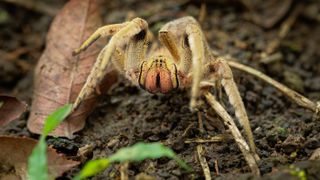
These arachnids "are called wandering spiders because they do not build webs but wander on the forest floor at night, actively hunting prey," Sewlal told Live Science in an interview conducted in 2014, before her death. They kill by both ambush and direct attack.
They spend most of their day hiding under logs or in crevices, and come out to hunt at night. They eat insects, other spiders and sometimes, small amphibians, reptiles and mice.
Research into one species of Brazilian wandering spider, Phoneutria boliviensis , revealed that these spiders eat a mix of arthropods and reptiles. DNA metabarcoding, a technique that examines the DNA and RNA in a sample, of the guts of 57 spiders identified 96 prey species, including flies, beetles, butterflies, moths, grasshoppers, locusts and crickets, according to research from the University of Tolima and the University of Ibagué in Colombia . Some of the female spiders also ate lizards and snakes.
While their bites are powerful and painful, "their bites are a means of self-defense and only done if they are provoked intentionally or by accident," Sewlal said.

In the Brazilian wandering spider, just as in most spider species, the female is larger than the male. Males approach females cautiously when attempting to mate, according to the biology department at the University of Wisconsin-La Crosse . Males perform a dance to get females' attention, and males often fight each other over the female. The female can be picky, and she often turns down many males before choosing a mating partner. Once she does pick one, the male needs to watch out; females often attack the males once copulation is finished.
The female then can store the sperm in a separate chamber from the eggs until she is ready to fertilize them. She will lay up to 1,000 eggs at a time, which are kept safe in a spun-silk egg sac.
Brazilian wandering spiders typically live for one or two years.
Brazilian wandering spiders' venom is a complex cocktail of toxins, proteins and peptides, according to the Natural History Museum in Karlsruhe, Germany. The venom affects ion channels and chemical receptors in victims' neuromuscular systems.
After a human is bitten by one of these spiders, he or she may experience initial symptoms such as severe burning pain at the site of the bite, sweating and goosebumps, Sewlal said. Within 30 minutes, symptoms become systemic and include high or low blood pressure , fast or a slow heart rate , nausea, abdominal cramping, hypothermia, vertigo, blurred vision, convulsions and excessive sweating associated with shock. People who are bitten by a Brazilian wandering spider should seek medical attention immediately.
Their venom is perhaps most famous for triggering painful and long-lasting erections . For that reason, in a 2023 study, scientists reported that they were testing the venom in humans as a potential treatment for erectile dysfunction in those for whom Viagra didn't work.
However, these bites are rare, and envenomations, or exposure to these toxins from a spider bite, are usually mild, Vetter said. For instance, a 2000 study in the journal Revista do Instituto de Medicina Tropical de São Paulo found that only 2.3% of people with bites who came to a Brazilian hospital over a 13-year period were treated with antivenom. (The other bites did not contain enough venom to require it.) Most of the bites were from the species P. nigriventer and P. keyserlingi in eastern coastal Brazil. About 4,000 bites reportedly happen each year in Brazil, but only 0.5% of those cases are severe, according to a 2018 study in the journal Clinical Toxinology in Australia, Europe, and Americas . Meanwhile, 15 deaths have been attributed to Phoneutria in Brazil since 1903, the 2018 study reported.
"It is unlikely that the spider would inject all of its venom into you, as this venom is not only needed as a means of defense but to immobilize prey," Sewlal said. "So if it did inject all of its venom, it [would] have to wait until its body manufactured more before it could hunt." That would also leave the spider vulnerable to being attacked by predators.
Furthermore, Sewlal pointed out that venom production requires a lot of a spider's resources and time. "So if the spider were to attack frequently and use up all of its venom, it [would] be safe to assume that it has a ready food supply to replace the energy and resources used. This situation does not exist in the wild."
- Learn more about Brazilian wandering spiders from the University of Wisconsin-La Crosse .
- Read about several species of Brazilian wandering spiders, including several images of the arachnids at the University of Florida .
- Find a spider in your bananas? It may or may not be a deadly species, according to the University of California, Riverside .
This article was originally published on Nov. 20, 2014.
Sign up for the Live Science daily newsletter now
Get the world’s most fascinating discoveries delivered straight to your inbox.
Jessie Szalay is a contributing writer to FSR Magazine. Prior to writing for Live Science, she was an editor at Living Social. She holds an MFA in nonfiction writing from George Mason University and a bachelor's degree in sociology from Kenyon College.
- Laura Geggel Editor
Giant, invasive Joro spiders with 6-foot webs could be poised to take over US cities, scientists warn
Diving bell spider: The only aquatic arachnid that creates a web underwater to live in
After months of sending gibberish to NASA, Voyager 1 is finally making sense again
Most Popular
- 2 NASA's downed Ingenuity helicopter has a 'last gift' for humanity — but we'll have to go to Mars to get it
- 3 Google builds an AI model that can predict future weather catastrophes
- 4 Giant, 82-foot lizard fish discovered on UK beach could be largest marine reptile ever found
- 5 What's the largest waterfall in the world?
- 2 'Uncharted territory': El Niño to flip to La Niña in what could be the hottest year on record
- 3 Rare 'porcelain gallbladder' found in 100-year-old unmarked grave at Mississippi mental asylum cemetery
- 4 'I nearly fell out of my chair': 1,800-year-old mini portrait of Alexander the Great found in a field in Denmark
- 5 NASA reveals 'glass-smooth lake of cooling lava' on surface of Jupiter's moon Io
Animal Corner
Discover the many amazing animals that live on our planet.
Brazilian Wandering Spider
The Brazilian Wandering Spider (Phoneutria fera) is an aggressive and highly venomous spider . It was first discovered in Brazil hence its name. However, this genus is known to exist elsewhere in South and Central America .
The Brazilian Wandering spider is a member of the Ctenidae family of wandering spiders.
The Brazilian Wandering spider appeared in the Guinness Book of World Records 2007 for being the most venomous animal .
In this particular genus, there are five known similar species whose members are also highly venomous. They include some of the relatively few species of spiders that present a threat to human beings.
Brazilian Wandering Spider Characteristics
The Brazilian wandering spider can grow to have a leg span of up to 4 – 5 inches. They are large hairy spindly-looking spiders who have eight eyes, two of which are large. Brazilian wandering spiders are fast-moving spiders, their legs are strong and spiny and they have distinctive red jaws which they display when angered.
The Brazilian wandering spider is not a Tarantula . Brazilian wandering spiders are not even in the same family group. Tarantulas are harmless to humans and are mostly ambush killers who wait for prey to come to them. Brazilian wandering spiders are active hunters. Brazilian wandering spiders and Tarantulas do have one thing in common, however, they do not eat bananas.
Brazilian Wandering Spider Habitat and Spider Webs
The Brazilian Wandering spider is so-called because it wanders the jungle floor, rather than residing in a lair or maintaining a web. This is another reason it is considered so dangerous. In densely populated areas, the Brazilian Wandering spider will usually search for cover and dark places to hide during daytime, leading it to hide within houses, clothes, cars, boots, boxes and log piles. This usually causes accidents when people disturb them.
The Brazilian Wandering spider is also called the ‘banana spider’ as it is occasionally found within shipments of bananas. As a result, any large spider appearing in a bunch of bananas should be treated with due care.
Brazilian Wandering Spider Diet
Adult Brazilian Wandering spiders eat crickets, other large insects, small lizards and mice. Spiderlings of this species eat flightless fruit flies and pinhead crickets.
Brazilian Wandering Spider Reproduction
All spiders produce silk, a thin, strong protein strand extruded by the spider from spinnerets most commonly found on the end of the abdomen. Many species use it to trap insects in webs, although there are many species that hunt freely such as the Brazilian Wandering spider. Silk can be used to aid in climbing, form smooth walls for burrows, build egg sacs, wrap prey and temporarily hold sperm, among other applications.
Brazilian Wandering spiders reproduce by means of eggs, which are packed into silk bundles called egg sacs. The male spider must (in most cases) make a timely departure after mating to escape before the females normal predatory instincts return.
Mature male spiders have swollen bulbs on the end of their palps for this purpose and this is a useful way to identify whether the spider is male or female. Once the sperm is inside the female spider, she stores it in a chamber and only uses it during the egg-laying process, when the eggs come into contact with the male sperm for the first time and are fertilized. The Brazilian Wandering spiders life cycle is 1 – 2 years.
Brazilian Wandering Spider Venom
Bites from the Brazilian Wandering spider may result in only a couple of painful pinpricks to full-blown envenomed. In either case, people bitten by this spider or any Ctenid should seek immediate emergency treatment as the venom is possibly life threatening.
The Phoneutria fera and Phoneutria nigriventer (two species of wandering spider) are the two most commonly implicated as the most vicious and deadly of the Phoneutria spiders.
The Phoneutria not only has a potent neurotoxin, but is reported to have one of the most excruciatingly painful envenoms of all spiders due to its high concentration of serotonin. They have the most active venom of any living spiders.
One of their members, the Brazilian Huntsman, is thought to be the most venomous spider in the world. Brazilian wandering spiders are certainly dangerous and bite more people than any other spiders.
Check out more animals that begin with the letter B
More Fascinating Animals to Learn About
About joanne spencer.
I've always been passionate about animals which led me to a career in training and behaviour. As an animal professional I'm committed to improving relationships between people and animals to bring them more happiness.

Fact Animal
Facts About Animals
Brazilian Wandering Spider Facts
Brazilian wandering spider profile.
There are more than 50,000 species of spider, and the vast majority are less dangerous than a honeybee. Almost none are aggressive, and of those with medically significant venom, only a small percentage are capable of causing death. So, on the whole, arachnophobes are just being a bit silly.
But there’s one spider that vindicates all of these fears, and few animals are as globally renowned to be a serious threat to human lives as the Brazilian Wandering Spider .
Brazilian Wandering Spiders are actually 9 species of spider in the same genus ‘Phoneutria’, one of which is found in Central America, with the rest in South America.
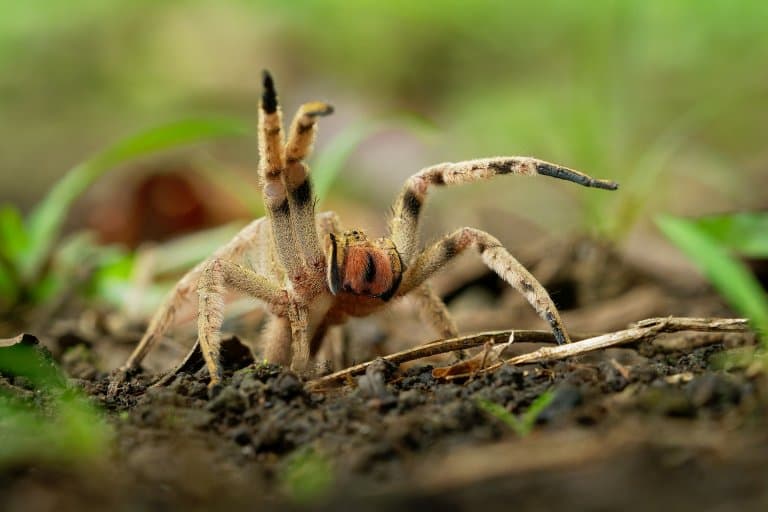
Brazilian Wandering Spider Facts Overview
These spiders are called wandering spiders because of instead of spinning a web to wait for food, or occupying a lair, they spend their night wandering in the leaf litter of the jungle floor for prey.
The sensitive hairs on its body help detect vibrations of passing prey, and it will feed on insects, lizards, frogs and any animals as large as itself.
During the day they will hide under logs, rocks, or inside termite mounds and banana plants. They will also sometimes wander into urban areas and homes, where they can come into contact with humans.
Brazilian wandering spiders are aggressive , dangerous and frightening. For once, this is an animal you should be wary of.
The females are larger, around 50% heavier than males, and produce more venom, and this might be a clue as to why their Greek name translates to “ Mudress” . These spiders will often stand and fight and have an intimidating threat display.
The potency of their venom is one of the reasons they’re so dangerous, and their ability to hide away in fruit and shoes explains why most bites are on extremities.
Interesting Brazilian Wandering Spider Facts
1. armed spiders.
In Brazilian, these are sometimes known as armed spiders, on account of their elongated front legs.
They can convey quite a bit of information with these legs, and as wandering spiders, use them to get about the forest, looking for food.
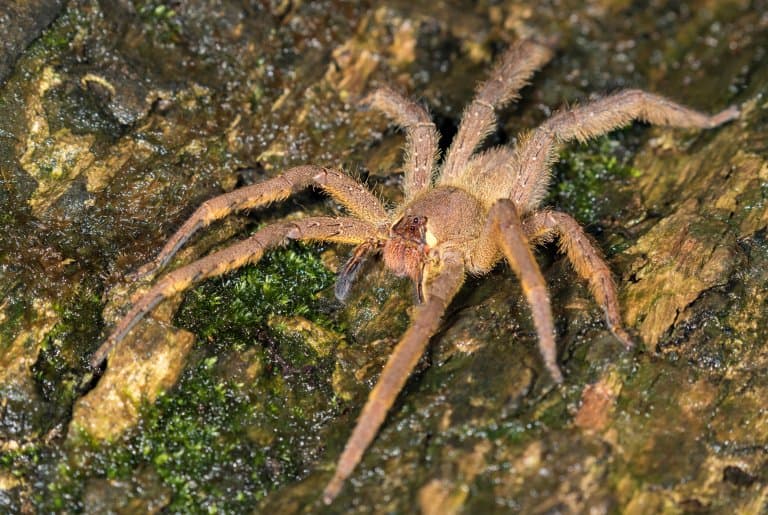
2. Banana Spiders
They’re also sometimes called ‘banana spiders’ on account of their status as a stowaway on popular fruit imported from the tropics.
This is becoming less common as stricter regulations ensure there’s less contamination of fruits, but there’s always a chance your next bunch of bananas will have a family of these spiders living inside it.
3. They have the largest venom glands of any spider
Females produce more venom than males, but both sexes have enormous venom glands. These glands are even more impressive when you consider the size of the spider is significantly less than the largest around.
The venom glands of the Brazilian Wandering Spider are over a centimetre long, and this is all housed inside the bright red chelicerae (mouth parts) which they are quick to display whenever they get upset. 1
4. They’re aggressive
These spiders can grow quite large and have long, brightly-coloured legs. Unlike most spiders, they’re known to stand their ground when threatened and are far quicker to bite than many other species.
They’ll still try to scurry away where possible, and they’re not out to get anybody.
But where most other species will flee, the wandering spiders’ aggression does make it more likely to be involved in incidents.
Most bites are on fingers and toes, a sign that they’re being stepped on or grabbed inadvertently. When the spider feels cornered, it’ll rear up on its back legs and waves its colourful arms around as a warning.
Then it’ll sway side to side, beckoning you to have a go. Anything foolhardy enough to call this bluff gets a wealth of envenomation effects. 2 3
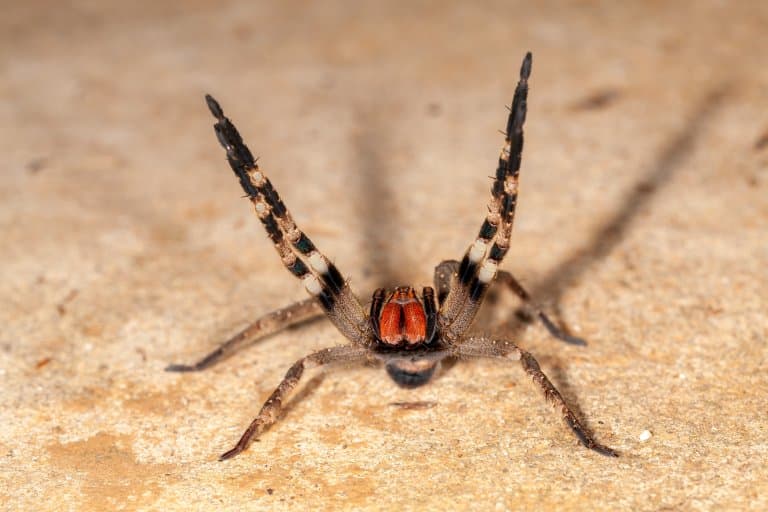
5. They give some men erections
There are ways to accomplish this with fewer side effects, but a bit from a Brazilian wandering spider does come with a certain Viagral quality.
This isn’t as fun as it might sound. Prolonged erections in this manner are likely to harm and destroy muscles and blood vessels in the penis and could cause irreparable damage.
Besides this, the assault on the central nervous system that comes with envenomation by this spider doesn’t sound worth it. 4
6. And some people die
This assault brings with it a whole host of unpleasant symptoms. Seizures, foaming at the mouth, inability to speak, collapse, and a host of other miserable experiences.
Paralysis is possible, as is cardiac shock. Blood vessels can burst in the brain, or anywhere else, and in many cases, this can be enough to kill a person.
This spider has one of the most potent venoms of all, and there are multiple legitimate records of death as a result of bites.
7. But they’re rarely fatal
While the Brazilian wandering spider is potentially one of the most dangerous spiders in the world, there is some evidence to suggest it gives a dry bite, defensively.
This means that despite exceptionally toxic venom, the amount actually injected is less than some of the other contenders, and this is what makes it typically less lethal than the Australian funnel webs.
These spiders are classified as Dangerous Wild Animals and would therefore require a special permit to keep. Bites from wandering spiders are common in South America, but antivenom is often readily available, and they rarely result in death.
In most cases, lethal bites are cases of a very young or very old victim, and few people of healthy age are killed. 5
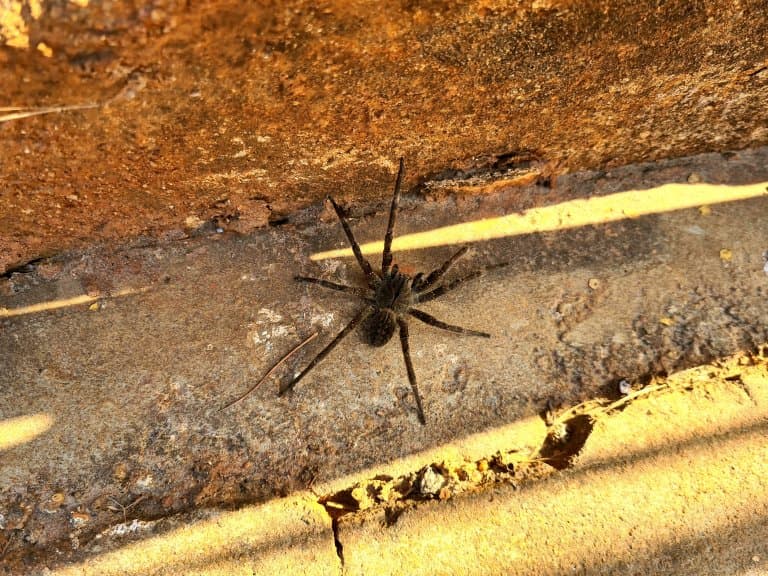
8. They do invade the UK sometimes
These unquestionably scary spiders show up in supermarkets in the UK on occasion, having hitched a ride on banana shipments.
On more than one occasion they’ve made their way into shoppers’ homes, but it doesn’t appear that there are any cases of them biting people as a result.
These spiders aren’t suited for temperate climates and don’t survive Winter, so there’s no risk of them multiplying.
Brazilian Wandering Spider Fact-File Summary
Scientific classification, fact sources & references.
- PeerJ. (2017), “ Dimensions of venom gland of largest venom glands in all spiders ”, Bio Numbers.
- Dave Clarke (2010), “ Venomous spider found in Waitrose shopping ‘beautiful but aggressive’” , The Guardian.
- “ Phoneutria Perty (Arachnida: Araneae: Ctenidae) ”, UF-IFAS University of Florida
- Kátia R.M. Leite (2012), “ Phoneutria nigriventer spider toxin Tx2-6 causes priapism and death: A histopathological investigation in mice ”, Science Direct.
- “ Brazilian wandering spiders: Bites & other facts ”, Live Science.

Wellcome to SpiderZoon
- Spider Facts
Brazilian Wandering Spider: Size, Bite, Diet and Other Facts
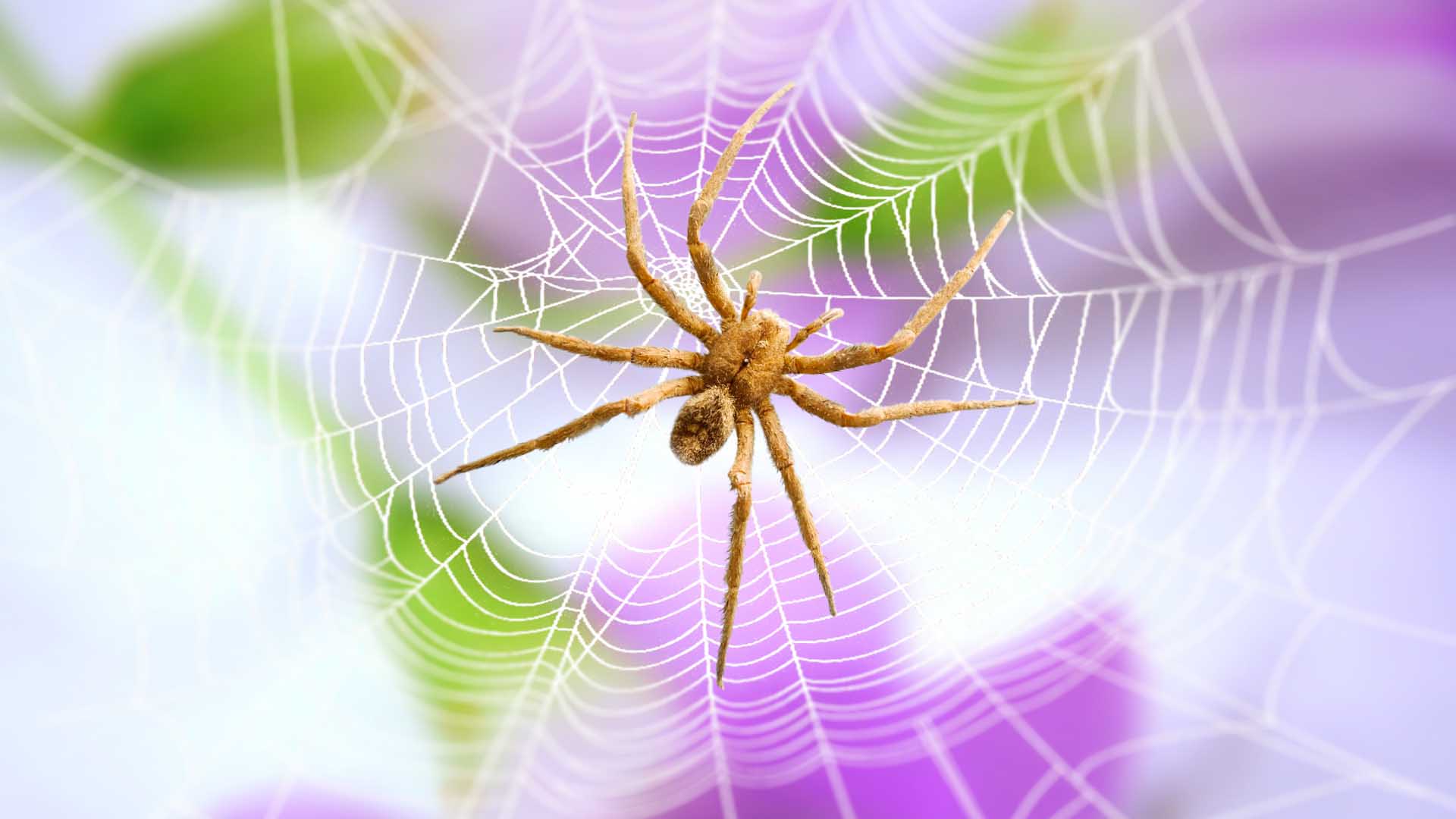
The Brazilian Wandering Spider is a venomous arachnid with a fearsome reputation. This South American rainforest dweller packs a powerful punch, but don’t let its nickname “banana spider” fool you – they’re active hunters, not web-spinners. Despite their size and venom, bites are uncommon as they’re typically shy.
The Brazilian Wandering Spider has garnered significant attention due to its potent venom, which makes it one of the world’s most venomous spiders. Understanding its biology and behavior is crucial for both scientific research and public safety.
Table of Contents
Scientific classification
The Brazilian Wandering Spider belongs to the family Ctenidae within the order Araneae. Its scientific classification is as follows:
- Kingdom: Animalia
- Phylum: Arthropoda
- Class: Arachnida
- Order: Araneae
- Family: Ctenidae
- Genus: Phoneutria
The Brazilian Wandering Spider goes by various common names, including “armed spider,” “banana spider,” and “wandering spider.” Synonyms for this species may include Ctenus , which was formerly used for some Phoneutria species.
Distribution and habitat
Distribution:
- South American: Found throughout most of South America east of the Andes mountains, including countries like Brazil (their namesake), Argentina, Paraguay, and up into northern regions.
- Central American Touch: A few species even reach southern Central America.
- Rainforest Dwellers: Primarily found in the lush rainforests of South America.
- Not Picky Places: They can also adapt to other habitats like the Atlantic Forest and even some urban areas.
- Daytime Hideouts: While they wander at night, they seek shelter during the day in places like termite mounds, under rocks, or even (unintentionally) in bananas!
Physical Characteristics
size and weight.
The Brazilian wandering spider is a creepy crawly giant. Their bodies can grow up to 2 inches (5 centimeters) long, but that’s not the scary part. Their legs can span a whopping 7 inches (18 cm), making them look even bigger. They are one of the biggest true spiders by body weight and size.
Despite their impressive leg span, Brazilian wandering spiders are relatively light. They only weigh around 6 grams, which is about the same as two pennies. While they might look imposing, they’re not the heaviest arachnids around.
Coloration and markings
These spiders exhibit a range of colors, including brown, black, and sometimes reddish hues. They often have distinctive markings on their bodies, which can vary between species. These markings may include stripes or patterns that serve as a key identification feature.
Notable features
One of the most notable features of the Brazilian Wandering Spider is its elongated, robust body and long, agile legs. They have sharp fangs, which they use to inject venom into their prey or in self-defense.
Sexual dimorphism
Sexual dimorphism is evident in this species. Females are larger and bulkier than males, while males have longer, more slender legs. Additionally, males possess specialized structures known as pedipalps, which are used during mating.
In the following sections of this article, we will delve deeper into the behavior, venom, and ecological role of the Brazilian Wandering Spider, shedding light on why this species has both fascinated and instilled fear in those who encounter it.
Behavior and Ecology
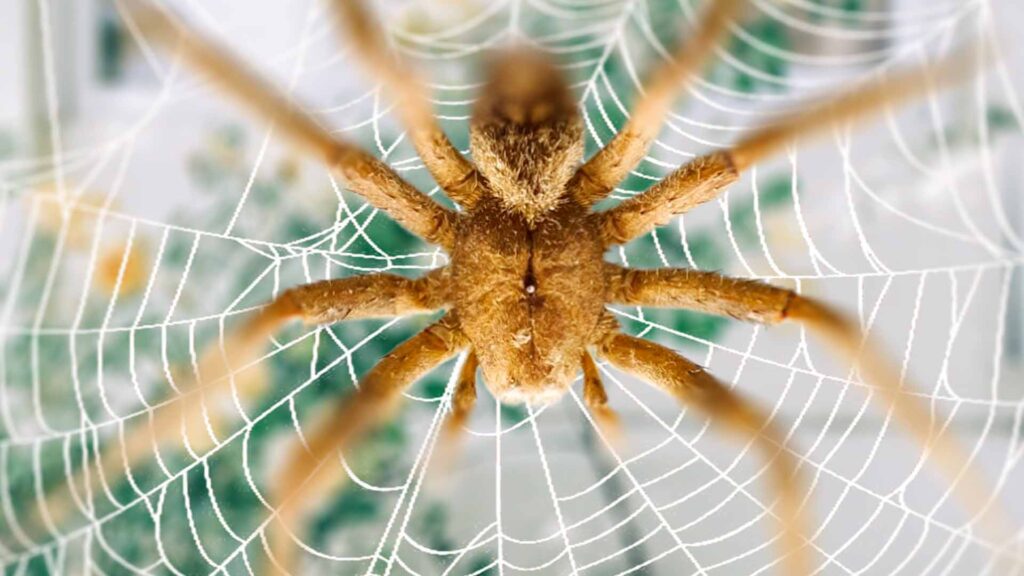
Nocturnal habits
Brazilian Wandering Spiders are primarily nocturnal creatures. They are most active during the night, venturing out of their daytime hiding places to hunt for prey and engage in mating activities. Their nighttime activity allows them to avoid predators and reduce the risk of desiccation in the hot tropical sun.
Hunting and feeding behavior
These spiders are agile hunters and primarily feed on insects, small vertebrates, and other arachnids. They do not build webs to capture prey but instead rely on their excellent senses, including acute vision and touch, to locate and stalk their victims. They often wander in search of food and are known for their swift and lethal strikes. Once they subdue their prey, they inject venom to immobilize it before feeding.
Brazilian Wandering Spiders (Phoneutria) are active hunters and have distinctive feeding behaviors. Here’s an overview of their feeding habits:
- Active Predators: Brazilian Wandering Spiders are not web-builders like many other spider species. Instead, they are active predators. They actively roam their environment in search of prey rather than waiting for insects to stumble into a web.
- Hunting Strategy: When hunting, these spiders use their excellent senses, including acute vision and touch, to locate potential prey. They are known for their agility and speed, which they use to stalk and capture their victims. They have sharp fangs, which they use to deliver a venomous bite to immobilize their prey.
- Diet: Their diet consists primarily of insects and other arthropods, but they are opportunistic feeders and may consume a variety of small creatures, including small vertebrates such as frogs and lizards when the opportunity arises.
- Venom Use: Brazilian Wandering Spiders inject venom into their prey to immobilize and partially digest it. Their venom contains neurotoxins that affect the nervous system of their victims. Once the prey is incapacitated, the spider can feed on it at its leisure.
- Feeding Process: After subduing their prey with a venomous bite, the spider uses its chelicerae (fangs) to break down the prey’s tissues. The venom also helps in predigestion, turning the prey’s insides into a semi-liquid form that the spider can ingest. They can consume both the internal fluids and solid parts of their prey.
- Frequency of Feeding: The frequency of feeding can vary depending on factors such as the availability of prey and the spider’s size. Generally, they need to feed periodically to sustain their energy and growth. Spiderlings may require more frequent meals to support their rapid growth, while adults can go longer periods between meals.
Overall, the Brazilian Wandering Spider’s feeding strategy is well-suited for their active and wandering lifestyle, allowing them to efficiently capture and consume a variety of prey in their natural habitat.
Role in the ecosystem
The Brazilian Wandering Spider plays a vital role in controlling insect populations within its habitat. By preying on a variety of insects and other small creatures, they help maintain ecological balance. Additionally, their presence in the rainforest ecosystem contributes to the overall biodiversity and food web.
Mating and reproduction
Mating in Brazilian Wandering Spiders is a complex and potentially dangerous process. Male spiders must carefully approach and court a receptive female to avoid being mistaken for prey. They use specialized pedipalps to transfer sperm to the female’s reproductive organs. After successful mating, females lay egg sacs containing hundreds of eggs. They guard these sacs and ensure the survival of their offspring until they hatch.
Lifespan and growth
The lifespan of Brazilian Wandering Spiders varies between males and females. Males generally have a shorter lifespan, typically living for a few months to a year after reaching maturity. Females, on the other hand, can live for several years. The growth of these spiders involves a series of molts, during which they shed their exoskeletons to accommodate their increasing size. Molting is a vulnerable period in their lives as their new exoskeleton is initially soft and requires time to harden.
Venom and Envenomation
Composition of venom.
The venom of Brazilian Wandering Spiders is a complex mixture of neurotoxins, cytotoxins, and other enzymes. One of the most significant components is a neurotoxin called PhTx3, which targets the nervous system of their prey.
Toxicity and effects on humans
The venom of these spiders is highly potent and can be lethal to their prey. In humans, envenomation can cause a range of symptoms, including intense pain, muscle cramps, fever, nausea, and in severe cases, paralysis and death. It’s important to note that while their venom is potent, actual fatalities from Brazilian Wandering Spider bites are rare due to the availability of medical treatment.
First aid and medical treatment
In the event of a Brazilian Wandering Spider bite, immediate medical attention is crucial. First aid measures may include cleaning the wound and applying ice to reduce pain and swelling. However, the primary treatment involves antivenom, which can counteract the effects of the spider’s venom.
Cases of envenomation and fatalities
Although fatalities from Brazilian Wandering Spider bites are uncommon, there have been documented cases of severe envenomation, especially in regions where medical treatment is not readily available. These spiders are generally non-aggressive and will bite humans only in self-defense when provoked, or if they feel cornered.
Understanding the behavior, ecology, and venomous nature of the Brazilian Wandering Spider is crucial for both scientific research and public awareness, helping to minimize the risk of envenomation and promote coexistence with this remarkable but potentially dangerous arachnid.
Brazilian wandering spider life cycle
The Brazilian wandering spider has a fascinating life cycle that revolves around hunting and motherhood. Here’s a breakdown:
- Egg Haven: After mating, the female lays hundreds, sometimes even a thousand, eggs in a silken sac. This becomes their protected nursery.
- Tiny Terrors: Hatching from the eggs emerge translucent spiderlings called larvae.
- Nymph Stage: The larvae molt a few times, transforming into nymphs. Think of them as mini-adults but without the ability to reproduce yet.
- Shedding for Size: As nymphs grow, they undergo multiple molts, shedding their outer shell to accommodate their larger bodies.
- Ready to Roam: After the final molt, the spider emerges as a full-fledged adult, complete with reproductive organs. Now, they can join the wandering lifestyle and continue the cycle.
The life cycle begins when a female Brazilian Wandering Spider lays her eggs. She typically creates an egg sac made of silk and deposits it in a concealed location, such as a tree hollow or leaf litter. Inside the sac, she may lay hundreds of eggs. The female guards the egg sac and ensures its protection until the spiderlings hatch. The duration of the egg stage varies depending on environmental conditions but generally lasts for a few weeks.
Spiderling Stage
After the incubation period, spiderlings (young spiders) emerge from the egg sac. They are extremely vulnerable at this stage and rely on their mother’s protection and guidance. Spiderlings are miniature versions of adult spiders but lack the full coloration and size. They disperse from the nest once they have molted and are capable of hunting on their own. During this stage, they grow rapidly by molting, shedding their exoskeletons to accommodate their increasing size.
Juvenile Stage
As spiderlings continue to molt and grow, they progress into the juvenile stage. During this phase, their coloration becomes more distinct, and they start to develop the characteristic features of adult Brazilian Wandering Spiders. They become increasingly independent and begin to exhibit hunting behaviors. The duration of the juvenile stage can vary but often lasts several months.
Sub-Adult Stage
The sub-adult stage is an intermediate phase between juvenile and adult. At this point, the spiders are closer in size and appearance to adults but have not yet reached sexual maturity. They continue to molt, with the frequency of molting gradually decreasing as they approach adulthood. Sub-adult spiders may exhibit more territorial behaviors as they compete for resources and prepare for eventual mating.
Adult Stage
Upon reaching sexual maturity, Brazilian Wandering Spiders enter the adult stage. This is when they are fully developed and capable of reproduction. Females are larger and bulkier than males, and males possess specialized structures called pedipalps, which they use during mating. Adult spiders engage in mating activities, and females lay eggs to continue the life cycle. Adult Brazilian Wandering Spiders can live for several years, with females typically having longer lifespans than males.
Understanding the life cycle of these spiders is essential for studying their behavior, reproductive biology, and population dynamics. It also provides insights into their adaptation strategies in the complex ecosystems of South and Central America.
Brazilian Wandering Spider Bite
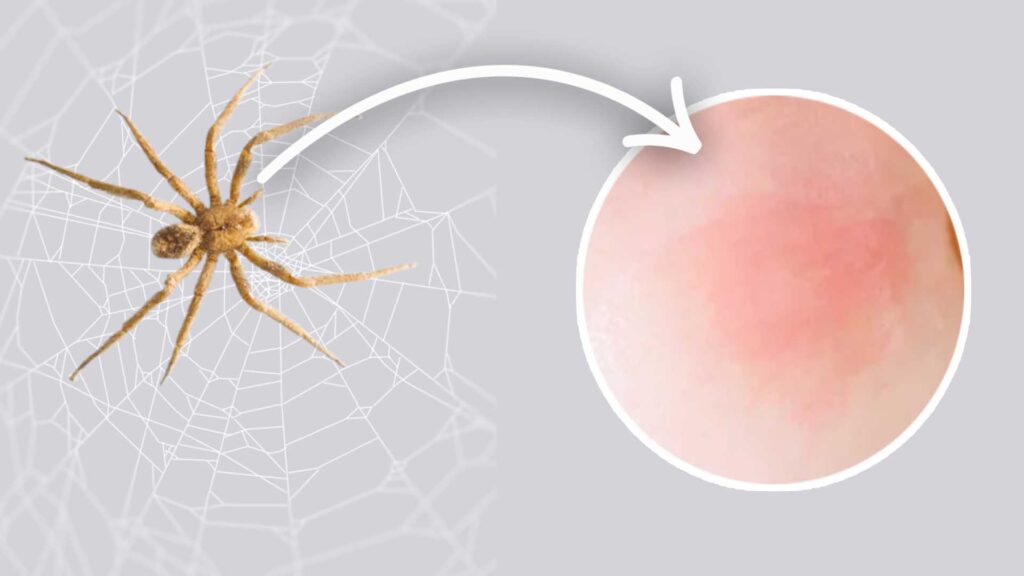
Brazilian Wandering Spiders are known for their potent venom and, occasionally, their bites on humans. While bites are relatively rare due to the spider’s non-aggressive nature, understanding the consequences of a bite is crucial for public safety.
Studying Brazilian Wandering Spider bites is of great interest for several reasons. It helps healthcare professionals provide appropriate medical treatment, raises awareness among communities in spider habitats, and contributes to our understanding of venomous arachnid envenomations.
The venom of Brazilian Wandering Spiders is a complex mixture of neurotoxins, cytotoxins, and enzymes. It contains various components, including PhTx3, which is a potent neurotoxin affecting the nervous system.
Brazilian Wandering Spider bites can have a range of effects on the human body, including intense pain, muscle cramps, fever, nausea, and in severe cases, paralysis. The severity of the symptoms depends on factors such as the amount of venom injected and the individual’s sensitivity to the venom. There are several types of spider bites .
Symptoms of a Brazilian Wandering Spider Bite
Local symptoms
- Intense pain
- Itching or burning sensation
- Formation of blisters or lesions
Systemic symptoms
- Muscle cramps and spasms
- Abdominal pain
- Nausea and vomiting
- Elevated heart rate
- Hypertension (high blood pressure)
- Respiratory distress
Severity and variations
The severity of Brazilian Wandering Spider bite symptoms can vary widely. In some cases, symptoms may be mild and resolve on their own, while in severe envenomations, life-threatening complications can occur. Individual reactions to the venom can also vary, making it challenging to predict the exact outcome of a bite.
First Aid and Immediate Response
Steps to take after a bite
Immediate response to a Brazilian Wandering Spider bite should include:
- – Washing the bite area with soap and water.
- – Applying a clean, cool compress to reduce pain and swelling.
- – Immobilizing the affected limb or area.
- – Keeping the bite victim calm to prevent an elevated heart rate.
Do’s and don’ts in case of a bite
- – Seek medical attention promptly.
- – Take note of the spider’s appearance (if possible) to aid identification.
- – Keep the bite victim still and calm to reduce the spread of venom.
- – Do not try to suck out venom or make incisions at the bite site.
- – Avoid applying tourniquets.
- – Don’t use ice directly on the skin as it can worsen tissue damage.
Seeking medical attention
Medical attention is essential after a Brazilian Wandering Spider bite, even if symptoms appear mild initially. Antivenom is available and can be administered to counteract the effects of the venom. Medical professionals can also manage symptoms and monitor for potential complications.
Complications and Long-Term Effects
Potential complications
Complications from Brazilian Wandering Spider bites can include:
- – Severe muscle spasms
- – Respiratory distress
- – Cardiovascular issues
- – Kidney failure (rare)
- – Allergic reactions to antivenom
Long-term consequences
Long-term consequences of a bite can vary depending on the severity and medical treatment received. Some individuals may experience lingering pain, muscle weakness, or psychological trauma following a severe envenomation.
Recovery and rehabilitation
Recovery from a Brazilian Wandering Spider bite typically involves medical treatment, rehabilitation for muscle and nerve damage, and psychological support for individuals affected by the experience. Rehabilitation may include physical therapy to regain muscle strength and function. Prompt medical attention and appropriate care are crucial for minimizing long-term effects and complications.
Facts of Brazilian Wanding Spider
Here are 10 creepy crawly facts about the Brazilian Wandering Spider:
- Big and Hairy: These spiders are giants! Their bodies can grow up to 2 inches (5 centimeters) long, with a leg span of up to 7 inches (18 cm). They are covered in hairs, making them appear even bigger.
- Wanderlust: They are aptly named – Brazilian wandering spiders don’t spin webs. Instead, they wander the forest floor at night in search of prey.
- Venomous Bite: Their venom is considered one of the most potent among spiders. A bite can cause severe pain, swelling, sweating, nausea, and even priapism in males. Thankfully, bites are rare as they are typically shy and defensive.
- Not So Fond of Bananas: While sometimes called ‘banana spiders,’ they are not typically found in bananas. They might, however, take shelter in them during transport, which is how they might end up in a faraway land.
- Rainforest Resident: These spiders are native to the rainforests of South America, particularly in Brazil.
- Fearsome Feasters: They’re active hunters and will eat almost anything they can overpower, including insects, lizards, frogs, and even small rodents.
- Mom’s the Word: Female Brazilian wandering spiders are dedicated mothers. They lay hundreds of eggs in a silken sac and fiercely guard them until they hatch.
- Multiple Molts: Like all spiders, Brazilian wandering spiders grow through molting. They shed their exoskeleton multiple times as they grow into adults.
- Mating Dance: Male Brazilian wandering spiders perform a elaborate mating dance to attract a female.
- Medicinal Potential: Despite their scary reputation, the venom of the Brazilian wandering spider is being studied for its potential use in treating erectile dysfunction.
What happens if a Brazilian Wandering Spider bites a man?
A Brazilian Wandering Spider bite on a man can cause a range of symptoms, some severe:
- Pain: The bite is known for causing intense, localized pain at the site.
- Autonomic effects: Sweating, nausea, and increased heart rate are common.
- Priapism: In some cases, males may experience a prolonged and painful erection (priapism). This is due to a component in the venom.
- Muscle paralysis: Severe bites can lead to muscle paralysis, which can affect breathing in rare cases.
However, it’s important to remember:
- Bites are uncommon as these spiders are typically shy and defensive.
- Antivenom is available and effective in treating bites.
If bitten, seek medical attention immediately. Early treatment can help prevent complications and ensure a full recovery.
How poisonous is a Brazilian Wandering Spider?
Brazilian Wandering Spider packs a nasty venomous punch, considered one of the strongest among spiders. Bites are rare though, as they’re shy and prefer to escape trouble.
What is the world’s deadliest spider?
The term “deadliest” can be subjective and depends on how one defines it (e.g., based on venom potency or human fatalities). However, the Brazilian Wandering Spider (Phoneutria) is often considered one of the most venomous spiders in the world. Another spider often mentioned in discussions of venom toxicity is the Sydney Funnel-web Spider (Atrax robustus and Atrax formosus), found in Australia. These spiders are known for their potent venom and have caused fatalities in the past.
Leave a Reply Cancel reply
Your email address will not be published. Required fields are marked *
Save my name, email, and website in this browser for the next time I comment.
Related Article
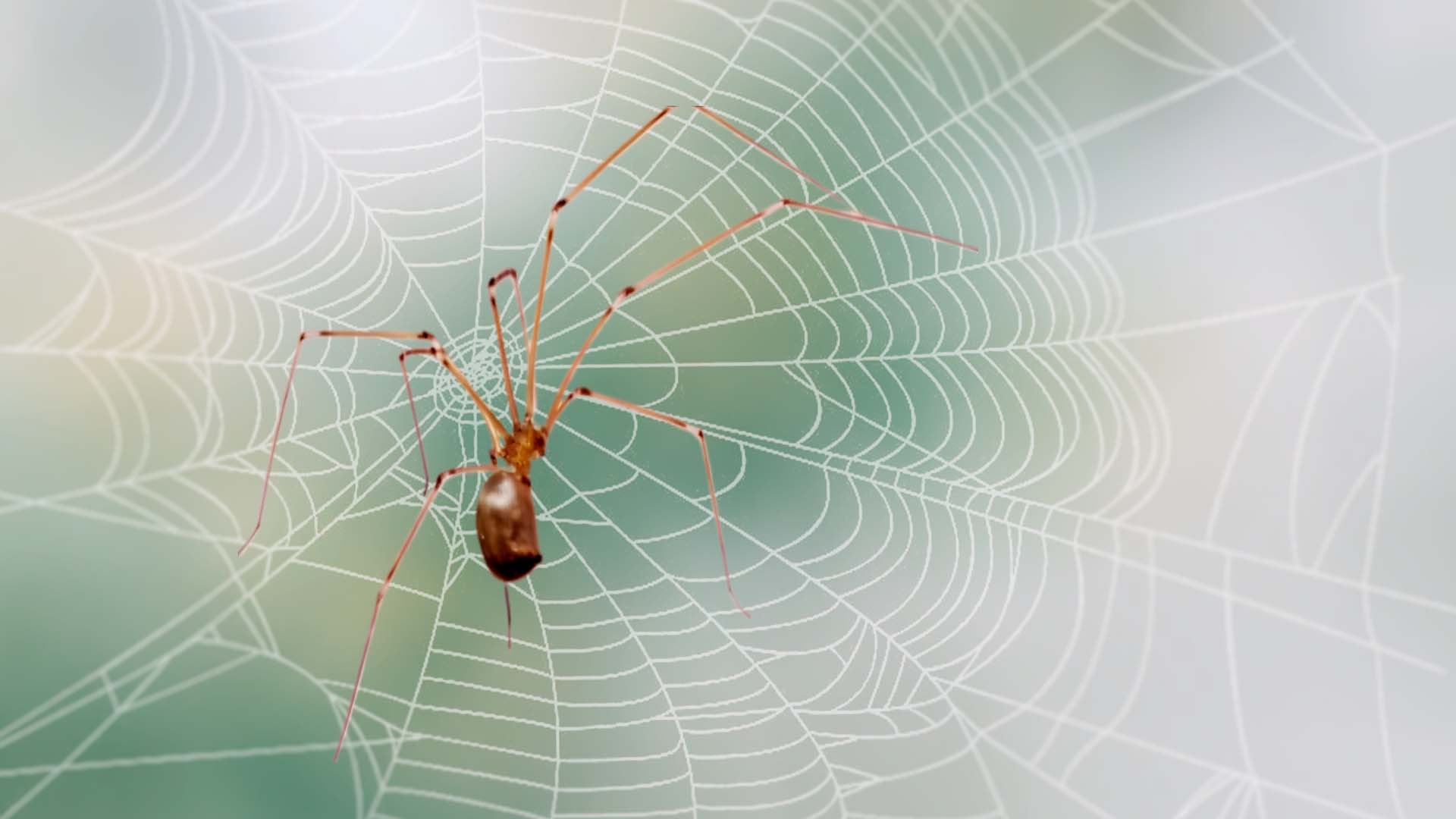
Can a Daddy Long Legs Bite Kill You (You Need to Know)
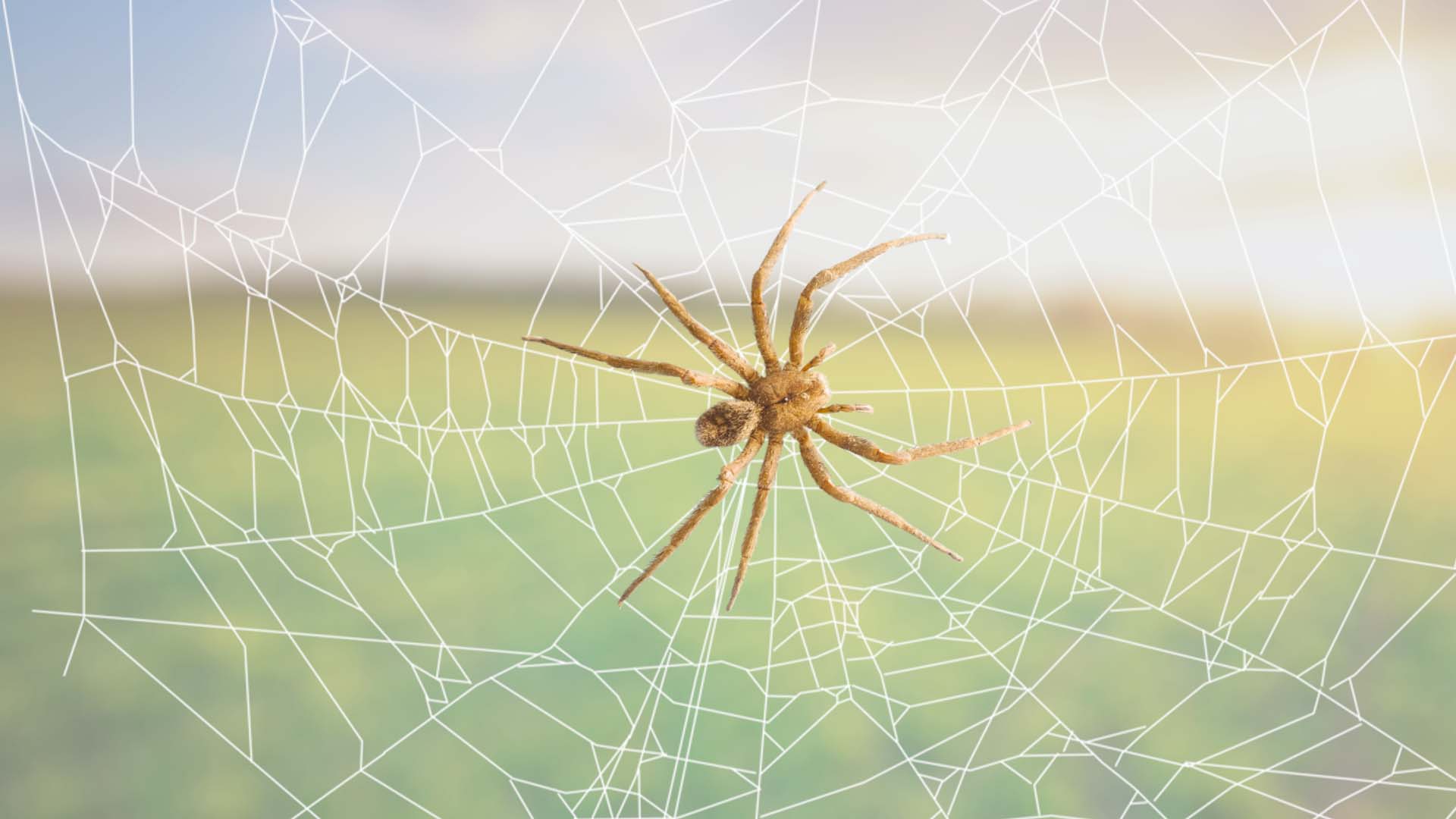
7 Facts About The Brazilian Wandering Spider
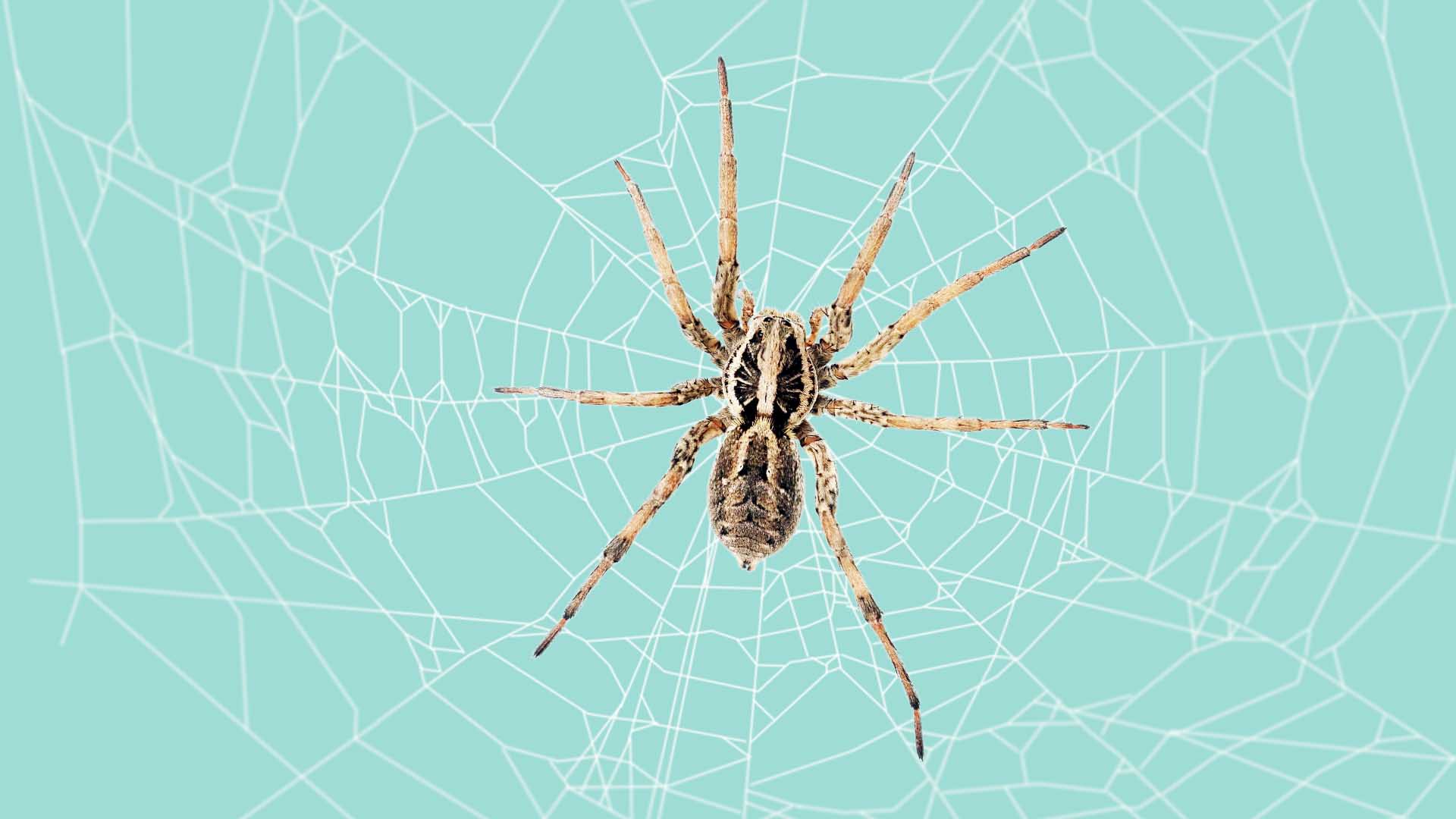
Are Wolf Spiders Poisonous for Humans, Cats or Dogs? (Explained)
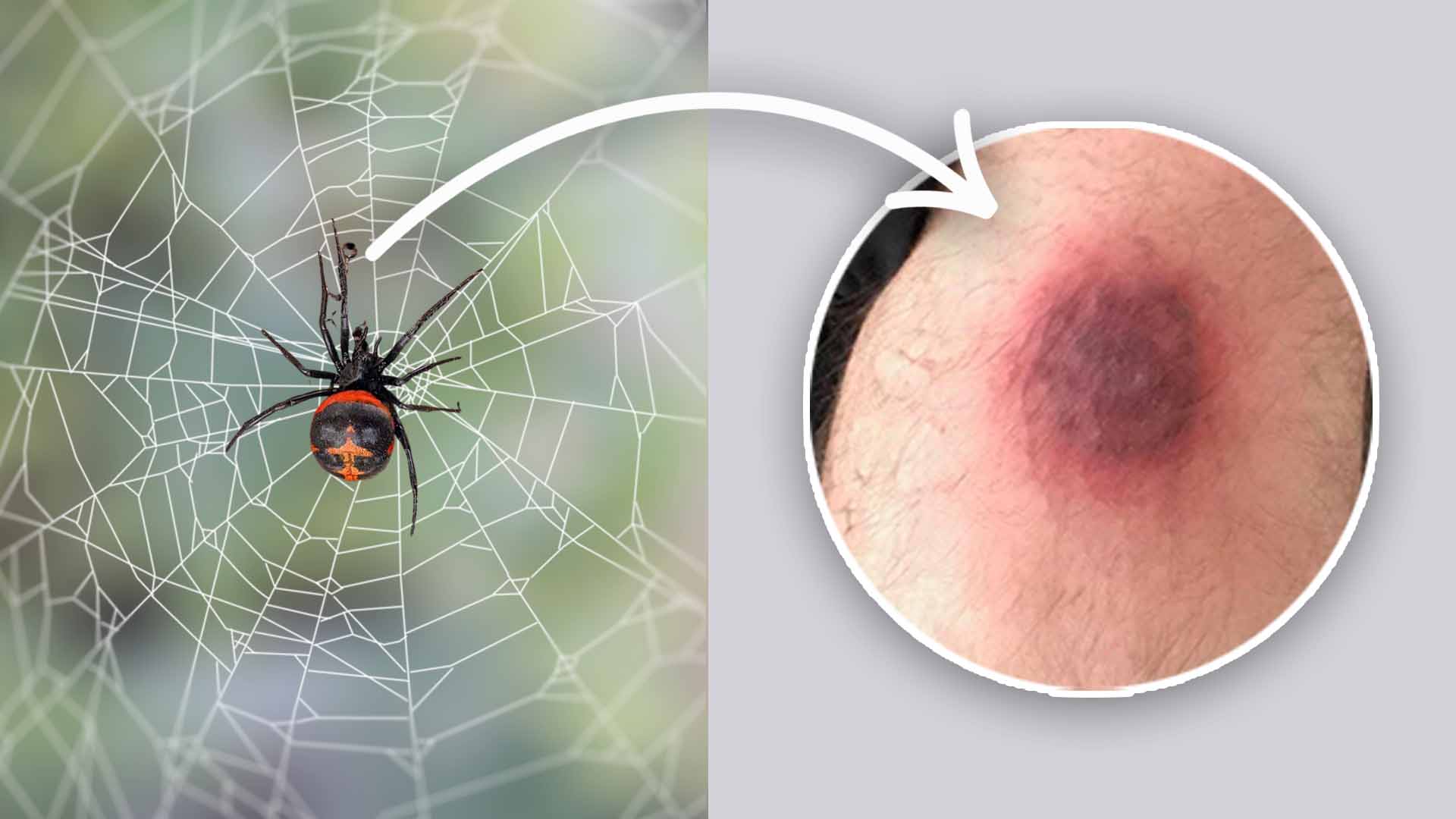
When To Worry About A Spider Bite? (Need to Know)

Understanding the Wandering Spider: Quick Essential Facts
Wandering spiders are a group of venomous arachnids found primarily in South America.
Among these, the Brazilian wandering spider is particularly known for its potent venom and unique behavior. They are often referred to as “banana spiders” due to their frequent encounters with humans in banana plantations.
As a reader, you might be interested in learning more about these fascinating creatures, including their habitat, hunting techniques, and the effects of their venom.
In this article, we will delve into the world of wandering spiders and provide you with all the essential information to satisfy your curiosity.

Scientific Classification and Naming
The wandering spider belongs to the genus Phoneutria , which is a part of the Ctenidae family.
These spiders are known for their potent venom and aggressive behavior. Here is the scientific classification of the wandering spider:
- Kingdom: Animalia
- Phylum: Arthropoda
- Subphylum: Chelicerata
- Class: Arachnida
- Order: Araneae
- Family: Ctenidae
- Genus: Phoneutria
Within the genus Phoneutria, two species are particularly noteworthy: Phoneutria fera and Phoneutria nigriventer, also known as P. nigriventer . These spiders are primarily found in South America and other tropical regions.
Phoneutria fera and P. nigriventer differ in some aspects. Let’s compare their features using a table:
Some key characteristics of the wandering spiders in the genus Phoneutria include:
- Potent venom that can be dangerous to humans
- Nocturnal hunters and are active at night
- Equipped with long, spiny legs for capturing prey
- Aggressive defenders of their territory
By understanding the scientific classification and differences between Phoneutria species, you can better appreciate the diversity and fascinating biology of these wandering spiders.
Identification and Appearance
Color and size.
The wandering spider, also known as the banana spider, has a distinctive appearance that can help you easily identify it in the wild.
They usually have a combination of hairy brown and black colors on their body. Their size can vary, but they are generally considered large spiders. Their size can range from 1 to 2 inches in body length.

When it comes to wandering spider’s leg span, these creatures can have an impressive reach. Their leg span can extend up to 5-6 inches.
Some key characteristics of a wandering spider’s legs include:
Habitat and Distribution
Wandering Spiders are known to inhabit various environments, including rainforests and tropical forests.
These spiders can adapt to different habitats based on their needs and availability of food sources. They prefer warm and humid places, as these conditions suit their growth and reproduction.
Geographical Coverage
Wandering spiders are found in Central and South America .
They live in forests from Costa Rica to Argentina, including Colombia, Venezuela, The Guianas, Ecuador, Peru, Bolivia, Brazil, Paraguay, and Northern Argentina.
They may also be present in some parts of the United States, particularly in the northern part of southern America.
However, they don’t inhabit countries like Australia. In summary, the Wandering Spider is mostly prevalent in the following areas:
- South America
- Central America
- Southern parts of the United States
Types of Wandering Spiders
Here’s a brief description of the major types of wandering spiders.
Brazilian wandering spiders
Also known as armed or banana spiders, these spiders are nocturnal and don’t make webs.
They are known to have been transported outside of South America in banana shipments.
Phoneutria nigriventer
These spiders contain neurotoxins that can cause cerebral changes and breakdown of the blood-brain barrier .
Their venom is medically significant and has been used in manufacturing drugs. Their bites may be fatal to children.
Ctenus captiosus
Also known as the Florida false wolf spider or tropical wolf spider, this species is found in the United States.
Some species of these spiders are large and scary-looking, but they’re only mildly venomous. Their venom is comparable to a bee sting.
Other types of wandering spiders include: Acantheis, Acanthoctenus, Africactenus, and Afroneutria.

Behavior and Diet
Aggression level.
Wandering spiders, as their name suggests, are known for their aggressive behavior .
While they won’t attack without provocation, if they feel threatened, they will not hesitate to defend themselves.
This is especially true during mating season.
Prey and Predators
In their natural habitat, wandering spiders primarily feed on insects and small vertebrates, such as:
- Insects like ants and moths
- Small amphibians
This diverse diet allows them to thrive in various ecosystems.
However, they are not top predators, as their natural predators include larger birds, mammals, and other spiders.
Nocturnal Activities
Wandering spiders are nocturnal creatures , which means they are active during the night.
During the day, they remain hidden in their retreats, often made from rolled-up leaves or small crevices.
At night, they leave their hiding spots to search for prey using their strong hunting skills.

Venom and Its Effects
Composition of venom.
The venom of the wandering spider is a complex mixture containing several toxic components.
Its main component is a potent neurotoxin, which can have severe effects on your nervous system 1 . Here’s a brief overview of its composition:
- Neurotoxins
Symptoms and Severity
A wandering spider’s venomous bite can cause a wide range of symptoms, depending on the severity of envenomation. These symptoms may include 2 :
- Mild to moderate pain
- Redness and swelling at the bite site
- Irregular heartbeat
- Difficulty breathing
- Blurred vision
- High blood pressure
Some severe cases may result in life-threatening complications, such as respiratory failure or even death 2 .
Medical Treatment and Antivenom
If bitten by a wandering spider, it’s crucial to seek immediate medical attention. Treatment often involves the following steps:
- Cleaning and immobilizing the affected area
- Monitoring and managing the symptoms
- Administering antivenom if it’s available and appropriate, depending on the severity of envenomation 3
Antivenom is specific to the venom of the wandering spider and can help neutralize its effects.
However, the availability of antivenom may be limited in some regions 3 .
Always remember that prevention is better than cure: learning how to identify and avoid wandering spiders is the best way to stay safe.

Reproduction and Mating
Mating ritual.
When it’s time for reproduction, the wandering spider undergoes an intriguing mating ritual.
The male spider performs a dance to attract the female by displaying his brightly colored legs and vibrating his body.
During the process, the male also produces a sperm web and transfers his sperm to the female’s reproductive organs using his pedipalps.
Egg Sacs and Offspring
After the mating process, the female wandering spider will create an egg sac to protect her eggs.
The sac consists of silk and can hold hundreds of eggs. She then attaches it to a safe hiding place, usually against a protective surface or within a secure web.
The female often guards the egg sac to ensure the protection of her offspring until they hatch.
Once the spiderlings hatch, they are known to be highly independent.
They disperse quickly and start their own journey, fending for themselves soon after emerging from the egg sac.
As they grow, they’ll go through a series of molts before reaching adulthood and beginning their own reproductive cycle.
Danger and Defense Mechanisms
The Wandering Spider is known to be one of the most dangerous spiders in the world.
Although they can potentially kill humans, fatalities are rare due to their reluctance to bite.
Oddly enough, their venom can cause an involuntary erection in men, alongside other painful symptoms.
Here are some ways the Wandering Spider protects itself and displays its dangerous nature:
- Fangs : These spiders are equipped with strong, sharp fangs that can easily pierce human skin, allowing them to inject their venom with ease.
- Venom : Their venom is potent and can cause severe pain, inflammation, and other adverse effects. In rare cases, it can even lead to death.
While interacting with Wandering Spiders, be cautious and observe them from a safe distance.
Knowing their defense mechanisms will help you respect their space and avoid any unpleasant encounters.
Remember, it’s essential to be informed and aware when dealing with these fascinating, yet dangerous creatures.

Comparison with Other Dangerous Spiders
Comparison to black widow.
The black widow spider is notorious for its potent venom, but the wandering spider has a stronger venom overall.
Both spiders are capable of causing severe symptoms, but the black widow’s venom is primarily neurotoxic, affecting your nervous system.
In contrast, the wandering spider’s venom can cause both neurotoxic and cytotoxic effects, potentially damaging your nerves and cells.
- Potent neurotoxic venom
- Red hourglass marking
- Stronger venom (neurotoxic and cytotoxic)
- No distinct marking
Comparison to Brown Recluse
The brown recluse spider is known for its necrotic venom that can lead to tissue damage and sometimes requires medical intervention.
While both the brown recluse and wandering spider can produce venomous bites, wandering spiders are considered more dangerous due to the potency of their venom and the severity of their bite symptoms.
- Necrotic venom
- Dark violin-shaped marking
Comparison to Wolf Spider
Wolf spiders are frequently mistaken for more dangerous spiders due to their size and appearance.
Although they can bite, their venom is not particularly potent and generally only causes mild itching, redness, and swelling.
In comparison, the wandering spider’s venom is far more dangerous, and its bite can result in serious symptoms, requiring immediate medical attention.
- Large and hairy
- Smoother appearance
Comparison to Sydney Funnel-Web Spider
The Sydney funnel-web spider is another highly venomous spider known for its potentially lethal bites.
While both spiders possess powerful venom, the wandering spider has a broader range of symptoms due to the combination of neurotoxic and cytotoxic effects.
In conclusion, wandering spiders are more dangerous than wolf spiders but their venom’s effects are more varied compared to black widows, brown recluses, and Sydney funnel-web spiders.
Be cautious around these spiders and seek medical help if bitten.
Interesting Facts and Guinness World Records
The Wandering Spider, also known as the Brazilian Wandering Spider, is a fascinating creature that has caught the attention of many.
They belong to the genus Phoneutria , which means “murderess” in Greek, giving you an idea of their potency. Let’s explore some interesting facts about this spider and its place in the Guinness World Records.

First, you might be curious about their venom. The Wandering Spider is known for having one of the most potent venoms among spiders.
In fact, it holds the Guinness World Record for the most venomous spider. Their venom contains a potent neurotoxin that can cause severe symptoms, including difficulty breathing, high blood pressure, and intense pain.
Apart from their venom, their behavior is also quite intriguing. These spiders are called “wandering” because they are known for actively hunting their prey rather than spinning webs to catch them.
They are mostly nocturnal creatures and, during the day, can be found hiding in logs or dark crevices.
Here are a few more notable characteristics of the Wandering Spider:
- Females are larger than males, with a body length of up to 1.6 inches (4 cm).
- They have eight eyes, arranged in two rows, which help them in hunting.
- The Wandering Spider is primarily found in Central and South America, particularly in Brazil.
- They are known to show aggression when threatened.
While the Wandering Spider is a marvel of the arachnid world, it’s essential to keep a safe distance from them due to their venomous nature.
However, their unique characteristics and record-breaking venom potency make them a fascinating subject for those interested in the natural world.
Prevention and Safety Measures
To protect yourself from wandering spiders, there are some simple safety measures you can take.
Firstly, be cautious in areas where these spiders may live, such as dark and warm spaces. For example, avoid reaching into crevices or lifting piles of wood without inspecting them first.
Always wear appropriate shoes when outdoors, particularly in wooded or grassy areas. This can help prevent bites on your feet or ankles.
Reduce the risk of wandering spiders entering your home by sealing gaps and cracks. This minimizes the chance of the spiders finding a way inside.
Regularly clean your living spaces, paying special attention to dark and hidden areas. By maintaining a clean environment, you’ll discourage wandering spiders from making themselves at home.
When out in nature, avoid disturbing spider habitats like webs or egg sacs. This can prevent agitating wandering spiders, reducing your chance of accidental encounters.
Remember, wandering spiders can be dangerous, but by taking these precautions, you can significantly reduce your risk of encountering them or being bitten. Stay safe and always be aware of your surroundings.
In summary, wandering spiders, particularly those in the genus Phoneutria, are a group of venomous arachnids predominantly found in Central, South America and parts of Southern United States.
These spiders, including the Brazilian wandering spider, are known for their potent venom, nocturnal hunting habits, and aggressive defense mechanisms.
Their venom, containing neurotoxins and other components, can cause severe symptoms in humans, making them one of the most dangerous spider species.
Despite their fearsome reputation, fatalities are rare, and they play a vital role in their ecosystems.
It’s important to respect their space and take preventive measures to avoid encounters. Understanding these spiders’ behavior, habitat, and characteristics can help in appreciating their role in nature while ensuring safety.
https://www.ncbi.nlm.nih.gov/pmc/articles/PMC2857337/ ↩
https://www.ncbi.nlm.nih.gov/pmc/articles/PMC3851068/ ↩ ↩ 2
https://www.ncbi.nlm.nih.gov/pmc/articles/PMC6560916/ ↩ ↩ 2
Reader Emails
Over the years, our website, whatsthatbug.com has received hundreds of letters and some interesting images asking us about wandering spiders. Scroll down to have a look at some of them.
Letter 1 – Wandering Spider from Ecuador

Hi Michele, There is a resemblance to the Dolomedes Fishing Spiders, and finding it near a river lends credence to that possibility. Eric Eaton noticed this posting and has this to say: ” Ok, the spiders from Ecuador and Costa Rica: They are most likely NOT wolf spiders, but wandering spiders, either in the family Ctenidae or Sparassidae. They tend to be more common, and even larger than, wolf spiders in the tropics. At least one species, Phoneutria fera, is extremely aggressive, with potentially deadly venom. Do not mess with large spiders in Central and South America! The venomous types are very difficult to distinguish from harmless species, and in any event, a bite is going to be really painful. These spiders sometimes stow away in bananas, houseplants, and other exported goods, so they can show up in odd places. Be careful where you put your hands.”
Update: May 14, 2013 We now have a confirmation that this is a Wandering Spider, Phoneutria fera , and it is a dangerous species. See Encyclopedia Britannica and Animal Corner .
Letter 2 – Brazilian Wandering Spider: Most Venomous Animal

Hi Martin, We are happy you were able to write to us after your encounter with this Brazilian Wandering Spider and are thrilled to be able to post your story and photos to our site. We started to research, and our first hit has a different species name. Phoneutria fera is described as: “The Brazilian Wandering Spider is not for the ‘pet keeper’. Brazilian Wandering Spiders are extremely fast, extremely venomous, and extremely aggressive. These large and dangerous true spiders are ranked among the most venomous spiders known to man. In fact, the Brazilian Wandering Spider is the most venomous spider in the New World! In South America, these true spiders are commonly encountered in peoples’ homes, supposedly hiding in peoples’ shoes, hats, and other clothes. The Brazilian Wandering Spider does not remain on a web, rather, it wanders the forest floor, hence the name.” Our favorite information on Wikipedia is that Phoneutria is Greek for “murderess”. Here is one final tidbit about the effect of the bite of the Brazilian Wandering Spider on the human male .
Letter 3 – Possibly Wandering Spider from Ecuador

Dear Mike, This is really an interesting Spider, but other than to say it appears to be a hunting spider that does not build a web to entrap prey, we aren’t sure about its identity. Many hunting spiders can jump quite well. It looks very much like the spider in a posting in our archives, also from Ecuador, that we identified as possibly a Wandering Spider in the genus Phoneutria, a venomous and potentially dangerous genus . The spotted legs on your individual look like the spotted legs on an individual in an image on Wikipedia of a Wandering Spider in the genus Phoneutria . There are many images of Brazilian Wandering Spiders on Primal Shutter and we believe that might be a correct identification for your individual.
Thank you for the information. After reading more about the spider, I’m glad it didn’t jump! Mike
Letter 4 – Possibly Wandering Spider from Ecuador

Dear Carl, We believe, though we are not certain, that this might be a Wandering Spider in the genus Phoneutria, and you may read more about Wandering Spiders on the Museum für Naturkunde Karlsruhe website where it states: “There is no doubt that the venom of some of the species is quite potent for mammals, including humans.” We eagerly welcome additional opinions on this identification. Perhaps Cesar Crash of Insetologia can provide something. In the future, please submit a single species per submission form as it makes it extremely difficult for us to categorize postings with multiple species.
Letter 5 – Wandering Spider from Belize

Hi Karl, Thanks for allowing us to post your excellent image of a Wandering Spider, Cupiennius salei . The species is pictured on iNaturalist .
Bugman aka Daniel Marlos has been identifying bugs since 1999. whatsthatbug.com is his passion project and it has helped millions of readers identify the bug that has been bugging them for over two decades. You can reach out to him through our Contact Page .
View all posts

Piyushi is a nature lover, blogger and traveler at heart. She lives in beautiful Canada with her family. Piyushi is an animal lover and loves to write about all creatures.
8 thoughts on “Understanding the Wandering Spider: Quick Essential Facts”
Hi Michele, I am an Ecuadorian scientist and specialized on spiders, I would like to find one like yours, I can say that, almost without doubt, you found the Phoneutria itself, it is the Phoneutria fera, look at this picture: http://www.google.com/imgres?imgurl=http://4.bp.blogspot.com/-bFH9qzT0F7U/T_2sZuk6xAI/AAAAAAAAAGY/8jnMVcPOcNI/s1600/phoneutria_fera2.jpg&imgrefurl=http://rangerbaiano.blogspot.com/2012/07/animais-peconhentos-e-venenosos.html&usg=__iCWEz7S86xub6RAyvXTER6HBaco=&h=864&w=834&sz=215&hl=es-419&start=6&zoom=1&tbnid=jjOROVO9h-vKXM:&tbnh=145&tbnw=140&ei=99eRUY6xKo2K9QTLvYCoDQ&prev=/search%3Fq%3Dphoneutria%2Bfera%26sa%3DN%26hl%3Des-US%26sout%3D1%26tbm%3Disch%26prmd%3Divns&itbs=1&sa=X&ved=0CDYQrQMwBQ Can you see the similarities?, unfortunately the spider might be in a better life today 🙂 Another thing, when you want identifications you should take a picture in front, the under part, and the upper part, as well as some characteristics about behaviour like how they react when you approach. The Phoneutria is a very agressive one.. best wishes, bye.
Hi Miguel, Thanks so much for the comment. This is a seven year old posting and we did not have the ability to post comments when it was originally posted online. We have made an update on What’s That Bug? and your comment is greatly appreciated.
Ah, there is also needed the size and the picture of its face so we can see the eye arrangement, depending on that it could also be pisauridae, but I stay in Ctenidae..
This is a female Cupiennius sp. wandering spider.
Perhaps surprisingly, this ubiquitous large spider of the Mindo area appears to be undescribed to species level.
Although one is indeed best advised to exercise caution in the presence of large ctenids, members of the genus Cupiennius are not known to be dangerously venomous (Barth, 2002). By way of confirmation, my girlfriend, Shannon Bowley, managed to be bitten by a mature female of this Mindo species in 2013 – she felt only mild effects, equivalent to a bee sting.
Thanks for this valuable information.
I’m planning a trip to Ecuador and I’m fearing these spiders. Do they get in houses? Any tips to keep them out, so I can sleep at night?
Leave a Comment Cancel reply
Save my name, email, and website in this browser for the next time I comment.
Notify me of followup comments via e-mail. You can also subscribe without commenting.

Brazilian wandering spider | bite,Size, Habitat, & Facts
Brazilian wandering spider.
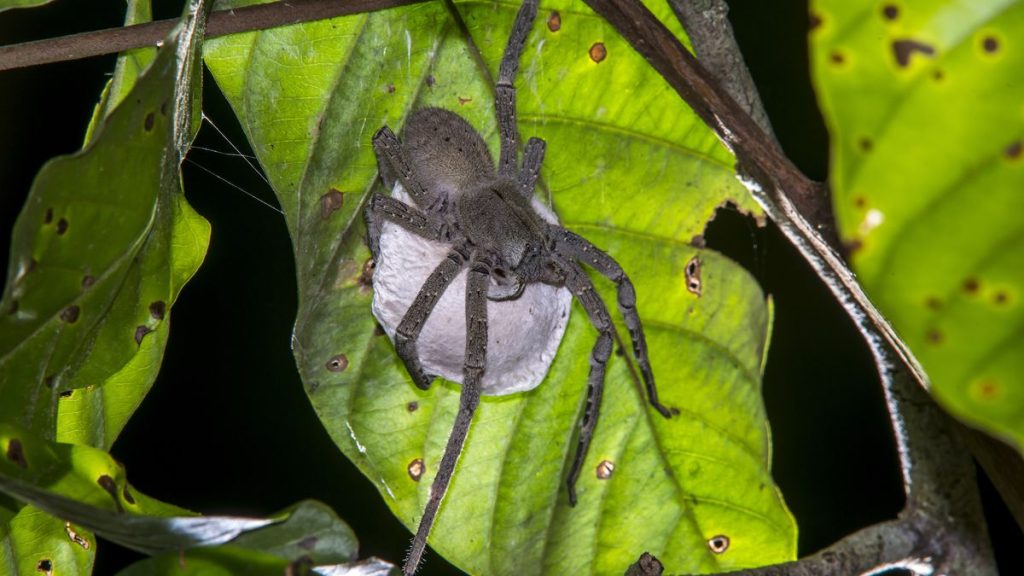
brazilian wandering spider size
Their body length ranges from 17 to 48 mm (43⁄64 to 1+57⁄64 in). Phoneutria are impressive spiders reaching body sizes up to 3.5 centimeters and leg spans up to 15 centimeters. They are nocturnal, hunting at night, and hiding in dark places during the day.
Wandering spider bite
Along with other members of the genus, they are often referred to as Brazilian wandering spiders. Its bite can cause severe symptoms, including increased pulse, blood pressure, and respiratory rate; extraordinary pain; penile erection that lasts for several hours; and, in several documented cases, death.
Phoneutria spp. is actually a genus with five known similar species whose members are highly venomous. They include some of the relatively few species of spiders that present a threat to human beings. The Brazilian Wandering Spider (Phoneutria fera) can grow to have a leg span of up to 4-5 inches.
Wandering spider, (family Ctenidae), any member of the family Ctenidae (order Araneida), a small group of large spiders of mainly tropical and subtropical regions, commonly found on foliage and on the ground.
The Brazilian wandering spiders, Phoneutria fera and P. nigriventer, are sometimes also referred to as banana spiders because they are frequently found on banana leaves. They have an aggressive defense posture, in which they raise their front legs straight up into the air. Phoneutria are venomous, and their venom is toxic to the nervous system, causing symptoms such as salivation, irregular heartbeat, and prolonged painful erections (priapism) in men. Scientists are investigating the venom of P. nigriventer as a possible treatment for erectile dysfunction.
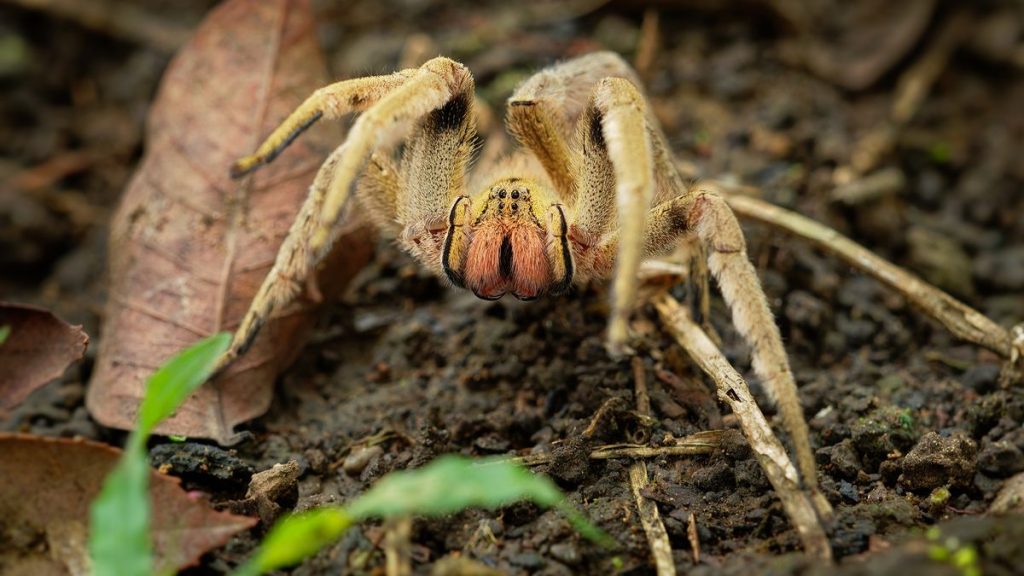
These spiders are notorious both due to their toxic venom, and because they are not reluctant to attack people who appear threatening.
Of the five species known, P. nigriventer and P. fera most frequently receive mention in mass-media publications. P.nigriventer species are responsible for most cases of venom intoxication in Brazil because this species is commonly found in highly populated areas of Brazil, namely the South-eastern states: São Paulo, Minas Gerais, Rio de Janeiro and Espírito Santo.The P. fera is native to the northern portion of South America, especially the Brazilian Amazônia, Venezuela and French Guiana.
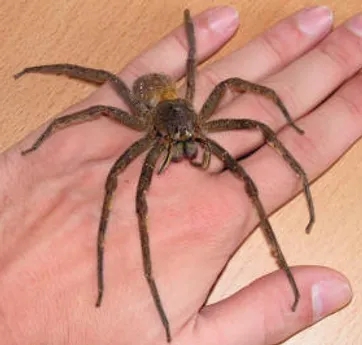
Brazilian wandering spider BITES AND VENOMB
razilian wandering spiders’ venom is a complex cocktail of toxins, proteins and peptides, according to the Natural History Museum in Karlsruhe, Germany. The venom affects ion channels and chemical receptors in victims’ neuromuscular systems.
After a human is bitten by one of these spiders, he or she may experience initial symptoms such as severe burning pain at the site of the bite, sweating and goosebumps, Sewlal said. Within 30 minutes, symptoms become systemic and include high or low blood pressure, fast or a slow heart rate, nausea, abdominal cramping, hypothermia, vertigo, blurred vision, convulsions and excessive sweating associated with shock. People who are bitten by a Brazilian wandering spider should seek medical attention immediately.
Recent studies suggest that these spiders only inject venom in approximately one-third of their bites and may only inject a small amount in another third. However, research in this area is hindered by the difficulty of identifying particular subspecies. Thus the effects of the bites from these spiders are hard to predict when based on sketchy information or if the spider has not been identified definitively.
Bites from these spiders may result in only a couple of painful pinpricks to full-blown envenomation. In either case, people bitten by a Phoneutria or any Ctenid should seek immediate emergency treatment as the venom is possibly life threatening.
he Phoneutria fera and nigriventer are the two most commonly implicated as the most virulent of the Phoneutria spiders. The Phoneutria not only has a potent neurotoxin, but is reported to have one of the most excruciatingly painful envenomations of all spiders due to its high concentration of serotonin.
Brazilian Wandering Spiders are extremely fast, extremely venomous, and extremely aggressive and are ranked among the most venomous spiders known to man. In fact, the Brazilian Wandering Spider is the most venomous spider in the New World! In South America, these true spiders are commonly encountered in peoples’ homes, supposedly hiding in peoples’ shoes, hats, and other clothes. It does not remain on a web, rather, it wanders the forest floor, which is how it got its name.
The Brazilian Wandering Spider has another name – the Banana Spider and it was given this name because there have been cases where these spiders unintentionally appeared on banana boats heading for the United States.
Brazilian Wandering Spider: One Of The World’s Most Venomous Spiders May Be Lurking In Your Bananas
Meet the Brazilian wandering spiders in the genus Phoneutria, also referred to as the armed spiders or the banana spiders. The members of this group have one of the most dangerous bites of any spider species on Earth and they have been classified as the world’s most venomous spider many times.
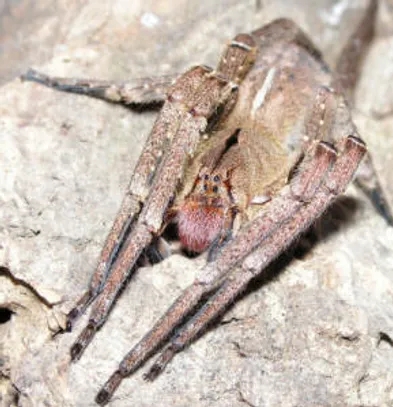
What Are The Effects Of A Brazilian Wandering Spider Bite?
Brazilian wandering spiders often make the news because of the unusual symptoms caused to humans after being bitten by one.
A 2023 study in Frontiers In Molecular Biosciences suggested there were around 4,000 cases of people being bitten by Phoneutria nigriventer in Brazil each year. Their venom affects the nervous system, causing double vision, salvation, irregular heartbeat – and even prolonged painful erections, known as priapism. In fact, because of this, their venom is being explored as a possible treatment for erectile dysfunction conditions.
Can A Brazilian Wandering Spider Bite Kill You?
The neurotoxin PhTx3 is to blame for these symptoms, and according to the Independent, a wandering spider bite can reportedly be fatal in as little as 60 minutes. However, an effective anti-venom is usually enough to save those affected. A study into Phoneutria boliviensis in 2019 suggested that the species had adapted its venom to catch vertebrates as opposed to lizards and amphibians, which might explain why the venom is so toxic to humans.
black and yellow garden spider
Brown recluse spider bite stages pictures.

Brazilian Wandering Spider: Care, Food, Habitat & Preventions
Mike Wallace
Have you ever heard of or do you know what a Brazilian wandering spider is ? It is a big venomous spider from places like Central and South America, and people sometimes call it the banana spider . Why? Well, we are about to find out!
Table of Contents
These wandering spiders are aggressive hunters who go out on the hunt at night. Their meals include both invertebrates (like insects) and vertebrates (creatures with a backbone, like small animals).
These spiders are super dangerous because their venom is like a powerful potion that can make people really sick or even worse. They usually hang out in tropical rainforests and even in cities, hiding in banana plants.
So, let’s get more information about the world of this sneaky spider to learn the details about its looks, eating habits, where it lives, the venom it carries, and find out if it is genuinely risky. Ready to explore? Keep reading!
Brazilian Wandering Spider Description:
Scientific name and family:.
In Brazil, they are sometimes known as “ armed spiders ” (armadeiras), and they share the name “ banana spiders ” with a few other spiders. They have different names, but they are all talking about the same interesting spider!

The Brazilian wandering spider, scientifically known as Phoneutria , Maximilian Perty kickstarted the Phoneutria genus in 1833. The name comes from the Greek word φονεύτρια , which means “murderess” and falls under the Animalia kingdom, Arthropoda phylum, and Arachnida class.
Within Arachnida, it is classified in the order Araneae, infraorder Araneomorphae, and Ctenidae family. The genus Phoneutria, described by Perty in 1833, includes the type species Phoneutria fera .
This classification helps us understand where these spiders fit into the larger picture of living organisms.
The following 9 species are accepted by The World Spider Catalog :
- Phoneutria bahiensis
- Phoneutria boliviensis
- Phoneutria eickstedtae
- Phoneutria fera
- Phoneutria keyserlingi
- Phoneutria nigriventer
- Phoneutria pertyi
- Phoneutria reidyi
- Phoneutria depilata
What do Brazilian Wandering Spider look like?
Size range:.
The spiders in the Phoneutria group can get pretty big in size. Their legs can stretch out to be 13 to 18 centimeters (5 to 7 inches) wide, and their bodies can have a range between 17 to 48 millimeters (a little more than half an inch to almost 2 inches) long.
The female Brazilian spiders can get pretty big, reaching up to 15 centimeters (5.9 inches) in length. On the other hand, the males are smaller, usually measuring around 7 centimeters (2.8 inches). They usually weigh up to 0.21 ounces.
They have long, slender legs, and even though some other spiders with different names might have longer legs, the Phoneutria spiders are champions when it comes to having the longest bodies and being the heaviest in their spider gang.
The spider’s body has two main parts. The first is the prosoma, kind of like its “head,” where you will find all eight legs, eyes, fangs (chelicera), and little multitasking arms (pedipalps).
The second part is the opisthosoma, holding the spinnerets for making silk, the back end opening (anal opening), “the lungs,” the heart, and the important bits for making baby spiders (reproductive organs).
So, the prosoma is like the front control center, and the opisthosoma is like the back office, handling things like silk-making and baby-making.
Brazilian spiders come in different colors, with most being hairy and shades of brown and gray. Some species may have lightly colored spots on their abdomen.
A distinctive feature of many species is the presence of bands of black and yellow or white on the underside of their two front legs.
Identification:
To identify a spider from the Phoneutria group, look for a dense brush of fine hairs on their leg parts. They might seem like other spiders, especially Cupiennius , but here is how you can differentiate:
- Phoneutria often have a dark line on the front of their palps and a thin black line on top of their head.
- Check underneath, too; their legs usually have dark parts and light joints. Sometimes, the belly has black dots or is reddish.
- Usually it has been observed that when they are upset, they do a cool defensive move like lifting their front legs high with a distinctive pattern. So, if you see a spider doing that dance, it is probably a Phoneutria!
Brazilian Wandering Spiders live all over the Americas, from Costa Rica to northern Argentina. They are like the residents of the jungle, chilling in forests east of the Andes in countries like Colombia, Venezuela, Ecuador, Peru, Bolivia, Brazil, Paraguay, and the Guianas.
Some, like P. reidyi, P. boliviensis, and P. fera, love the Amazon rainforest, while others prefer the Atlantic Forest in Argentina, Paraguay, and Brazil.
They have also made themselves at home in the Cerrado savanna. But if you head to northeastern Brazil, they are not around. These spiders have even taken trips to Chile and Uruguay.
Why are they called Banana Spiders?
These spiders are linked with bananas. Richard S. Vetter, a researcher at the University of California, found that these powerful spiders sometimes end up in North America and Europe by accident, hitching a ride in banana shipments.
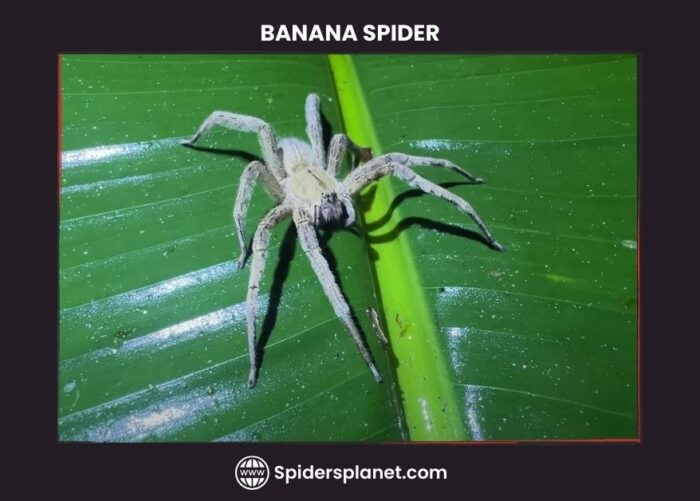
But it is often a case of mistaken identity. Only a few Phoneutria species have been found in banana shipments, and sometimes, other spiders get the blame due to misidentification.
What They Like to Eat or Hunt?
Their food includes flies, beetles, butterflies, moths, grasshoppers, locusts, and crickets. Occasionally, they might even feast on small creatures like amphibians, reptiles, or mice. All these diet or food findings tell us about how diversified eating habits these fascinating spiders have.
Mating and Lifecycle:
Like most spiders, the female spiders are bigger than the males. When the male spider wants to be friends, they do a little dance (vibrating his pedipalps and specialized sensory appendages) to signal his intentions to impress the female, but it is a cautious approach.
The behavior of the female can be choosy, and she might say no to a few before picking the right one.
After the dance, sometimes, the females decide to attack them, or if she is interested, she can store the male’s baby-making material in a special place until she is ready to use it.
Then, she lays a bunch of eggs, up to 1,000 at a time, and keeps them safe in a silk egg sac. Sadly, after laying her eggs, the mom spider says goodbye. It is her way of making sure the new spiders are ready to explore the world on their own.
The lifespan of the banana spider (Phoneutria nigriventer) differs for males and females. Females usually live for 6 to 8 weeks after reaching maturity, while males have a shorter lifespan of 2 to 3 weeks after their last molt.
Certain mammals, like coatis (Procyonidae, which includes raccoons) and other small insectivores, birds are potential predators of large wandering spiders.
These spiders got their name as wandering spiders because of the fact that they are not into web building. Instead, they stroll around the forest floor at night(nocturnal), searching for dinner.
Brazilian Wandering Spiders are active hunters and use both ambush tactics and direct attacks to catch their prey. During the day, they prefer cozy spots like under logs or in crevices, only emerging at night for their hunting adventures. These spiders do not build nests like other spider species.
While wandering spiders are not naturally aggressive towards humans, they won’t hesitate to bite if they feel cornered or threatened. Most bites happen when a spider accidentally gets trapped in clothing or bedding.
Bite and Venom:
The bite of the armed spider is the most dangerous in the world as the venom it carries can be harmful to humans.
The danger is not just about how strong the venom is; it is also about factors like the spider’s likelihood to bite and how close it is to where people live.
These spiders often hide in houses, clothes, and other dark places during the day, making accidental bites more likely.
While their fangs are adapted for small prey, some experts think they might give a “dry” bite in defense to save venom. Studies suggest that not all bites inject venom, and serious cases requiring antivenom are rare.
However, there have been confirmed cases of death, with symptoms appearing quickly, including:
- Severe pain
- Breathing difficulties
- Increased heart rate and blood pressure
- In severe cases, paralysis and death
The severity can depend on the spider’s sex, with females generally more dangerous. The spiders produce less venom in colder months, and a small amount can be potent enough to harm.
Fortunately, bites from Brazilian spiders are rare, and when they do occur, the exposure to the toxins is generally mild, as explained by Vetter.
Also Read: What is a Huntsman Spider? (Heteropodidae) – The Ultimate Guide
Banana Spider’s Facts:
Below are essential details about Brazilian wandering spiders:
- They hold the title for the world’s largest spiders , boasting leg spans reaching up to 15 centimeters (6 inches).
- Their venom packs a powerful punch, capable of inducing severe pain, paralysis, and, in extreme cases, fatal outcomes for humans.
- Despite their intimidating reputation, they are generally non-aggressive and resort to biting only when provoked.
- These spiders inhabit tropical rainforests and urban areas across Central and South America.
- In case someone has been bitten by this spider, he/she needs quick medical treatment to control the effects timely.
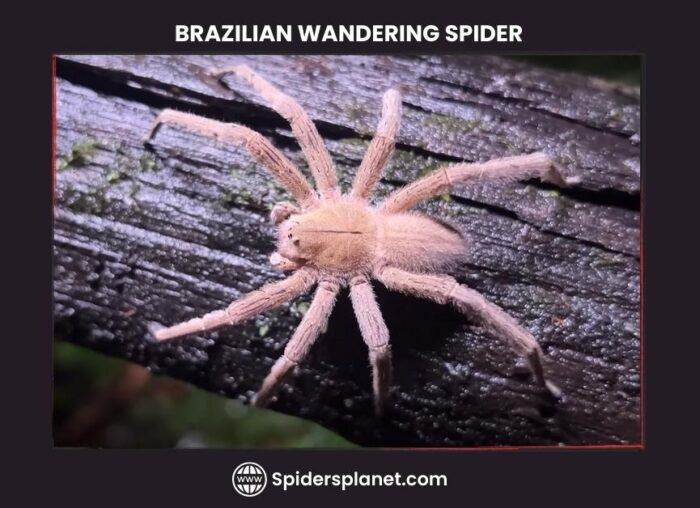
Treatment and Preventive Measures:
If bitten by a wandering spider or armed spiders, prompt medical attention is crucial. There is an antivenom for the spider’s venom, but its effectiveness is highest when administered within a few hours of the bite.
To prevent a bite:
- Wear protective clothing, use shoes and long pants when in areas where these spiders are found.
- Before wearing your clothes and shoes, make sure to check them to ensure no spiders are hiding.
- Maintain cleanliness and avoid leaving food or garbage exposed, as this can attract spiders.
These preventive measures are essential for minimizing the risk of encountering and getting bitten by Banana spiders.
Can Brazilian spiders kill humans?
Brazilian wandering spiders (Phoneutria nigriventer) are venomous and can potentially kill a human with a single bite. Their venom contains a potent neurotoxin that can cause severe pain, paralysis, and even death.
Are Brazilian spiders poisonous?
Yes the venom of this spider is poisonous, that can cause death. While Brazilian wandering spiders are potentially dangerous, actual bites are relatively rare.
By adopting preventive measures and promptly seeking medical attention if bitten, the risk of serious complications can be significantly reduced.
Can you keep Brazilian spiders as pets?
It is strongly advised against keeping wandering spiders as pets due to their venomous nature and the potential risk to human safety.
Managing these spiders in captivity demands specialized knowledge and handling procedures to minimize the risk of bites.
Final Thoughts:
The Brazilian wandering spider, banana spider, or armed spider is a large and venomous arachnid found in Central and South America. While their potent venom can be harmful to humans, encounters are rare.
These nocturnal hunters have adopted various habitats, from rainforests to urban areas, and are associated with banana shipments. Understanding their appearance, behavior, and habitat is crucial for minimizing risks.
Seeking immediate medical attention after a bite is essential, as antivenom is available but most effective when administered promptly. Despite their fearsome reputation, the Brazilian spider remains a captivating and potentially dangerous species.
About the author
Spiders Planet is the ultimate source of information about spiders! All the articles on this site will provide you with the most accurate and up-to-date information written by me and a group of writers, that is well-researched and fact-checked before it’s published.
Leave a Reply Cancel reply
Your email address will not be published. Required fields are marked *
Save my name, email, and website in this browser for the next time I comment.
Latest posts

Do Spiders Eat Fruit? Unveiling the Secrets
The connection between animals and fruits showcases a captivating example of mutualism, a win-win relationship where both parties benefit. Animals gain access to…

Are Woodlouse Spiders Venomous?
The Woodlouse spider (Dysdera crocata) is a spider species that mainly hunts and feeds on woodlice and is mostly found in Africa, Asia,…

What Does Wolf Spiders Eat?
Wolf spiders are excellent hunters of small insects. Unlike spiders that weave intricate webs, these predators rely on sharp vision and stealthy moves…

AnimalBehaviorCorner

Brazilian Wandering Spider
Brazilian Wandering Spider , scientifically known as Phoneutria, emerges as a captivating enigma in the realm of arachnids.
Renowned for its formidable reputation as one of the world’s most venomous spiders , Phoneutria embodies a plethora of intriguing traits that have captured the curiosity of enthusiasts and researchers alike.
From its distinctive appearance and neurotoxic venom to its nomadic hunting strategies and unique mating behaviors , this remarkable spider species holds a wealth of fascinating secrets waiting to be unraveled.
Join us as we embark on a journey to explore the captivating world of the Brazilian Wandering Spider, shedding light on its captivating characteristics and dispelling myths that have shrouded its true nature.
1. Taxonomy and Distribution of the Brazilian Wandering Spider
A. scientific classification of phoneutria.
The Brazilian Wandering Spider, scientifically referred to as Phoneutria, occupies a distinct place within the arachnid taxonomy.

Belonging to the family Ctenidae, this spider genus is further categorized into several species, each boasting unique traits and behaviors .
Phoneutria’s taxonomic position not only distinguishes it from its arachnid counterparts but also underscores its intriguing evolutionary journey.
B. Native Habitat in South and Central America
Endemic to the lush landscapes of South and Central America, the Brazilian Wandering Spider finds its natural haven within these diverse regions.
From the rainforests of the Amazon to the tropical stretches of the Caribbean, Phoneutria has adapted to a range of environments over the course of its evolution.
The spider’s ancestral ties to these regions are tightly woven into their behaviors , anatomy, and survival strategies.
C. Preference for Tropical Rainforests and Urban Areas
Within its native territories, the Brazilian Wandering Spider exhibits remarkable versatility in its chosen habitats.
While it thrives amidst the vibrant biodiversity of tropical rainforests, it has also displayed a propensity for urban locales.

Phoneutria’s adaptability has led it to establish a presence in urban areas, where it often finds shelter in crevices, gardens, and even human dwellings.
This adaptability to both wild and urban spaces further showcases the spider’s resilience and capacity to thrive in varying conditions.
2. Physical Characteristics of the Brazilian Wandering Spider
A. size, coloration, and distinctive markings.
The Brazilian Wandering Spider , a creature of remarkable visual intrigue, boasts an array of captivating physical attributes.
Ranging in size from a few centimeters to several inches, Phoneutria showcases a size diversity that reflects the breadth of its genus.
Its coloration varies across species, encompassing shades of brown, black, and gray, often accompanied by intricate patterns and markings that adorn its exoskeleton.
These unique markings serve not only as a visual spectacle but also as essential components of its survival toolkit.
B. Camouflage and Defense Mechanisms
The Brazilian Wandering Spider’s appearance is a masterpiece of evolution, meticulously crafted to ensure both survival and predation .

Its coloration and markings are tailor-made for blending seamlessly into its surroundings, granting it a potent advantage in ambushing prey and evading predators . Moreover, these markings also play a role in its defense mechanisms.
When threatened, Phoneutria adopts a defensive posture, raising its front legs and revealing its striking markings, a visual warning to potential threats. This dual-purpose camouflage and defense strategy exemplify nature’s ingenuity at its finest.
C. Sexual Dimorphism: Unveiling Gender Differences
A fascinating facet of the Brazilian Wandering Spider lies in the realm of sexual dimorphism , where gender-based variations manifest in pronounced ways.
Females tend to be larger and more robust than their male counterparts, showcasing a size disparity that has evolved in tandem with their roles in reproduction and hunting .
Beyond size, other characteristics, such as leg structure and coloration, also exhibit subtle differences between male and female Phoneutria specimens.
This divergence in physical traits adds depth to our understanding of the species’ intricate biology and behavior .
In exploring the physical characteristics of the Brazilian Wandering Spider , we uncover a canvas painted with size diversity, intricate coloration, and unique markings.
These features, finely tuned by evolution, contribute to its prowess in camouflage and defense, while the fascinating interplay of sexual dimorphism further enriches our perception of this captivating arachnid species .
3. Venomous Nature of the Brazilian Wandering Spider
A. potent neurotoxic venom: a silent lethal weapon.
The Brazilian Wandering Spider, known scientifically as Phoneutria, harbors a venomous arsenal that stands as a testament to nature’s intricate design.

This spider’s venom contains a potent concoction of neurotoxic compounds, tailored by evolution to incapacitate its prey swiftly and efficiently.
The neurotoxins interfere with nerve cell communication, leading to paralysis and ensuring that Phoneutria’s quarry is rendered immobile and defenseless, setting the stage for a successful meal.
B. Effects on Prey and Human Hazard
When a victim succumbs to the Brazilian Wandering Spider’s venom , the effects are a symphony of paralysis and predation .
The venom’s impact on the prey’s nervous system results in swift immobilization, offering the spider a decisive advantage in subduing its catch.
While this venomous efficiency is well-adapted for predation, it also underscores the potential danger to humans.
A bite from Phoneutria can lead to a series of neurotoxic reactions, with varying degrees of severity depending on factors such as the individual’s age and overall health.
While human envenomations are relatively rare, they can result in a range of symptoms, from localized pain and swelling to more severe neurological effects.
C. Recorded Cases of Envenomations: Unraveling the Symptoms
Throughout history, documented cases of Phoneutria envenomations have offered insights into the spider’s potential threat to humans .

Symptoms typically include intense pain at the bite site, accompanied by swelling and redness . In some instances, victims have reported systemic reactions, such as muscle cramps, elevated heart rate, and even breathing difficulties.
Swift medical attention and the administration of antivenom have proven effective in mitigating the severity of these symptoms.
These cases serve as a reminder of the delicate balance between the Brazilian Wandering Spider’s potent venom and the potential risks it poses to those who unwittingly encounter it.
4. Hunting and Diet of the Brazilian Wandering Spider
A. hunting techniques and wandering behavior.
The Brazilian Wandering Spider, scientifically known as Phoneutria, unveils a mesmerizing repertoire of hunting techniques that set it apart as a master predator .
Displaying an agile and nomadic behavior , Phoneutria does not confine itself to the confines of a web. Instead, it actively prowls its surroundings, tirelessly searching for potential prey.
This dynamic wandering behavior ensures that its chances of encountering a variety of food sources are maximized, showcasing a strategic approach to sustenance.
B. Active Hunting Triumphs Over Web-Building
Unlike its web-weaving counterparts, the Brazilian Wandering Spider relies on a more hands-on approach to securing its next meal.
While weaving webs might seem an efficient method, Phoneutria’s active hunting strategy offers a distinct advantage in versatility.
By forgoing the constraints of a stationary web, it can tailor its approach to suit different environments and prey types, adapting its tactics on the fly.
This adaptability demonstrates the spider’s remarkable ability to adjust its methods for optimal results.
C. Diverse Prey Spectrum: Insects to Small Vertebrates
Phoneutria’s diet is a testament to its prowess as an opportunistic predator . Its menu spans a diverse range of creatures, from insects like crickets and cockroaches to small vertebrates such as lizards and frogs , and even small rodents.

This wide-ranging palate highlights its ecological significance in controlling various populations within its habitat.
By consuming creatures both large and small, Phoneutria ensures a balanced ecosystem, playing a crucial role in maintaining biodiversity and ecological equilibrium.
5. Mating and Reproduction of the Brazilian Wandering Spider
A. courtship rituals and behaviors: a complex affair.
The Brazilian Wandering Spider, scientifically referred to as Phoneutria, reveals a captivating array of courtship rituals and behaviors that form the cornerstone of its reproductive cycle.
Courtship among these arachnids is a complex affair, involving intricate dances and displays that serve as both communication and assessment.
Male Phoneutria employs a combination of visual cues, vibrations, and tactile interactions to court potential mates.
This elaborate courtship process highlights the significance of precise communication in the delicate dance of reproduction .

B. Cannibalistic Tendencies: A Post-Mating Phenomenon
An aspect that sets Phoneutria’s mating process apart is the notorious cannibalistic tendency exhibited by females after mating.
Following successful mating, females may exhibit an inclination to consume their partners. This seemingly counterintuitive behavior has evolutionary underpinnings.
It is believed that this cannibalistic act not only provides the female with a much-needed nutritional boost but also eliminates potential competitors and safeguards the male’s investment in the next generation.
This intriguing behavior sheds light on the complexities of reproductive strategies within the species.
C. The Unique Mating Plug Phenomenon: A Puzzling Enigma
A distinctive feature in Phoneutria’s reproductive saga is the enigmatic mating plug phenomenon. After mating, male Phoneutria deposit a specialized substance that forms a plug within the female’s reproductive tract.
This plug is believed to serve multiple purposes. It may prevent other males from mating with the female, thus ensuring the successful transmission of the mating male’s genetic material.
Additionally, it might aid in sealing off the female’s reproductive tract, potentially protecting her from external pathogens.
This phenomenon underscores the intricate interplay of biological strategies that contribute to the species’ reproductive success.
6. Human Interaction and Urban Legends of the Brazilian Wandering Spider
A. occasional presence in urban areas: nature in our midst.
The Brazilian Wandering Spider, scientifically known as Phoneutria, has carved a niche for itself not only in the wild but also in the fabric of urban environments.

While its primary habitats are the lush landscapes of South and Central America, Phoneutria occasionally ventures into human -inhabited spaces. Its adaptability allows it to find shelter in gardens, crevices, and even within homes.
This coexistence with humans adds an intriguing dimension to our encounters with this enigmatic arachnid .
B. Debunking Misconceptions: Separating Fact from Fiction
The presence of the Brazilian Wandering Spider has sparked a plethora of misconceptions and exaggerated tales, contributing to the creation of urban legends.
Stories of spiders leaping from banana bunches or hiding under toilet seats have become part of modern folklore, often fueled by sensationalism.
It’s crucial to sift through these tales and recognize that while Phoneutria’s venom is potent, the likelihood of encountering a dangerous encounter is relatively low.
Separating fact from fiction empowers individuals to approach these creatures with accurate knowledge.
C. Importance of Proper Education: Identifying Friend from Foe
Education plays a pivotal role in fostering a harmonious coexistence between humans and the Brazilian Wandering Spider .
Learning to identify and understand the behaviors of Phoneutria species enhances safety for both humans and the spiders themselves.
Instead of succumbing to unwarranted fear, individuals can take steps to reduce the chances of accidental encounters and, if necessary, engage in responsible removal methods.
By arming themselves with knowledge, individuals can navigate encounters with urban-dwelling Phoneutria specimens with confidence and respect.
7. Brazilian Wandering Spider Conservation and Misunderstanding
A. significance of phoneutria in ecosystem dynamics.
The Brazilian Wandering Spider , scientifically termed Phoneutria, assumes a pivotal role within its ecosystem, contributing to a delicate balance of populations and interactions.

As a top-tier predator , it plays a crucial part in controlling insect and small vertebrate populations, preventing unchecked growth that could disrupt the ecosystem’s equilibrium.
By maintaining these population dynamics, Phoneutria ensures the health and stability of its habitat, highlighting its significance beyond its ominous reputation.
B. Impact of Fear and Misunderstanding: Hindrances to Conservation
Despite its ecological contributions, the Brazilian Wandering Spider often falls victim to fear-driven misconceptions that negatively impact conservation efforts.
Misunderstandings surrounding its behavior and potential danger can lead to unwarranted extermination campaigns and habitat destruction.
Fear-driven reactions not only disrupt the natural balance but also hinder opportunities to study and appreciate the species for its ecological significance.
Addressing these misconceptions is crucial to ensuring the spider’s survival and maintaining the health of its ecosystems.
C. Efforts to Dispel Myths and Promote Coexistence
Efforts to conserve the Brazilian Wandering Spider are interwoven with endeavors to educate and dispel myths.
By providing accurate information and dispelling exaggerated tales, conservationists aim to reshape public perception.
Collaborative initiatives emphasize coexistence, highlighting the importance of responsible behavior when encountering Phoneutria.
Educating communities about the spider’s role, behavior, and conservation status fosters an environment where fear gives way to appreciation, and where balanced cohabitation becomes a reality.
8. Research and Medical Significance of the Brazilian Wandering Spider
A. ongoing scientific research on phoneutria venom.
The Brazilian Wandering Spider , Phoneutria, has garnered significant attention from the scientific community due to the unique properties of its venom.
Ongoing research delves into the intricate composition of the venom, aiming to unlock its mysteries and potential applications in various fields.
The diverse array of compounds within the venom, particularly its neurotoxic components, has attracted interest for their potential medical and therapeutic implications.
B. Antivenom Development and Therapeutic Prospects
One of the most promising areas of research surrounding Phoneutria lies in the development of antivenoms and therapeutic agents.

The venom’s potent neurotoxic effects on the nervous system have spurred efforts to create targeted treatments for conditions such as chronic pain and neurological disorders .
Additionally, the potential for antivenoms holds promise in mitigating the effects of envenomations, offering a lifeline for individuals who encounter these spiders .
This focus on harnessing the venom’s properties for positive medical outcomes highlights the transformative potential within this enigmatic arachnid .
C. Balanced Perspectives: Navigating Ethical and Scientific Endeavors
While research on the Brazilian Wandering Spider’s venom offers tremendous potential, it necessitates a balanced perspective.
As researchers probe the venom’s properties, ethical considerations arise, including the well-being of the spiders and their ecosystems.
A holistic approach acknowledges the value of understanding Phoneutria’s natural behaviors and conserving its habitats.
This balanced perspective extends to utilizing the venom’s potential responsibly, ensuring that breakthroughs are achieved while respecting the complex interplay of science and nature.
9. Frequently Asked Questions about the Brazilian Wandering Spider
What is the brazilian wandering spider.
The Brazilian Wandering Spider , scientifically known as Phoneutria, is a venomous arachnid found in South and Central America. It’s notorious for its potent venom and is considered one of the most venomous spiders in the world.
Is the Brazilian Wandering Spider dangerous to humans?
Yes, the Brazilian Wandering Spider’s venom contains potent neurotoxins that can cause a range of symptoms in humans , from localized pain and swelling to more severe reactions. While bites are relatively rare, it’s advisable to exercise caution when encountering these spiders.
What is the spider’s habitat?
The Brazilian Wandering Spider is native to tropical rainforests of South and Central America. However, it’s adaptable and can also be found in urban areas, such as gardens and houses.
How does the Brazilian Wandering Spider hunt?
Unlike many spiders that build webs, Phoneutria is an active hunter. It roams its environment in search of prey, relying on its keen senses to detect vibrations and movements.
Are Brazilian Wandering Spiders aggressive toward humans?
Brazilian Wandering Spiders are not naturally aggressive towards humans and will typically only bite in self-defense. However, caution is advised, especially in areas where these spiders are known to inhabit.
Can the Brazilian Wandering Spider’s venom be used for medical purposes?
Yes, research is ongoing into the potential medical applications of Phoneutria’s venom. Its neurotoxic properties have sparked interest in pain management and neurological treatments.
Is the spider’s reputation for crawling into banana shipments true?
While there have been stories of Brazilian Wandering Spiders being found in shipments of bananas, these occurrences are extremely rare. Spiders are unlikely to survive the conditions of shipping and storage.
How can I stay safe around Brazilian Wandering Spiders?
To stay safe, it’s important to be cautious when encountering spiders in their natural habitat. Avoid provoking or handling them, especially if you’re unsure of their identity. If you suspect you’ve been bitten, seek medical attention promptly.
Are there any efforts to conserve the Brazilian Wandering Spider?
Conservation efforts for the Brazilian Wandering Spider are intertwined with public education and dispelling myths. Recognizing its role in ecosystems and promoting coexistence are essential steps in preserving this unique species.
What can I do if I find a Brazilian Wandering Spider in my home?
If you encounter a Brazilian Wandering Spider in your home, it’s advisable to contact local pest control professionals who can safely remove the spider without causing harm.
In the intricate tapestry of nature, the Brazilian Wandering Spider , Phoneutria, emerges as a creature of both fascination and caution.
Its venomous nature and captivating behaviors have earned it a place among the most enigmatic arachnids .
As we continue to explore its world, debunk myths, and understand its vital role in ecosystems, we find a delicate balance between awe and respect.
Armed with knowledge, we navigate the realm of Phoneutria, appreciating its complexity while fostering coexistence, a testament to the intricate dance between humans and the natural world.
Share this:
Similar posts.

Weirdest Animal Behaviors
Weirdest Animal Behaviors have long captivated the curiosity of scientists and nature enthusiasts alike. From the bizarre communication methods of the animal kingdom to the peculiar ways in which some creatures adapt to their environments, the natural world is a treasure trove of astonishing and sometimes perplexing behaviors. In this exploration of the animal kingdom’s…

Hyena Behavior
Hyena Behavior is a captivating subject that offers intriguing insights into the social dynamics, communication, and hunting strategies of these remarkable carnivores. Hyenas, often misunderstood and underestimated, display a wealth of behaviors that set them apart from other wildlife. From their distinctive cackling calls to their cooperative hunting techniques, understanding hyena behavior is not only…

Giraffe Behavior
Giraffe Behavior is a captivating subject that unveils the intriguing social dynamics and distinctive habits of these iconic African mammals. In their natural habitats, giraffes exhibit a complex array of behaviors that reflect their adaptability and intelligence. Living in loose social groups known as towers, these graceful creatures engage in various activities such as necking,…

Monitor Lizard vs Komodo Dragon
Monitor Lizard vs Komodo Dragon: What’s the difference? Monitor lizards and Komodo dragons are two of the most fascinating reptiles on the planet, often confused with one another due to their similar appearances. However, while they may look alike, these two species differ significantly in several important ways. In this article, we’ll take an in-depth…

Anhinga Bird Behavior
The Anhinga bird, also known as the “snakebird” or “water turkey,” is a captivating species that effortlessly straddles the realms of air and water. With its distinct physical features and unique adaptations, the Anhinga bird stands out as a masterful hunter and swimmer among its avian counterparts. Found in a variety of wetland habitats across…

Clownfish Behavior
Clownfish Behavior is a fascinating subject that offers valuable insights into the intriguing world of these colorful marine creatures. These vibrant fish, famously depicted in popular animated movies, exhibit a range of behaviors that not only capture the imagination but also play a crucial role in their survival within the intricate ecosystem of coral reefs….

The World’s Most Venomous Spider: The Brazilian Wandering Spider
Published: August 10, 2023
- Facebook 19
Few things fear people’s hearts, like the mention of venomous spiders. According to the Guinness World Records , venomous spiders are some of the most dangerous creatures on Earth, and the Brazilian Wandering Spider is the world’s most venomous spider. This elusive arachnid is found in the rainforests of South America, more specifically in Brazil, Argentina, and French Guiana. ‘
It is considered one of Brazil’s most significant public health threats, with a potent venom capable of causing extreme pain, paralysis, and even death. Despite its fearsome reputation, however, the Brazilian Wandering Spider is a fascinating and unique creature with many incredible features that make it stand out from other spiders.
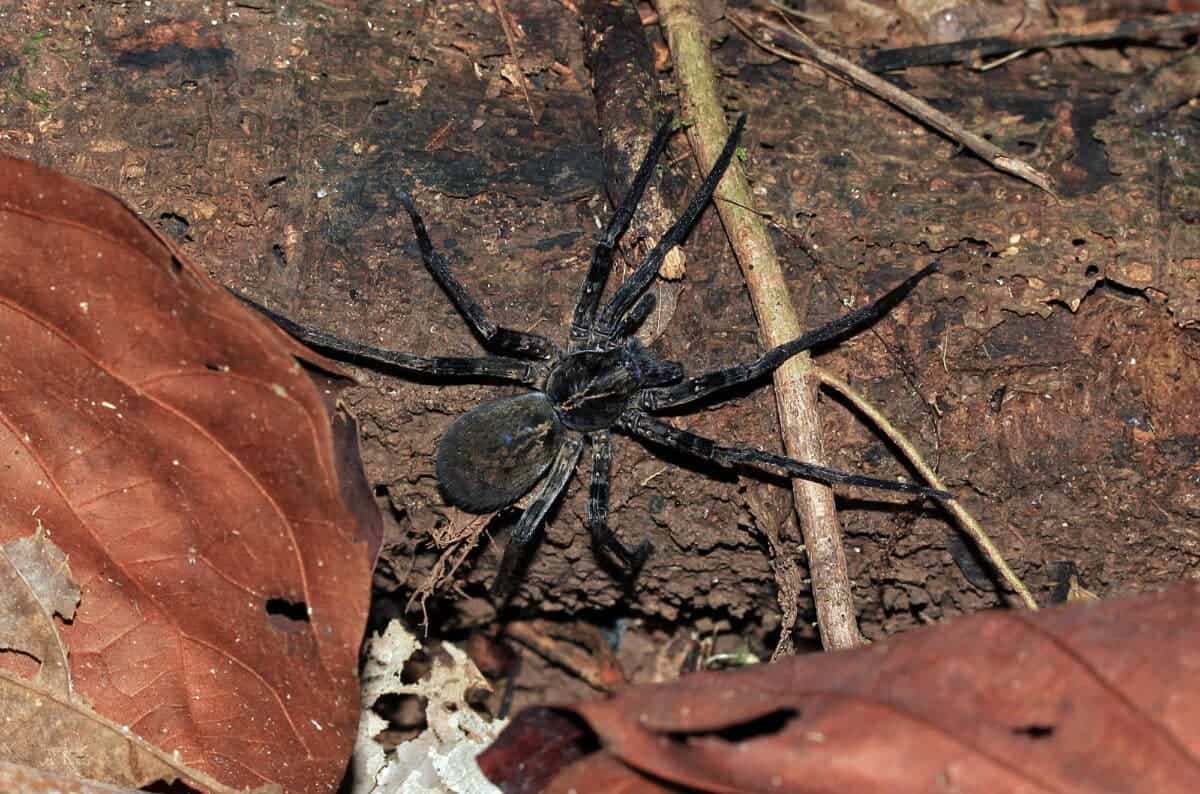
Jump ahead to any section below!
Brazilian Wandering Spider’s Habitat And Range
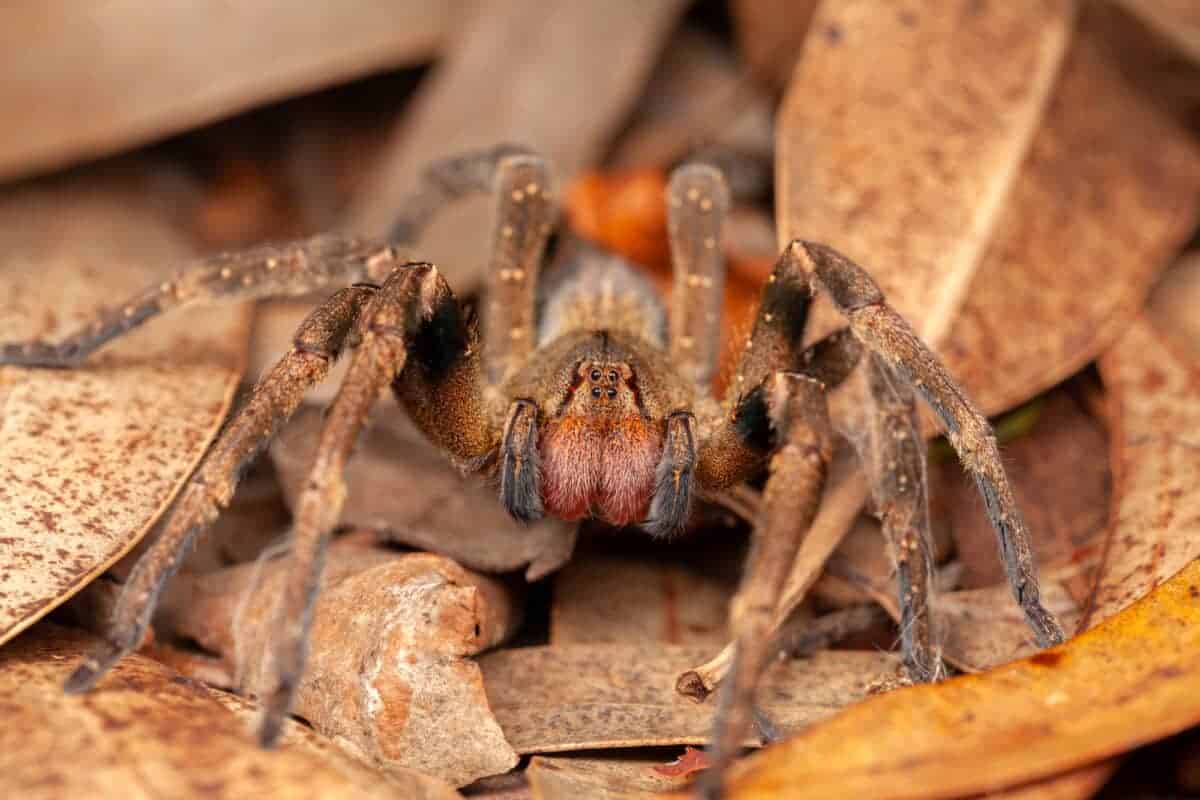
The Brazilian Wandering Spider is found in the rainforests of South America. These rainforests are the world’s largest and most biodiverse terrestrial ecosystems, covering an area of approximately 6.7 million square kilometers. This equates to roughly 40% of the total area of South America and spans nine countries, including Brazil, Peru, and Colombia.
The Amazon rainforest, the most extensive rainforest on Earth, plays an essential role in the Brazilian Wandering Spider’s habitat and range. The spider relies heavily on the dense canopy of trees in these rainforests for shelter and protection. The Amazon rainforest also provides the spider with an abundant prey source, including insects, small mammals, and other spiders.
The South American rainforests are characterized by their warm and humid climate, which creates the ideal conditions for the Brazilian Wandering Spider to thrive. These ecosystems also have a high rainfall throughout the year, which sustains the dense vegetation and creates an ideal environment for spiders to hunt and reproduce.
Check out: Uncovering The Enigma Of The Greenland Shark .
Specific Locations The Brazilian Wandering Spider Is found
The Brazilian Wandering Spider is most commonly found in Brazil. It can also be found in other parts of South America, such as Argentina and French Guiana. In Brazil, the spider can be found in various regions. This includes the Amazon rainforest, the Atlantic forest, and the Caatinga ecosystem.
The Atlantic forest, a tropical forest that spans the Brazilian coast, is also an important habitat for the Brazilian Wandering Spider. This ecosystem is under threat due to deforestation and urbanization. This has resulted in the loss of the spider’s natural habitat.
In French Guiana, the spider is present in the Guiana Amazonian Park, a protected area of the Amazon rainforest managed by the French government. The Guiana Amazonian Park is home to an array of biodiversity, including monkeys, jaguars, and over 400 species of birds. This makes it an important region for the Brazilian Wandering Spider’s survival.
Brazilian Wandering Spider’s Characteristics
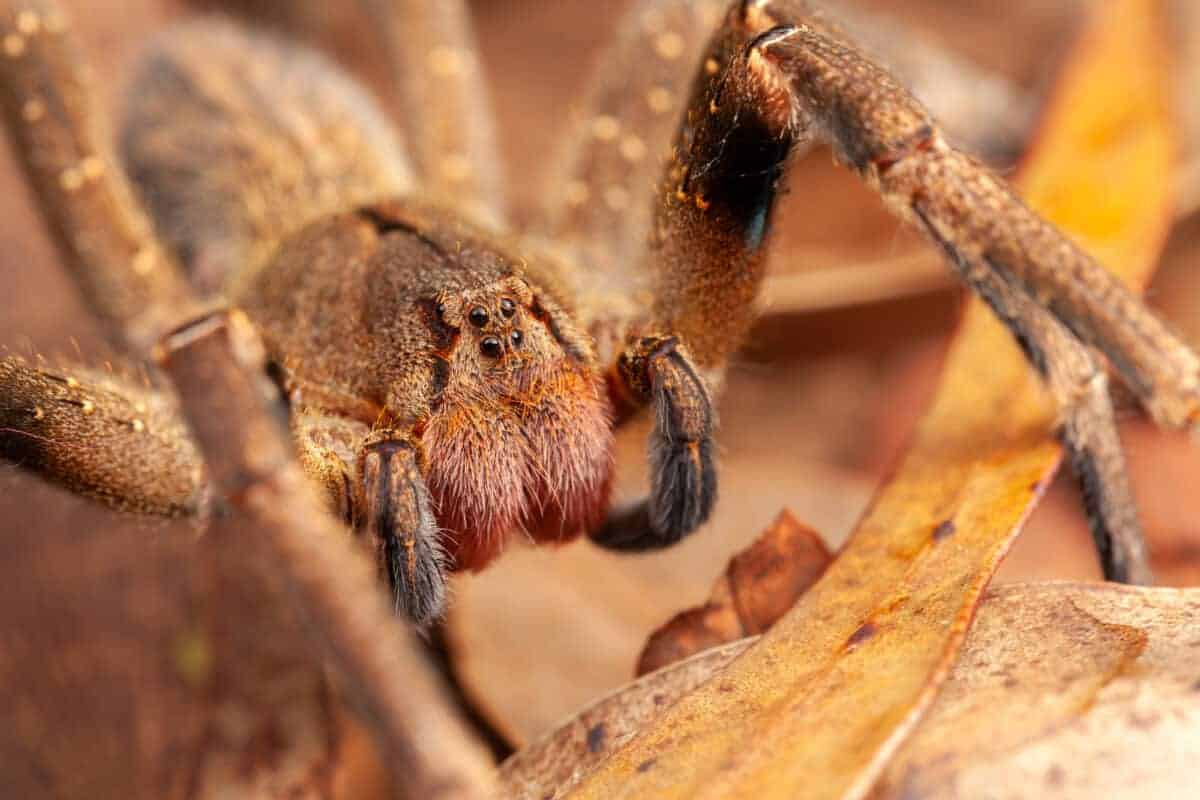
It is a remarkable arachnid species found in the rainforests of South America. It has numerous unique characteristics from other spiders. The Spider is large and intimidating, measuring up to 10 inches (25 cm) in leg span. Its body size ranges from 0.98 to 1.77 inches (2.5 to 4.5 cm) in length. This makes it one of the biggest spider species in the world. It has eight long and hairy legs, which help it move quickly and climb trees effortlessly.
The spider is striking, with a shiny brown or black body covered in short fine hairs. Its legs are also covered in fine hairs with dark stripes or spots. These markings have a unique pattern that helps to identify the spider from other species. Unlike most spiders, the Brazilian Wandering Spider doesn’t have a distinct web-spinning organ. But instead moves around the forest floor and trees in search of its prey.
Behavioral Patterns
They are aptly named because they are known to wander about and can cover a great distance while searching for food and mates. It’s primarily active at night and is a solitary hunter that preys on insects, spiders, rodents, and even small snakes. It has a unique hunting technique where it grabs its prey with its front legs and sinks fangs into it, injecting a potent venom that can quickly immobilize and kill its victim. Interestingly, this spider can adjust the amount of venom it injects to fit the size and the species of its prey, a skill unique to this spider species.
During the mating season, the Brazilian Wandering Spider’s behavior changes drastically. The males will approach females cautiously, tapping on the female’s web to signal their interest. They then perform a complex courtship display that involves waving their front legs, drumming their pedipalps, and vibrating on webs. The more intricate the display, the higher the chances of mating with the female.
Brazilian Wandering Spider’s Venom
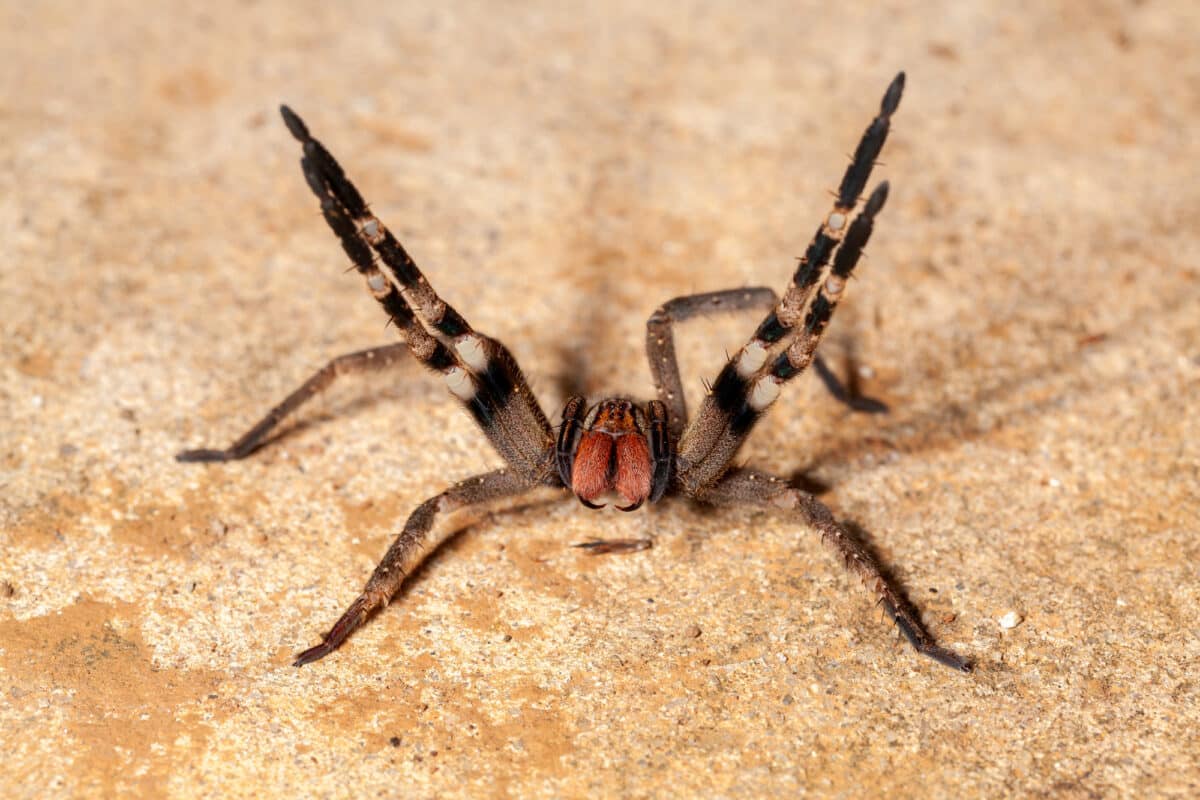
The venom of the Brazilian Wandering Spider is considered one of the deadliest in the world. The potency of the venom is due to the presence of a potent neurotoxin called PhTx3. This toxin is responsible for the spider’s ability to paralyze its prey and defend itself from predators.
In scientific studies, the venom of the Brazilian Wandering Spider has proven to be significantly more toxic than other venomous spiders, such as the Black Widow and the Brown Recluse. The effectiveness of this venom is a result of its unique chemical structure, which allows it to attack the nervous system of its victim and cause significant damage.
Check out: Bengal Tiger Vs. Western Diamondback Rattlesnake .
Effects Of Venom On Humans And Animals
The effects of the venom of the Brazilian Wandering Spider can be devastating. When bitten, victims may experience severe pain, muscle spasms, and even paralysis. In extreme cases, the venom can cause respiratory failure, resulting in death.
While the venom initially causes pain and discomfort, it can lead to severe, long-lasting symptoms. In addition to causing physical harm, the venom can also have psychological effects, leading to anxiety, panic attacks, and even PTSD.
Animals are also susceptible to the venom of the Brazilian Wandering Spider . Small animals, such as mice and birds, are often preyed upon by the spider, while larger animals, such as dogs and cats, can be bitten accidentally.
Public Health Threat And Prevention
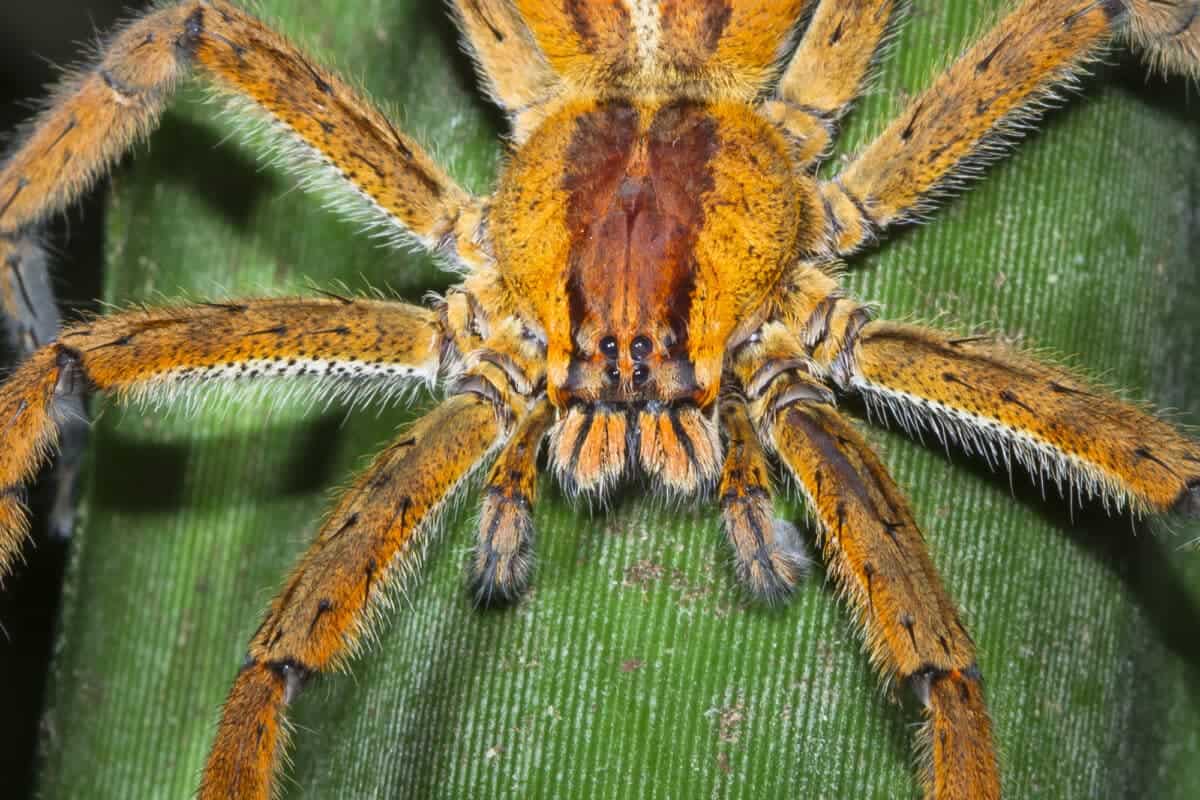
The Brazilian Wandering Spider is a significant public health threat in Brazil, with hundreds of bites reported yearly. The spider has a wide distribution throughout the country, and its venom is particularly toxic, making it a serious risk to human health.
Also, the spider is especially dangerous because it is highly aggressive and can be found in homes, gardens, and public spaces. This means that anyone can encounter the spider, regardless of location or occupation, making it difficult to prevent bites.
Measures Taken To Prevent Bites And Treat Victims
To prevent bites from the Brazilian Wandering Spider, it is essential to take steps to reduce the risk of encountering the spider. This may include keeping homes and gardens free of clutter and debris, sealing windows and doors, and avoiding areas where the spider is known to live.
In the case of a bite, it is important to seek medical attention immediately. While no anti-venom is available, medical professionals can offer supportive care to alleviate symptoms and prevent complications.
Frequently Asked Questions
The Brazilian Wandering Spider’s venom contains a potent neurotoxin called PhTx3, which can cause extreme pain, muscle spasms, and paralysis in humans. This venom is 20 times more deadly than a rattlesnake’s and can cause respiratory failure in victims.
It is primarily found in South and Central America, especially in the Amazon rainforest. They hide in dark, moist environments such as piles of leaves, tree trunks, and burrows.
To avoid contact with the Brazilian Wandering Spider, it is important to inspect your surroundings, especially before putting on shoes or reaching into piles of debris. It is advisable to wear gloves and long sleeves when working outdoors or in areas where these spiders may be present. If you suspect a Brazilian Wandering Spider has bitten you, seek medical attention immediately.

Overall, the Brazilian Wandering Spider is a fascinating and deadly spider that deserves respect and caution. Though its venom is incredibly potent, the spider itself is a remarkable creature. Its ability to move quickly and seamlessly across the ground makes it a formidable predator in its native habitats.
Despite its fearsome reputation, we must learn to coexist with this remarkable arachnid, preserving its unique place in the natural world. Given the immense diversity and beauty of our planet’s biodiversity, the Brazilian Wandering Spider reminds us that we still have much to learn about the remarkable creatures that share our planet.
thanks for reading along! See below for related article links.
- Basking Shark
- Whale Sharks
- Tiger Shark Encounters
- The Great White Shark: Apex Predator of the Ocean
- Gorilla And Anaconda In Focus
- The English Bulldog
- Largest Asian Elephant
- The Largest Gorilla Ever Recorded
- Latest Posts
- Watch Starfish Walking on the Beach - April 24, 2024
- Watch Bison Stampede Around Bus in Yellowstone - April 24, 2024
- How to Survive a Tiger Attack - April 23, 2024
Brazilian Wandering Spider Facts: What Happens If It Bites You?
Brazilian wandering spiders belong to the genus Phoneutria and are represented by eight spider species that are native to Central America and South America. This spider group is also collectively known as armed spiders and banana spiders. In Brazil, they are locally known as "aranha armadeira" which means armed spider. With these, some people often wonder if a person can survive after being by a member or species of this group.
What is a Brazilian Wandering Spider?
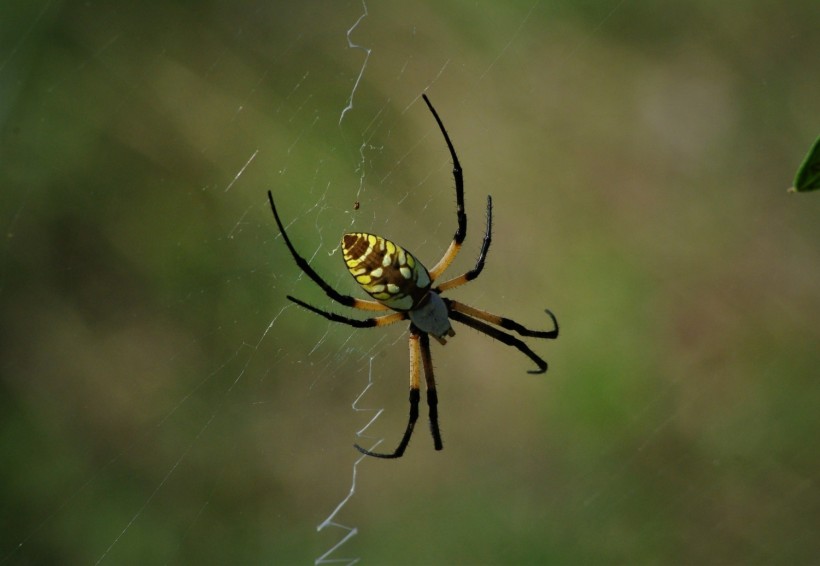
The genus Phoneutria , which the Brazilian wandering spider and related spider species belong to, was first described in 1833 when two species was included on it. The following century saw various scientists to move the Phoneutria species between genera Phoneutria and Ctenus . In 1936, Mello-Leitao restored Phoneutria and currently contains eight species, as reported by the University of Florida.
Banana spiders, a name given to the arachnid group due to their frequent presence on banana leaves, are large and robust arachnids in the family Ctenidae . They resemble the morphological appearance of wolf spiders. In addition, their body length can grow ranging from 17 and 48 millimeters and their leg span can reach 180 millimeters. Their distinct color ranges from light brown, brown, or grey. Furthermore, the natural habitats of armed spiders are forests.
Also Read: Deadly Erection-Giving Spider Crawls Out of Banana In Bristol
What Happens If It Bites You?
The natural prey of Brazilian wandering spiders includes small animals like crickets, mantids, and katydids, and larger ones like bats, frogs, and lizards. However, they can still bite humans and other animals not native in their habitats. In the past, scientists have identified that the bite of banana spiders living in Central and South American rain forests can lead to shortness of breath and excessive salivation.
According to wildlife experts, a Brazilian wandering spider bite can also lead to other serious symptoms, including increased blood pressure, above-normal pulse, and unusual respiratory rate, as well as extreme pain, hours-long penile erection, and death, in some cases. These spiders inject neurotoxin venom to its bitten victim and can be deadly to humans, particularly for children. However, it is not the world's deadliest spider.
Venomous Spider
In a study published in the journal Frontiers in February 2023, researchers stated that the Brazilian wandering spider is amongst the world's most dangerous venomous spiders in the world. In Brazil, there have been an estimated 4,000 envenomation accidents of Phoneutria nigriventer spider species each year in Brazil. Additional symptoms were also observed, including blurred vision, priapism, and vomiting.
The armed spider only follows the world's most venomous spider, which according to the Guinness World Records , is the Sydney funnel-web spider ( Atrax robustus ).
Like the Brazilian wandering spider, the venom of A. robustus can be neutralized by anti-venoms but some cases still lead to deaths when these arachnids bite a human, who did not receive any medical attention. Experts also weigh that the mortality of venom depends on the amount that enters a human body.
Related Article: Arachnophobia Nightmare: Giant Spider Found Inside Banana Box at Grocery Store in Germany
Tags Brazilian wandering spider , banana spider , Spider , spider bite , animals , Wild Animals
© 2024 NatureWorldNews.com All rights reserved. Do not reproduce without permission.

Solar Storm Alert: Quadruple Solar Flares Erupt from the Sun Almost Simultaneously, Emitting Intense Electromagnetic Radiation

Oklahoma, Tennessee Valley Forecast: Stormy Conditions Likely to Affect Daily Commutes This Week

Extreme Heat, Flooding and Disease Threaten African Megacities Like Cairo and Lagos, Scientists Warn

Increasing Warming Temperatures Cause Rise of Heavy Metals in Colorado Streams

Asia's First Climate-Related Case: South Korean Accused of Failing to Protect People From Impact of Climate Change
- MORE Rabbits & Furry Friends Fish Horses Other Pets Random Article
- Rabbits & Furry Friends
How to Identify a Brazilian Wandering Spider
Last Updated: February 12, 2021 Approved
This article was co-authored by wikiHow Staff . Our trained team of editors and researchers validate articles for accuracy and comprehensiveness. wikiHow's Content Management Team carefully monitors the work from our editorial staff to ensure that each article is backed by trusted research and meets our high quality standards. There are 8 references cited in this article, which can be found at the bottom of the page. wikiHow marks an article as reader-approved once it receives enough positive feedback. In this case, 93% of readers who voted found the article helpful, earning it our reader-approved status. This article has been viewed 133,493 times.
The Brazilian wandering spider is a large, hairy spider that lives in South and Central America. It’s considered the most venomous spider in the world. Since these spiders sometimes wander right into towns, cities, and shipments of fruit, it’s important to be able to recognize this spider and know its habitat. If you happen to be bitten, you should get immediate medical attention. Don’t panic, however! These bites can almost always be treated.
Recognizing a Brazilian Wandering Spider

- Some spiders may be more yellowish than brown. Others may appear to have black legs, or black bands on brown legs. [3] X Research source

- Do not try to trap this spider. Call animal control professionals if you think you have one in your home or outdoor buildings, and leave those buildings while you wait for help.
Being Aware of Their Habitats

- Small, unlit closets or nooks in homes
- Outdoor sheds and garages
- Unused clothes, shoes, or gloves
- Boxes of food in pantries
- Boxes in attics or garages

Avoiding a Bite

- If a spider falls out, don’t panic. Back away slowly and leave the area.

- You can also spray bug and spider repellant around doors and windows to ward off creepy crawlies.

Treating a Bite

- In men, these bites can also cause a long and painful erection.

Community Q&A
- Keep in mind that these spiders prefer to wander along the ground. Always wear sturdy shoes if you are in an area where these spiders are known to live. Thanks Helpful 2 Not Helpful 0
- These spiders are highly dangerous and should not be approached or provoked unless you are an expert such as an entomologist. They are recognized as one of the most dangerous spiders in the world and are the most venomous so they should always be treated with care and respect. Thanks Helpful 2 Not Helpful 0
- Children are more susceptible than adults to the venom of a Brazilian wandering spider, and you should ensure that any child who’s bitten gets medical attention as quickly as possible. Thanks Helpful 6 Not Helpful 0
You Might Also Like

- ↑ https://www.livescience.com/41591-brazilian-wandering-spiders.html
- ↑ http://www.wandering-spiders.net/phoneutria/gallery/
- ↑ https://animalcorner.co.uk/animals/brazilian-wandering-spider/
- ↑ http://bioweb.uwlax.edu/bio203/s2013/johnson_jor4/habitat.htm
- ↑ http://www.mayoclinic.org/diseases-conditions/spider-bites/manage/ptc-20204189
- ↑ https://www.livescience.com/37974-he-surprising-cause-of-most-spider-bites.html
- ↑ http://www.mayoclinic.org/first-aid/first-aid-spider-bites/basics/art-20056618
- ↑ http://www.webmd.com/first-aid/snakebite-treatment
About this article

To identify a Brazilian wandering spider, look for a spider with a long leg span of about 6 inches and a brown, hairy body. Also, carefully examine the spider from afar to see if it has large red fangs, which are common in Brazilian wandering spiders. Keep in mind that Brazilian wandering spiders only live in South and Central America. If you encounter one, move away slowly since Brazilian wandering spiders are aggressive and very poisonous. To learn how to avoid getting bitten by a Brazilian wandering spider, scroll down! Did this summary help you? Yes No
Reader Success Stories
Xhulia Xhaferri
Apr 5, 2016
Did this article help you?
Meradydd Scott
Apr 25, 2018

- About wikiHow
- Terms of Use
- Privacy Policy
- Do Not Sell or Share My Info
- Not Selling Info

Turn Your Curiosity Into Discovery
Latest facts.
15 Facts About World Goth Day May 22nd
14 Facts About National Endangered Species Day May 17th
17 surprising facts about brazilian wandering spider.
Written by Regine Thomsen
Modified & Updated: 05 Mar 2024
Reviewed by Jessica Corbett
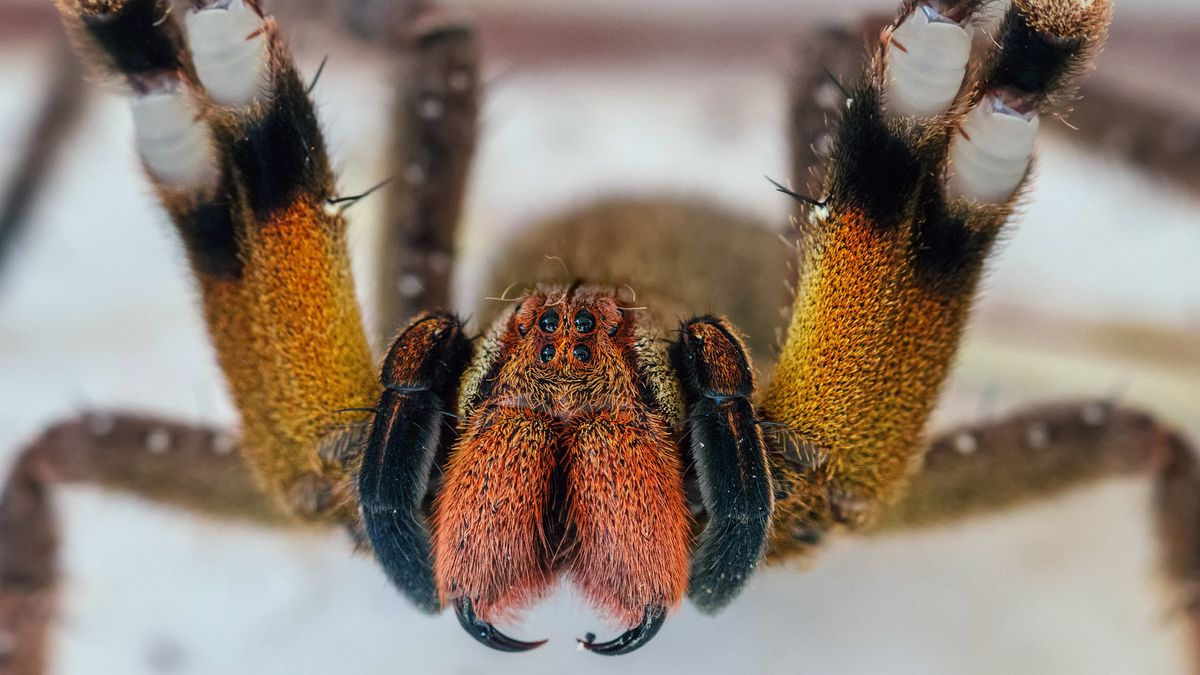
The Brazilian Wandering Spider, also known as the banana spider, is a fascinating and enigmatic creature that hails from the tropical forests of South America. With its vibrant colors, impressive size, and potent venom, this spider has earned a notorious reputation as one of the most dangerous arachnids in the world.
In this article, we will delve into the intriguing world of the Brazilian Wandering Spider and uncover 17 surprising facts about this captivating creature. From its unique hunting techniques to its bizarre reproductive behavior, these facts will shed light on the mysterious nature of this spider and challenge any preconceived notions you may have about them.
Whether you have a fear of spiders or simply have an interest in the wonders of the animal kingdom, prepare to be amazed and astounded as we explore the remarkable features and habits of the Brazilian Wandering Spider.
Key Takeaways:
- The Brazilian Wandering Spider is a venomous nocturnal hunter with unique mating rituals and a surprising nickname, “Banana Spider,” due to its occasional presence in banana shipments.
- Its potent neurotoxic venom can cause painful erections in humans and requires prompt medical attention, but antivenom is available for treatment in areas where the spider is prevalent.
The Brazilian Wandering Spider is one of the most venomous spiders in the world.
With its potent neurotoxic venom, the Brazilian Wandering Spider poses a significant threat to humans and animals alike.
It is found in various parts of South America, including Brazil, Venezuela, and Suriname.
The Brazilian Wandering Spider is native to the rainforests of South America and has adapted to diverse habitats within the region.
Male Brazilian Wandering Spiders have unique leg flaps.
Unlike other spiders, male Brazilian Wandering Spiders have specialized leg flaps that they use to attract females during courtship rituals.
Female Brazilian Wandering Spiders are larger than males.
The females of this species can grow up to 5 inches in leg span, while males are usually smaller, measuring around 3 inches.
They are known for their distinctive hunting behavior.
The Brazilian Wandering Spider does not build a traditional web to catch prey. Instead, it actively hunts for insects, small rodents, and even lizards.
The venom of the Brazilian Wandering Spider can cause painful erections in humans.
A bite from this spider can lead to a condition called priapism, which is characterized by prolonged and painful erections in men.
This spider is also known as the Banana Spider.
The Brazilian Wandering Spider earned its nickname “Banana Spider” due to its occasional presence in banana shipments, causing concerns for importers and consumers.
The Brazilian Wandering Spider has a defensive display known as “threat posture”.
When threatened, this spider raises its front legs, exposing its fangs and warning potential predators of its venomous capabilities.
They possess a potent venom that affects the nervous system.
The neurotoxic venom of the Brazilian Wandering Spider causes symptoms such as severe pain, muscle spasms, respiratory distress, and in rare cases, even death.
Antivenom exists for the treatment of Brazilian Wandering Spider bites.
In areas where the spider is prevalent, antivenom is available to counteract the effects of its potent venom. Prompt medical attention is crucial in these cases.
Brazilian Wandering Spiders have excellent eyesight.
With their eight eyes, these spiders have keen vision and can detect movement from a considerable distance.
They are nocturnal creatures.
The Brazilian Wandering Spider is primarily active during the night, using its superior vision and hunting skills to locate prey.
These spiders can deliver multiple bites in a single attack.
When threatened, the Brazilian Wandering Spider may repeatedly bite its target, increasing the dosage of venom injected into the victim.
Brazilian Wandering Spiders are known to be highly aggressive.
When disturbed or cornered, these spiders are quick to display defensive behavior and may attack without hesitation.
They have bristly hairs on their bodies, known as urticating hairs.
The Brazilian Wandering Spider possesses specialized hairs on its abdomen that can cause irritation and discomfort when they come into contact with the skin.
The Brazilian Wandering Spider is a member of the Ctenidae family.
Belonging to the Ctenidae family, which includes other wandering spiders, the Brazilian Wandering Spider is notable for its unique characteristics.
Female Brazilian Wandering Spiders protect their egg sacs diligently.
After laying their eggs, female Brazilian Wandering Spiders guard their egg sacs fiercely to ensure the survival of their offspring.
The Brazilian Wandering Spider is undoubtedly one of the most fascinating creatures in the animal kingdom. Their unique characteristics and behaviors make them a subject of both awe and fear. From their lethal venom to their uncanny ability to wander into unexpected places, these spiders have managed to capture the attention of researchers and enthusiasts alike.
Understanding the 17 surprising facts about the Brazilian Wandering Spider gives us a glimpse into their world and highlights their significance in the ecosystem. From their impressive hunting techniques to their role as both predator and prey, these spiders play a vital role in maintaining the balance of nature.
While encountering a Brazilian Wandering Spider in the wild might be a rarity for many, it’s important to respect these creatures and appreciate their beauty from a safe distance. By learning more about them, we can cultivate a greater understanding and appreciation for the diverse and awe-inspiring world of animals.
Q: Are Brazilian Wandering Spiders really dangerous?
A: Yes, they are. Brazilian Wandering Spiders are considered one of the most venomous spiders in the world. Their bite can be fatal if not treated promptly.
Q: Where are Brazilian Wandering Spiders found?
A: These spiders are native to various regions in South America , including Brazil, Ecuador, and Peru.
Q: How big do Brazilian Wandering Spiders get?
A: Adult Brazilian Wandering Spiders can have a leg span of up to 6 inches, making them one of the largest spiders in the world.
Q: What do Brazilian Wandering Spiders eat?
A: They primarily feed on insects, but they have also been known to eat small reptiles and amphibians.
Q: Are Brazilian Wandering Spiders aggressive?
A: Brazilian Wandering Spiders can exhibit aggressive behavior if they feel threatened. It’s important to exercise caution and avoid provoking them.
Was this page helpful?
Our commitment to delivering trustworthy and engaging content is at the heart of what we do. Each fact on our site is contributed by real users like you, bringing a wealth of diverse insights and information. To ensure the highest standards of accuracy and reliability, our dedicated editors meticulously review each submission. This process guarantees that the facts we share are not only fascinating but also credible. Trust in our commitment to quality and authenticity as you explore and learn with us.
Share this Fact:
The world's deadliest spider? The answer is poisonous (and unexpected.)

Afraid of spiders? Your aversion might actually be wise. Though the many-legged arachnids are a great deal smaller than we are, some can be extremely dangerous with bites that could end a human life.
No need to fear too much if you walk through a web though, not all spiders are so threatening. And, even for the ones that are, advances in anti-venom technology have made treatment more effective.
Understanding the true danger of certain spiders requires a few myths to be busted first. Here’s everything you need to know about which arachnids to avoid from daddy long legs to tarantulas to black widows.
What is the deadliest spider in the world?
The funnel web spider is widely regarded as the most dangerous arachnid. This Australian spider has a venom that is packed with 40 different toxic proteins.
Though a bite from one of these creatures is certainly capable of killing a human, no deaths have been reported from a funnel web spider in Australia since 1980 .
Are daddy long legs poisonous?
Not in any dangerous way. But wait, aren’t daddy long legs the most dangerous spider in the world? No, this is a myth . While it is true that daddy long legs are venomous, all this means is they anatomically have specific glands used for the production of venom.
“Daddy long legs” is actually an umbrella term that is used to refer to three different groups: pholcid house spiders, crane flies (which are not arachnids at all), and harvestmen. The last two have no venom at all while the first does carry venom but not any that is especially dangerous or has been reported to cause a reaction in humans. This form of “daddy long legs” does have fangs and can therefore likely bite you, but there is no evidence showing it will be harmful.
What are the deadliest spiders?
There is some debate around this topic. But, according to CBS News , ten of the deadliest spiders include:
- Sydney funnel-web spider
- Redback spider
- Chilean recluse spider
- Brazilian wandering spider
- Sicarius spiders
- Brown recluse spiders
- Black widow spiders
- Hairy mystery spiders
- Brown widow spiders
- Katipo spiders
Encyclopedia Britannica adds Yellow Sac spiders, Red Widow spiders, and Wolf spiders to that list.
Can a black widow kill you?
Rarely . A black widow bite only poses a high health risk for young children and the elderly, especially given advancements in anti-venom medical technology.
Black widows are indeed the most venomous spider in North America though (Australian spiders have a special claim to fame). Their venom has a chemical called alpha-latrotoxin which causes intense pain, cramping, swelling, sweating and chills.
If you visit a doctor, they might give you antivenom to treat the bite which will neutralize the venom and relieve some of the pain.
Are banana spiders poisonous?
Banana spider are not poisonous and are generally not considered a grave danger to humans, though their bite can be painful .
There is one type of banana spider known as the Brazilian wandering spider which can, in rare cases, cause intense symptoms. This is not a spider usually found in the U.S.
Are wolf spiders poisonous?
Wolf spiders, like banana spiders are venomous but not poisonous . Their bites are not known to cause serious harm to humans.
People can have allergic reactions to the venom , but this is not common.
Are tarantulas poisonous?
Tarantulas do not pose a major health risk . Their venom has very low toxicity to humans. So, despite their unsettling appearance, there’s very little reason to fear these furry creatures.
Just curious for more? We've got you covered
USA TODAY is exploring the questions you and others ask every day. From "How to get rid of gnats? " to " How many Spiderman movies are there? " to " How to cancel Apple Music? ", we're striving to find answers to the most common questions you ask every day. Head to our Just Curious section to see what else we can answer for you.
- International edition
- Australia edition
- Europe edition
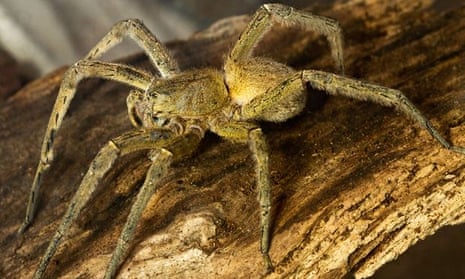
Venomous spider found in Waitrose shopping 'beautiful but aggressive'
While most spiders scurry away when confronted, the Brazilian wandering spider stands its ground, says David Clarke of London Zoo
Killer spider found in family’s supermarket shopping
- How dangerous are Britain’s household spiders
The Brazilian wandering spider – which according to reports over the weekend emerged from a South London family’s Waitrose delivery – is one of the most infamous species of venomous spider.
It is actually a very beautiful spider, quite big, with about a 15-centimetre (six-inch) leg span. It is also quite aggressive, and while most spiders run away when confronted, the Brazilian wandering spider might stand its ground and has a particularly impressive stance – it rears up on its back legs and looks quite menacing. If it feels threatened it adopts an “attack first, ask questions later” sort of defence.
The species of Brazilian wandering spider that people tend to talk about are Phoneutria fera and Phoneutria nigriventer , which sometimes come into the UK – mainly because of things like fruit being imported. Accidentally imported spiders such as the one encountered by the family in South London are rare these days, however, because importers tend to clean off the fruit very well. There’s still the slight chance that one might be hidden away in a hand of bananas and get through.
Venom and bites
Although many types of spider have a venomous bite, the Brazilian wandering spider is one of the four types that have a more potent venom, and as such you would need a Dangerous Wild Animals (DWA) licence to keep it as a pet. Although spider bites do happen in South America, where this species is common, they are incredibly rare in the UK, and antivenins are available to counteract their venom.
As with most spiders, the Brazilian wandering spider will tackle things that are its own size. So in most cases that’s going to be large insects, but it will also take on small snakes, frogs and anything else it comes across that it can grab hold of. The venom is there mainly to subdue prey, but also as a warning: they have red hairs around the fangs and so a lot of animals know to leave them alone. It is a bit of an evolutionary quirk that some species have venom that has such a potent effect on big mammals such as ourselves.
Once the prey has been bitten, the venom immobilises and kills it, then the spider injects enzymes that break down the body tissues. The spider is then able to consume it.
Any time people are badly affected by a spider bite, the news tends to be plastered all over the press, blowing it out of proportion. Very few people get bitten by spiders or get a serious reaction to the bite. So it’s worth putting this in context. There are relatively few cases where the Brazilian wandering spider has actually caused any problems.
Can it survive the Great British weather?
The Brazilian wandering spider can’t survive our climate. It is a tropical species and there’s no expectation that it will be able to survive our harsh winters – that’s one thing we’re kind of lucky about if you want to look at it that way. What’s more, a centrally heated home during winter is a dry habitat that is not a good atmosphere for tropical spiders, and it probably won’t provide enough food for them.
We run the Friendly Spider Programme at ZSL London Zoo to treat people with arachnophobia because fear of spiders is very common. We teach people that houses are generally not great habitats for spiders.
But these are very valuable creatures. We’d be in serious trouble if there weren’t spiders around. In particular they act as biological controls, eating lots of other pests and creatures that might be more of a problem and pass on disease to humans. So the odd reported case of a spider bite is not that bad considering the enormously positive things they do generally.
Dave Clarke, head of invertebrates at ZSL London Zoo , was speaking to Guardian trainee journalist Aisha Gani
- Animal behaviour

Scorpion found in London home of BBC 6 Music presenter Ben Watt

Ed Balls photobombed by spider on BBC News

Spider photobombs BBC Scotland news
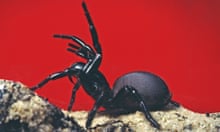
You call that a deadly spider? Australia's funnel web can kill in 15 minutes
Spider photobombs bbc scotland news - video.
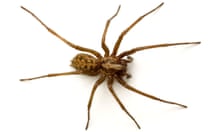
Spider season is upon us – and so are the scare stories
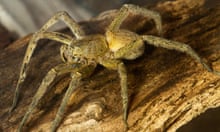
Attack of the killer spiders and other stories sure to upset all arachnophobes
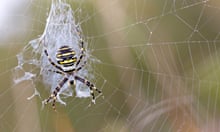
Spider app launched by ecologists
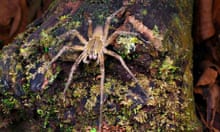
Essex woman finds eggs of world's most venomous spider in her shopping

Most viewed

Local News X
30 Most Venomous Animals In The World
Posted: April 25, 2024 | Last updated: April 25, 2024
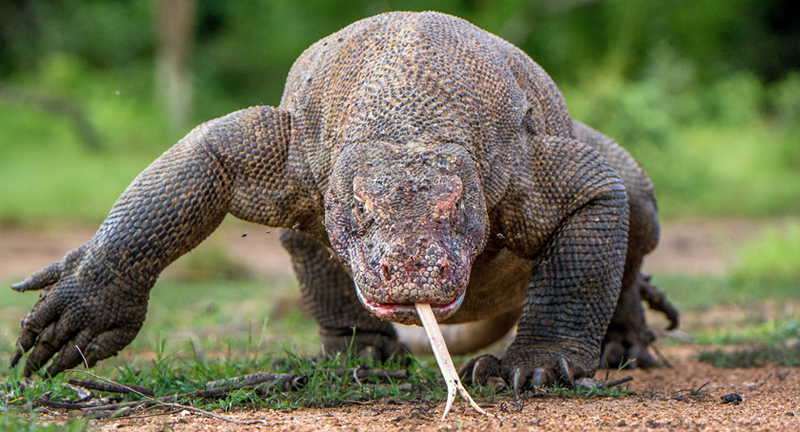
In the vast tapestry of the animal kingdom, a diverse array of creatures possess unique adaptations that make them remarkable, not least of which are those equipped with potent toxins. From the depths of the ocean to the dense foliage of tropical rainforests, venomous and poisonous animals command a respect born of both fear and fascination. These animals, equipped with chemical arsenals capable of paralyzing, incapacitating, or even killing, serve as a stark reminder of nature’s raw power and ingenuity. This compilation explores a selection of the world’s most poisonous and venomous creatures, shedding light on their lethal abilities, habitats, and the complex roles they play in their ecosystems.
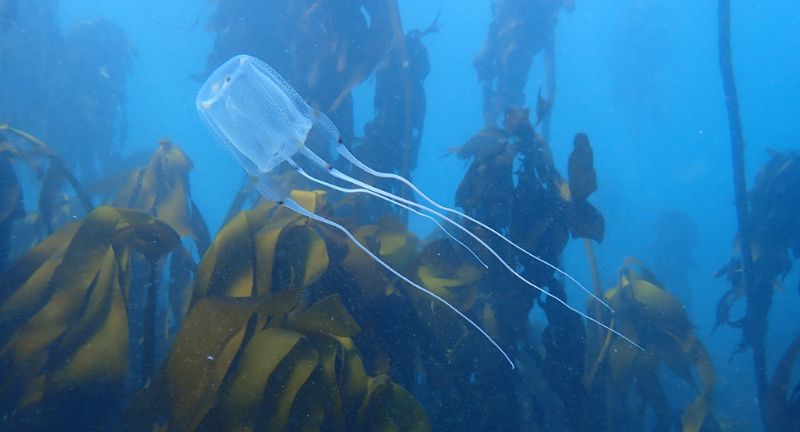
Box Jellyfish
The Box Jellyfish is regarded as one of the most dangerous jellyfish in the world, with venom that is extremely potent and capable of causing death in humans within minutes after contact. Its nearly transparent tentacles are lined with thousands of nematocysts, each capable of delivering a painful and potentially fatal sting. The venom attacks the heart, nervous system, and skin cells. Despite its lethal nature, antivenom does exist and can be life-saving if administered promptly.

Inland Taipan
The Inland Taipan is often cited as the world’s most venomous snake, possessing venom that is highly toxic and capable of killing a human in less than an hour after a bite. Native to the arid regions of central Australia, its venom contains a complex mix of neurotoxins, myotoxins, and coagulants that can cause hemorrhaging and muscular paralysis. Despite its deadly potential, the Inland Taipan is shy and reclusive, preferring to avoid human contact. Bites are extremely rare, and antivenom is available and effective in treating its venomous bite.
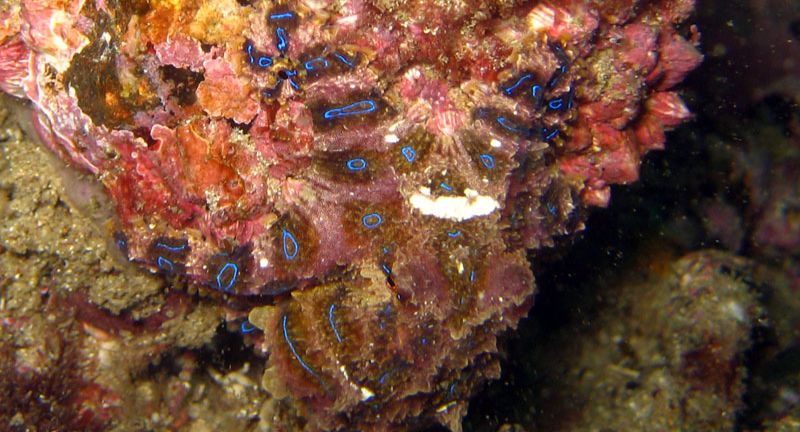
Blue-Ringed Octopus
The Blue-Ringed Octopus is deceptively dangerous, with a venom that contains tetrodotoxin, one of the most toxic substances known. Despite its small size, the venom is powerful enough to paralyze and kill humans, with no known antivenom. The octopus is characterized by its beautiful blue rings, which become more pronounced when it feels threatened. Victims often don’t realize they’ve been bitten until respiratory depression and paralysis begin to set in.
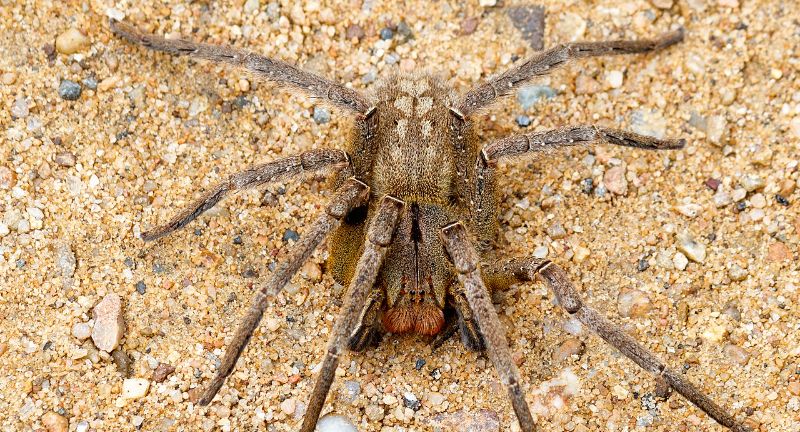
Brazilian Wandering Spider
The Brazilian Wandering Spider is considered the world’s most venomous spider, known for its aggressive behavior and potent venom that can be lethal to humans, especially children. This spider is highly adaptable and often found in a variety of environments, from forests to human dwellings. Its venom can cause severe pain, inflammation, and, in severe cases, paralysis and death. An effective antivenom has made fatalities rare when medical treatment is promptly received.
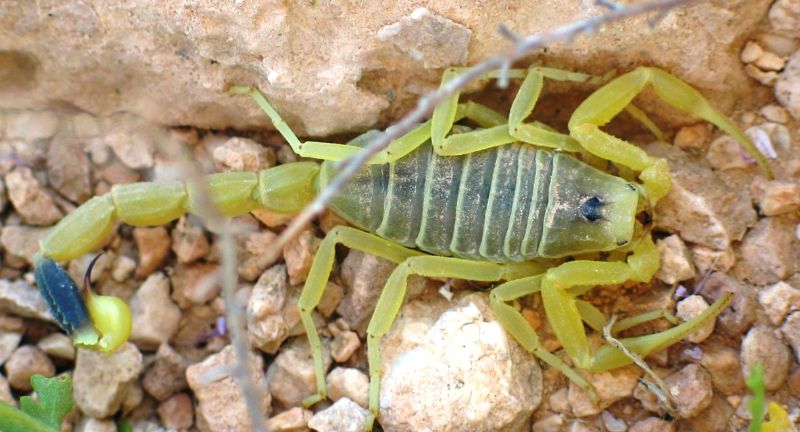
Death Stalker Scorpion
The Death Stalker Scorpion’s venom is among the most potent of all scorpion species, capable of causing extreme pain, paralysis, and even death in humans. Found primarily in North Africa and the Middle East, this scorpion prefers dry and desert regions. Its venom contains a powerful mix of neurotoxins that can lead to severe neurological problems and heart issues. While dangerous, fatalities are relatively rare, especially with access to medical care and antivenom.
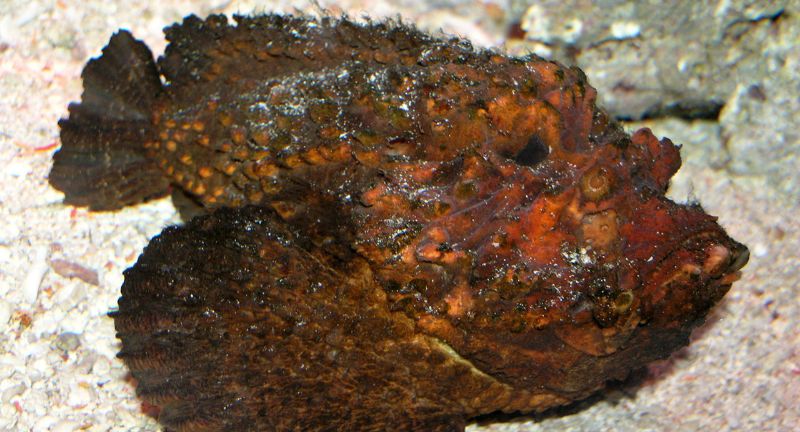
The Stonefish is the most venomous fish in the world, capable of inflicting intense pain and possible death through its venomous dorsal fin spines. Its camouflaged appearance allows it to blend seamlessly with its surroundings, making it a hidden danger to unwary swimmers and divers. The venom can cause shock, paralysis, and tissue death if not treated immediately. Fortunately, an antivenom exists, and immediate treatment can greatly reduce the severity of the symptoms.

Cone Snails are marine creatures with a venomous harpoon that can deliver a potent toxin, capable of killing twenty humans with just one drop of its venom. They are found in warm and tropical seas and are known for their beautiful, ornate shells. The venom of the Cone Snail is a complex mixture of hundreds of different toxins, affecting the nervous system, muscle function, and heart rate. There is no antivenom available, making prompt medical attention crucial for survival.
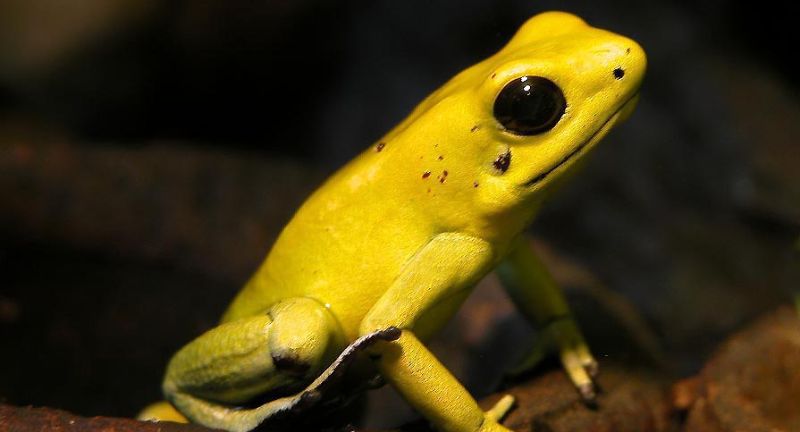
Golden Poison Frog
The Golden Poison Frog is one of the most toxic animals on earth, with skin that secretes a poison capable of killing many humans. This small amphibian, native to the rainforests of Colombia, uses its brightly colored skin as a warning to potential predators. The poison, called batrachotoxin, blocks nerve signals to muscles, causing paralysis and death. Interestingly, the frog’s toxicity is believed to be derived from its diet of certain insects.
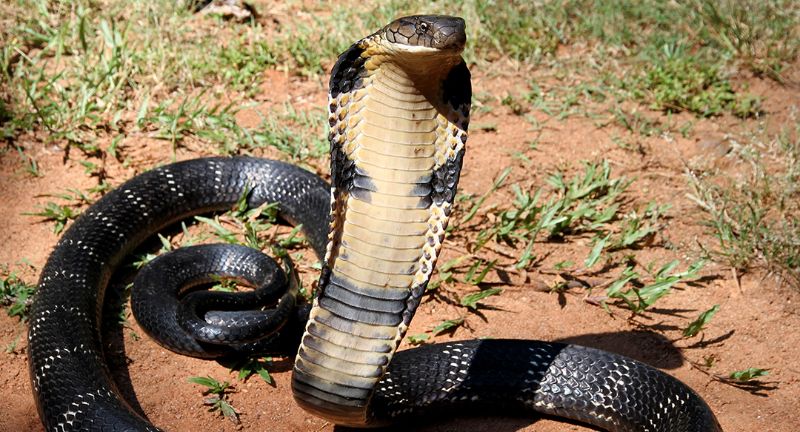
The King Cobra, the world’s longest venomous snake, is revered and feared for its impressive length and potent neurotoxic venom. Capable of delivering a large volume of venom in a single bite, it can kill a human within 30 minutes. The King Cobra’s venom attacks the respiratory system, leading to respiratory failure and death if untreated. Despite its fearsome reputation, the King Cobra generally avoids humans and attacks only when provoked or threatened.

Pufferfish are among the most poisonous vertebrates in the world, containing tetrodotoxin, a substance that is toxic to humans if ingested. This toxin is found in the fish’s skin, muscle tissue, liver, and gonads, requiring chefs who prepare the delicacy fugu (pufferfish) to undergo years of training. Tetrodotoxin blocks sodium channels on nerve cells, preventing nerves from firing and leading to paralysis and death. Despite the risk, pufferfish remains a sought-after delicacy in many parts of the world.

Africanized Honey Bee
Africanized Honey Bees, also known as “killer bees,” are more aggressive than other honey bee species and are known to chase people for over a quarter of a mile once they get agitated. They were created by cross-breeding African and European honey bees. Although their venom is not more potent than that of regular honey bees, the danger comes from their tendency to attack in large numbers, which can result in hundreds of stings. This aggressive behavior has led to fatalities, especially in individuals with allergies to bee stings.
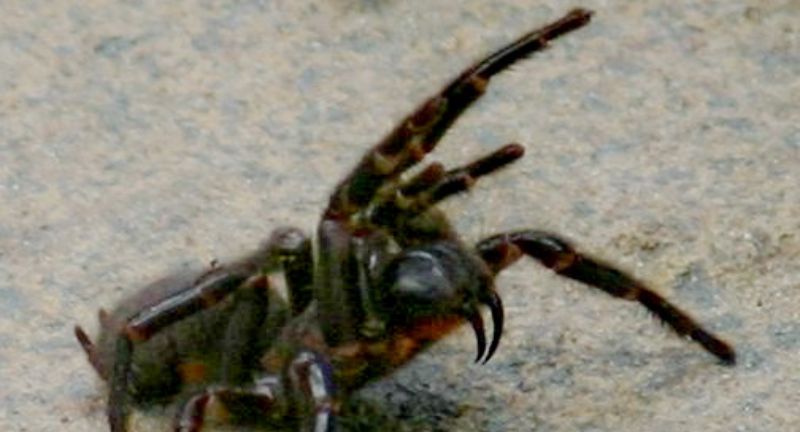
Sydney Funnel-Web Spider
The Sydney Funnel-Web Spider is highly venomous, capable of causing death in humans within 15 minutes of a bite. Found in the Sydney region of Australia, this spider’s venom contains a powerful neurotoxin that is particularly toxic to primates, including humans. Symptoms of a bite can include severe pain, difficulty breathing, and muscle twitching. Thanks to the development of an effective antivenom in 1981, there have been no recorded fatalities since its introduction.

Marbled Cone Snail
The Marbled Cone Snail is another species of cone snail that poses a deadly risk to humans, with venom capable of causing paralysis and death. Its beautiful, intricate shell belies the danger it contains, as it uses a harpoon-like tooth to inject its venom into its prey. The venom is a potent cocktail of toxins that can disrupt the nervous system, leading to respiratory failure and death. There is no specific antivenom for the Marbled Cone Snail, making any encounter with it potentially fatal.
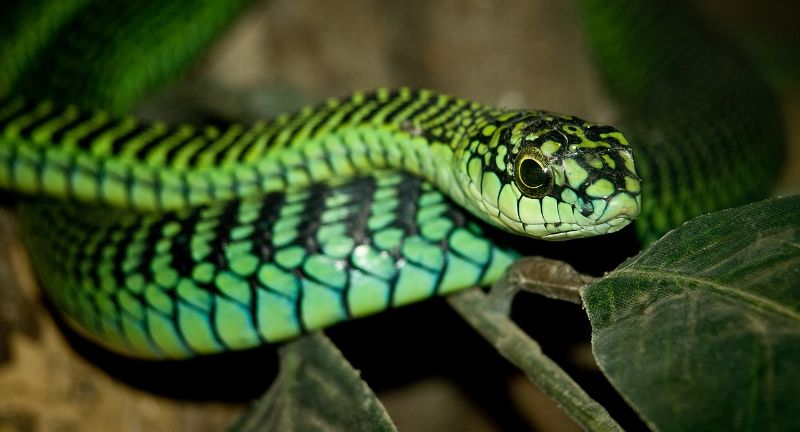
The Boomslang is a highly venomous tree-dwelling snake found in sub-Saharan Africa, known for its potent hemotoxic venom. Unlike many venomous snakes that deliver venom through front fangs, the Boomslang has large, rear-positioned fangs and can open its jaw up to 170 degrees when biting. Its venom causes extensive bleeding, both internally and externally, by inhibiting blood coagulation. Although it is generally shy and avoids humans, a bite from a Boomslang can be fatal without prompt medical treatment.

Harvester Ant
Harvester Ants are recognized for their painful sting, which is significantly more toxic than that of bees or wasps. Found in the United States, these ants inject a venom that can cause allergic reactions and, in rare cases, death in sensitive individuals. The venom is packed with toxins that can attack the nervous system and cell membranes. Despite their small size, the intensity of the pain from their sting is such that it can deter much larger predators.

Gila Monster
The Gila Monster is one of the few venomous lizards in the world, found primarily in the southwestern United States and northern Mexico. Its bite delivers venom through grooves in the teeth rather than injection, requiring the lizard to chew to introduce the toxin. The venom causes pain, swelling, and can lead to hypotension and respiratory distress. While not typically fatal to humans, the effects of a Gila Monster bite can be seriously debilitating without proper treatment.
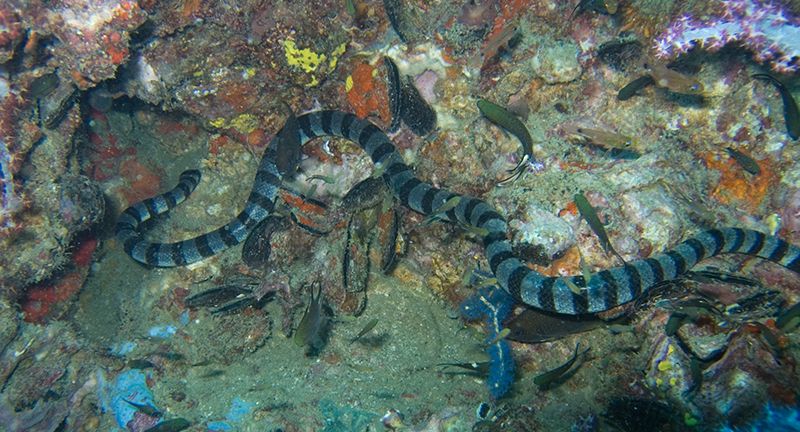
Sea Snakes are highly venomous and inhabit marine environments in the Indian and Pacific oceans. Their venom is neurotoxic, causing muscle damage, paralysis, and sometimes renal failure. Despite their potency, sea snakes are generally docile and bites are rare, occurring mostly when the snakes are handled or stepped on. Effective antivenom exists, but due to their pelagic nature, immediate treatment is not always accessible.
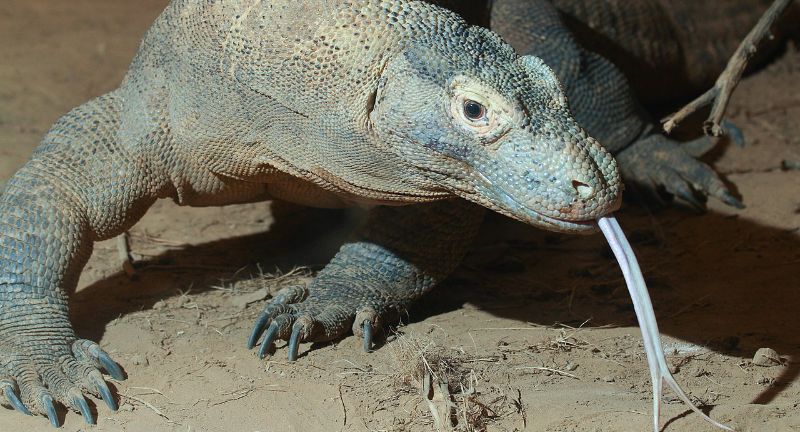
Komodo Dragon
The Komodo Dragon, the largest living species of lizard, does not have traditional venom but uses a different method to debilitate its prey. Its saliva is loaded with bacteria, and recent studies suggest the presence of venomous proteins that can lead to rapid blood loss and shock in its victims. Native to the Indonesian islands of Komodo, Rinca, Flores, and Gili Motang, these giants are apex predators. While attacks on humans are rare, they can be deadly due to the potent combination of bacterial infection and venomous proteins.
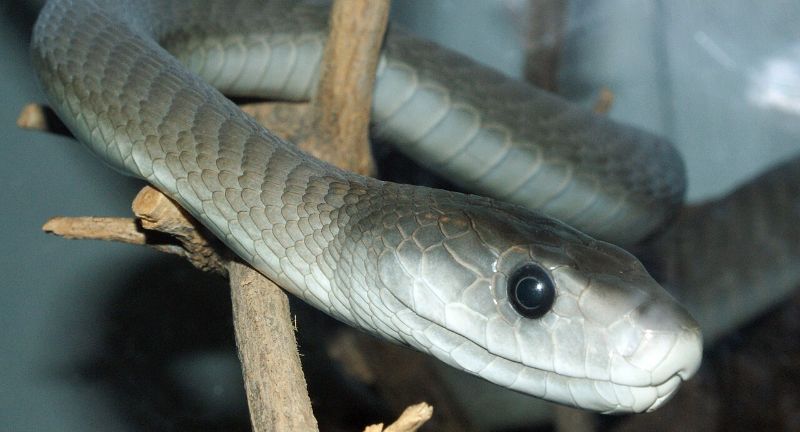
Black Mamba
The Black Mamba is feared throughout Africa for its speed, aggression, and highly toxic venom. A single bite can deliver enough neurotoxic venom to kill ten people, with death potentially occurring within 20 minutes to several hours if left untreated. The venom quickly spreads through the victim’s body, leading to symptoms such as difficulty breathing, paralysis, and eventually, respiratory failure. Despite its deadly capabilities, the Black Mamba only attacks humans when threatened or cornered.
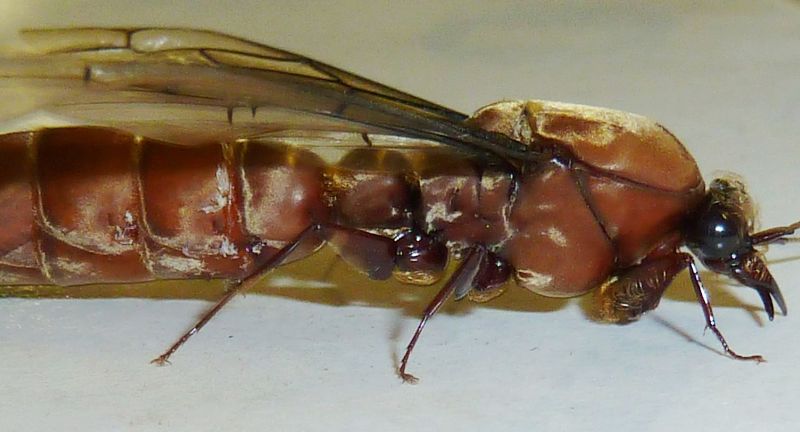
Siafu – African Driver Ants
Siafu, or African Driver Ants, are known for their aggressive behavior and the ability to overwhelm and kill much larger animals, including humans, in large numbers. These ants do not possess venom but can inflict painful bites with their large mandibles. They are highly social and organized, capable of forming large colonies that move through the forest floor, consuming everything in their path. While individual bites are not lethal, the sheer number of ants can lead to asphyxiation and death in trapped or incapacitated victims.
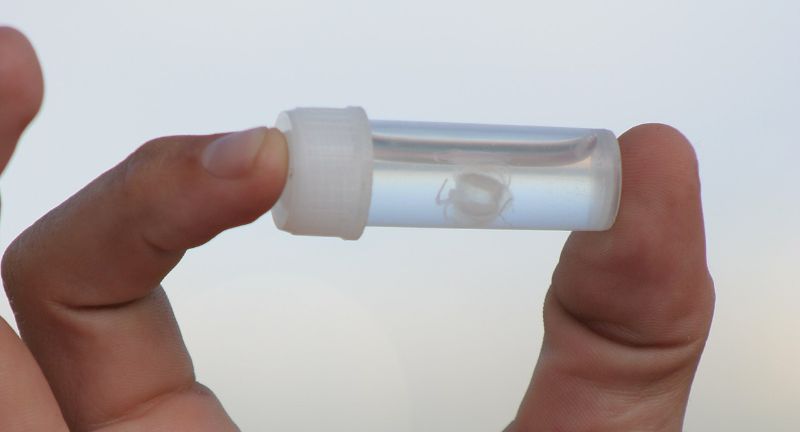
Irukandji Jellyfish
The Irukandji Jellyfish is a tiny but extremely venomous jellyfish, capable of causing Irukandji syndrome, a condition that can be fatal. Found in the waters of northern Australia, this jellyfish’s sting may initially seem minor, but it can quickly lead to severe muscle cramps, high blood pressure, and potentially fatal cardiac issues. The jellyfish is so small and its tentacles so thin that swimmers may not even realize they’ve been stung until symptoms begin to appear. Despite its size, the Irukandji’s potent venom makes it one of the most dangerous marine creatures.
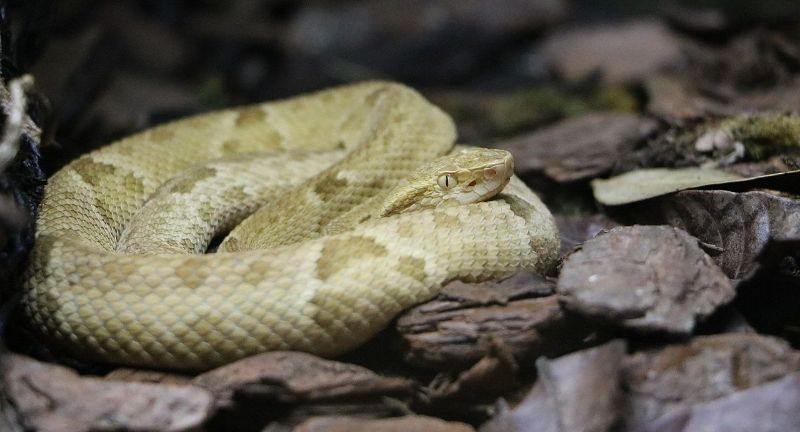
Lancehead Vipers
Lancehead Vipers are responsible for more human fatalities in their range than any other group of snakes, primarily due to their potent hemotoxic venom. Found in South America, their venom can cause severe tissue damage, internal bleeding, and can be fatal if not treated promptly. These snakes are highly adaptable and can be found in a variety of habitats, from rainforests to open plains. Their aggressive nature and tendency to bite when threatened make them particularly dangerous to humans.
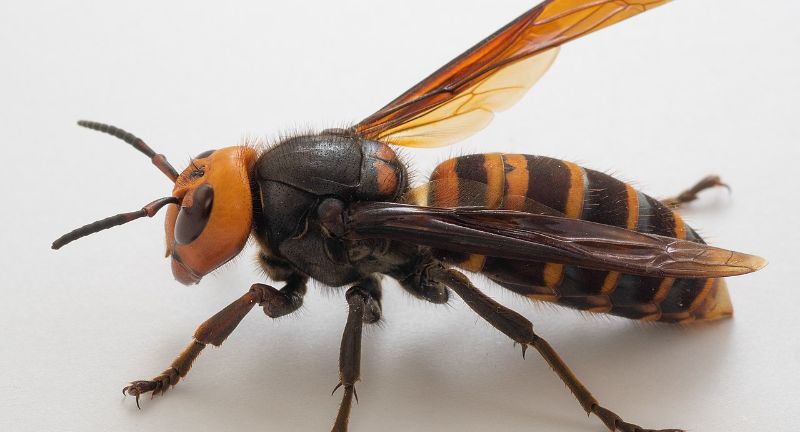
Asian Giant Hornet
The Asian Giant Hornet, also known as the “murder hornet,” has garnered attention for its size, aggressive nature, and potent venom. A single sting from this hornet can cause severe pain and, in some cases, death, particularly in individuals allergic to its venom. They are capable of decimating bee populations, posing a significant threat to biodiversity and agriculture. The venom contains a neurotoxin that can cause organ failure and death in severe cases, underscoring the danger these insects pose.
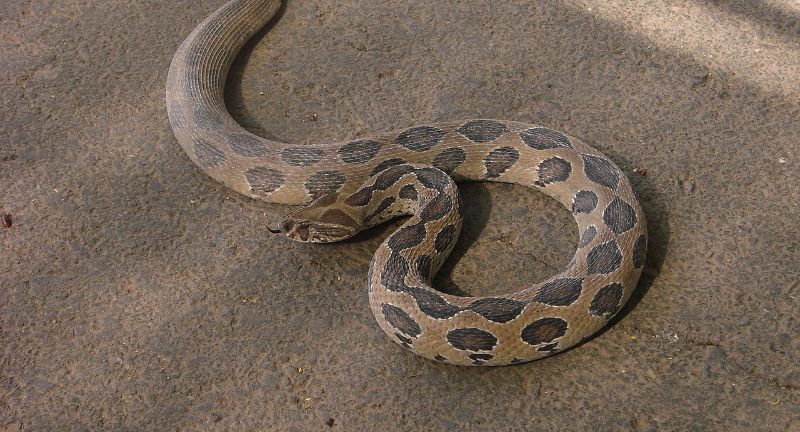
Russell’s Viper
Russell’s Viper is known for causing the most snakebite incidents and deaths among all venomous snakes in Asia. Its venom is highly toxic, causing pain, swelling, and in severe cases, blood clotting disorders, kidney failure, and death. This species is widespread across the Asian continent, found in fields and urban areas where it often comes into contact with humans. Despite its dangerous reputation, Russell’s Viper plays a crucial role in controlling rodent populations, highlighting the complex relationship between humans and wildlife.

Eastern Brown Snake
The Eastern Brown Snake is one of the deadliest snakes in the world, second only to the inland taipan in terms of venom toxicity. Native to Australia, this snake is highly aggressive and is responsible for more deaths in Australia than any other group of snakes. Its venom contains neurotoxins and blood coagulants, leading to paralysis and uncontrollable bleeding. Prompt medical treatment with antivenom is crucial for survival following a bite from an Eastern Brown Snake.
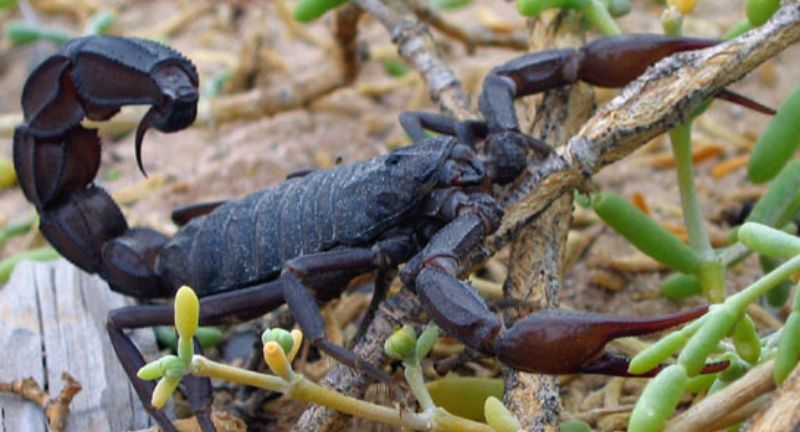
Androctonus Scorpions
Androctonus Scorpions, also known as Fat-tailed Scorpions, are among the most dangerous scorpions in the world. Their venom is highly toxic and can cause severe pain, fever, convulsions, and even death in humans. Found in North Africa and the Middle East, these scorpions are well-adapted to desert environments. Despite their deadly potential, fatalities are rare with access to medical treatment and antivenom.
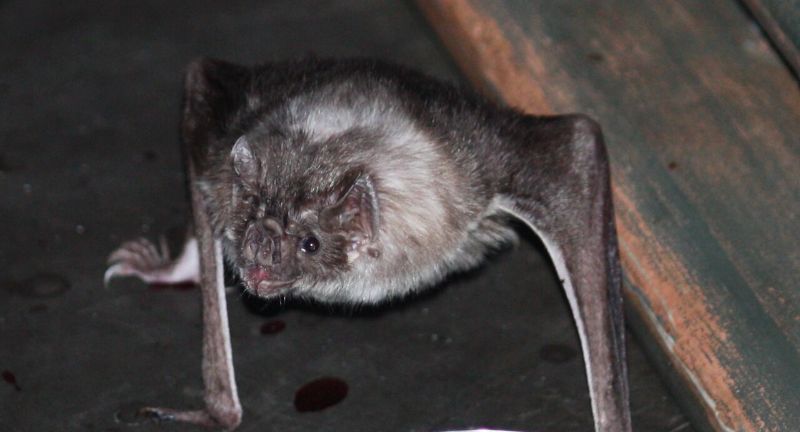
Vampire Bat
Vampire Bats are unique among mammals for their diet consisting entirely of blood, a trait known as hematophagy. Found in Mexico, Central America, and South America, these bats have evolved anticoagulant saliva that prevents their prey’s blood from clotting while they feed. While the bite of a vampire bat is rarely harmful to healthy animals, they can spread diseases, such as rabies, to livestock and humans. Their nocturnal habits and eerie feeding method have made them a subject of myths and misconceptions, overshadowing their fascinating adaptations and role in their ecosystems.

Dart Frogs, belonging to the family Dendrobatidae, are known for their vivid colors and potent toxins. Native to Central and South America, these small amphibians produce skin toxins that are among the most powerful natural poisons known. The indigenous people have historically used their poison for hunting by applying it to blow darts, hence the name. While beautiful, these frogs are a stark reminder of nature’s rule that sometimes the most dangerous creatures come in the smallest, most vibrant packages.

Arizona Bark Scorpion
The Arizona Bark Scorpion is the most venomous scorpion in North America, known for its painful and potentially deadly sting. This scorpion’s venom can cause severe pain, numbness, and, in rare cases, severe allergic reactions that can be fatal. Found primarily in the desert regions of the Southwestern United States, the Arizona Bark Scorpion is nocturnal and often enters homes, increasing the risk of human encounters. Despite its fearsome reputation, fatalities are extremely rare, especially with medical treatment.
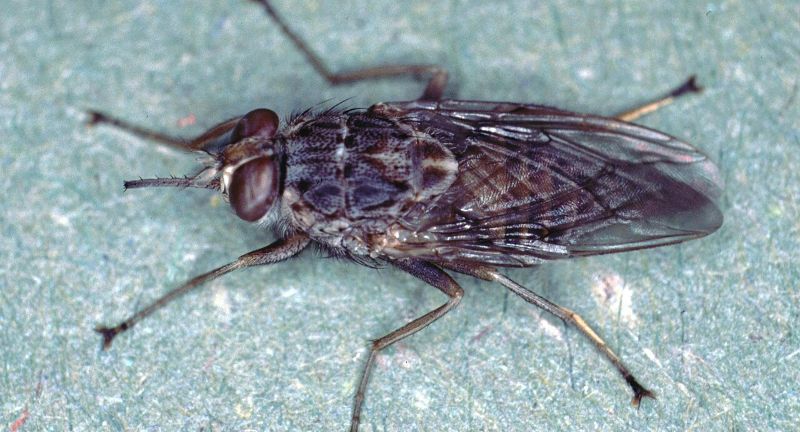
The Tsetse Fly is infamous for transmitting trypanosomiasis, or sleeping sickness, a disease that can be fatal if not treated. Found across sub-Saharan Africa, these flies inject a parasite that affects the human central nervous system, leading to severe neurological disorders and, if untreated, death. Their ability to transmit disease makes them a significant health threat in affected regions. Efforts to control their population and prevent disease transmission are ongoing, highlighting the challenge they pose to public health.
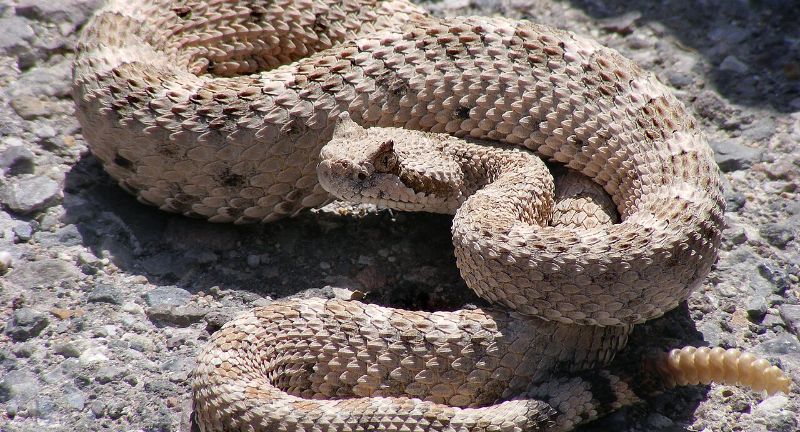
The realm of venomous and poisonous animals is as enthralling as it is perilous, offering a glimpse into the evolutionary arms race that has shaped the natural world. These creatures, with their lethal venoms and toxins, not only highlight the diversity of life on Earth but also underscore the delicate balance within ecosystems, where such deadly attributes play a crucial role in survival and predation. As we delve into the mysteries and marvels of these formidable beings, we are reminded of the importance of respecting and preserving the natural habitats that nurture them. Their existence, while posing risks, enriches our planet’s biodiversity and provides invaluable insights into the complexity and interconnectedness of life.
For the Latest Breaking Local News, Headlines & Videos, head to Local News X
More for You
Trump campaign accused of breaking federal law by hiding millions in legal payments

Netflix hit watched more than 21 million times in its first three days
I Lost 100lbs by Following 4 Rules
24 Food Myths That Are Getting Thrown Out With The Trash
Common Foods That Are Illegal to Grow in Your Backyard
Barber Coins Are Worth Thousands: Here’s How To Spot Them in Your Spare Change
Meta loses nearly $200 billion in value after Mark Zuckerberg announcement
10 most ‘overpriced’ tourist attractions in the world – and three are in the US
Putin Ally Draws Red Line for 'Legitimate Targets' in NATO Country
Baking Soda Makes a Great DIY Weed Killer—Here's How to Use It
"GMA" Fans Congratulate Robin Roberts as She Announces Major Career Achievement
25 High-Protein Meals That'll Fill You Up for Hours
19 Safety Features That Are The Opposite Of Safe
10 Countries To Live Outside the US That Are So Cheap You Could Quit Your Job
Donald Trump Trial Suddenly Erupts in Shouting
Jimmy Butler trolls Celtics after Heat's Game 2 win
Blood pressure is best lowered by 2 exercises, study finds
If Your Plant Leaves Have Brown Tips, This is What it Means
Dua Lipa Makes History on Hot Dance/Electronic Songs Chart at Nos. 1, 2 & 3
At 43, I’ve finally learned how to love my size 16 curves

IMAGES
VIDEO
COMMENTS
Guinness World Records has previously named the Brazilian wandering spider the world's most venomous spider multiple times (though the current record-holder is the Sydney funnel-web spider, Atrax ...
The Brazilian Wandering Spider (Phoneutria fera) is an aggressive and highly venomous spider.It was first discovered in Brazil hence its name. However, this genus is known to exist elsewhere in South and Central America.. The Brazilian Wandering spider is a member of the Ctenidae family of wandering spiders.
The Brazilian wandering spider is a highly venomous and aggressive spider. Also known as the 'banana' spider (because these spiders are frequently found in shipments of bananas), the Brazilian wandering spider 'wanders' the jungle floor as opposed to living in a lair or building a web.
Brazilian Wandering Spider Profile. There are more than 50,000 species of spider, and the vast majority are less dangerous than a honeybee. Almost none are aggressive, and of those with medically significant venom, only a small percentage are capable of causing death. So, on the whole, arachnophobes are just being a bit silly.
The Brazilian Wandering Spider is a venomous arachnid with a fearsome reputation. This South American rainforest dweller packs a powerful punch, but don't let its nickname "banana spider" fool you - they're active hunters, not web-spinners. Despite their size and venom, bites are uncommon as they're typically shy.
Phoneutria is a genus of spiders in the family Ctenidae.They are mainly found in northern South America, with one species in Central America. Members of the genus are commonly referred to as Brazilian wandering spiders. Other English names include armed spiders (armadeiras in Brazilian Portuguese) and banana spiders (a name shared with several others).
In fact, the Brazilian Wandering Spider is the most venomous spider in the New World! In South America, these true spiders are commonly encountered in peoples' homes, supposedly hiding in peoples' shoes, hats, and other clothes. The Brazilian Wandering Spider does not remain on a web, rather, it wanders the forest floor, hence the name."
Brazilian wandering spider brazilian wandering spider size Their body length ranges from 17 to 48 mm (43⁄64 to 1+57⁄64 in).Phoneutria are impressive spiders reaching body sizes up to 3.5 centimeters and leg spans up to 15 centimeters. They are nocturnal, hunting at night, and hiding in dark places during the…
The Brazilian wandering spider, scientifically known as Phoneutria, Maximilian Perty kickstarted the Phoneutria genus in 1833. The name comes from the Greek word φονεύτρια, which means "murderess" and falls under the Animalia kingdom, Arthropoda phylum, and Arachnida class. Within Arachnida, it is classified in the order Araneae ...
The Brazilian Wandering Spider, known scientifically as Phoneutria, harbors a venomous arsenal that stands as a testament to nature's intricate design. This spider's venom contains a potent concoction of neurotoxic compounds, tailored by evolution to incapacitate its prey swiftly and efficiently. The neurotoxins interfere with nerve cell ...
The Brazilian Wandering Spider is found in the rainforests of South America. These rainforests are the world's largest and most biodiverse terrestrial ecosystems, covering an area of approximately 6.7 million square kilometers. The spider is striking, with a shiny brown or black body covered in short fine hairs.
The armed spider only follows the world's most venomous spider, which according to the Guinness World Records, is the Sydney funnel-web spider (Atrax robustus).. Like the Brazilian wandering ...
Other articles where Brazilian wandering spider is discussed: wandering spider: The Brazilian wandering spiders, Phoneutria fera and P. nigriventer, are sometimes also referred to as banana spiders because they are frequently found on banana leaves. They have an aggressive defense posture, in which they raise their front legs straight up into the air. Phoneutria are venomous,…
Recognizing a Brazilian Wandering Spider. 1. Watch out for 6-inch (15 cm) long spiders with leg span. Adult Brazilian wandering spiders have a body that's about 2 inches (5 cm) large. Their leg span, which may be easier to recognize, is about 6 inches (15 cm) in length.
The Brazilian Wandering Spider is a venomous nocturnal hunter with unique mating rituals and a surprising nickname, "Banana Spider," due to its occasional presence in banana shipments. Its potent neurotoxic venom can cause painful erections in humans and requires prompt medical attention, but antivenom is available for treatment in areas ...
Wandering spider, any member of the arachnid family Ctenidae (order Araneida), a small group of large venomous spiders of mainly tropical and subtropical regions, commonly found on foliage and on the ground. Their first two legs are armed with strong bristles on the lower side. ... The Brazilian wandering spiders, Phoneutria fera and P ...
There is some debate around this topic. But, according to CBS News, ten of the deadliest spiders include: Sydney funnel-web spider. Redback spider. Chilean recluse spider. Brazilian wandering ...
The brown recluse spider is one of the most dangerous spiders in the United States. Its venom destroys the walls of blood vessels near the site of the bite, sometimes causing a large skin ulcer. ... England, had to move out of their home so it could be fumigated, because it became infested with tiny Brazilian wandering spiders. An egg sac ...
The Brazilian wandering spider - which according to reports over the weekend emerged from a South London family's Waitrose delivery - is one of the most infamous species of venomous spider.
The Sydney funnel-web spider (Atrax robustus) is a species of venomous mygalomorph spider native to eastern Australia, usually found within a 100 km (62 mi) radius of Sydney.It is a member of a group of spiders known as Australian funnel-web spiders.Its bite is capable of causing serious illness or death in humans if left untreated. The Sydney funnel-web has a body length ranging from 1 to 5 ...
#english #thingsandfacts #spider #mostvenomous #venomous #venom #spidevenomBrazilian Wandering Spider (Phoneutria) - Also known as the banana spider, this sp...
The brown recluse spider can be dangerous to people because their venom contains a toxin that can cause skin necrosis (rotting). ... the Brazilian wandering spider actively hunts its prey ...
The Brazilian Wandering Spider is considered the world's most venomous spider, known for its aggressive behavior and potent venom that can be lethal to humans, especially children.